You are using an out of date browser. It may not display this or other websites correctly.
You should upgrade or use an alternative browser.
You should upgrade or use an alternative browser.
ISN H60
- Added by Dsnuts
- Create date
Berian
New Head-Fier
Pros: -Energetic sound with punchy and deep bass
-Superb detail
-Good soundstage
-Vocal are quite forward with nice detail
-Superb detail
-Good soundstage
-Vocal are quite forward with nice detail
Cons: -Noticeable balance armature timbre
-Big housing and nozzle
-Sensitive to eartips change
-Big housing and nozzle
-Sensitive to eartips change

Thanks in advance to Audio Geek Audio Geek "Brother_Hood of Audiophiles" and PENON that give me support and borrowing ISN H60 to make this review.
“Beautiful” is my first impression when i see ISN H60. Not only because the housing is beautiful, but because that i like blue very much, and ISN H60 is very bluuuuee
𝗣𝗔𝗖𝗞𝗔𝗚𝗜𝗡𝗚 𝗔𝗡𝗗 𝗔𝗖𝗖𝗘𝗦𝗦𝗢𝗥𝗜𝗘𝗦

ISN H60 have an ordinary packaging. The metallic blue color make the look less premium. They give a lots of accessories such as 3 kind of eartips, each kind have 3 pair of different size, a 2 pin 4.4mm jack cable, a blue leather pouch, a cleaning brush, and an IEM clip.
𝗦𝗢𝗨𝗡𝗗 𝗤𝗨𝗔𝗟𝗜𝗧𝗬
ISN H60 have a very special sound quality. Using hybrid driver configuration with 4 BA Driver and 2 DD make the sound have rich detail and energetic. Want to know more? Lets read the review below!
𝗕𝗮𝘀𝘀
Honestly, i don't expect the bass slam will be this big and deep. The bass type is focus on the midbass, and the punch is very deep. Not the fast type bass, but it have good texture and natural. If you like edm or something like that, you will absolutely banging your head when using this IEM. If you are a basshead, you must absolutely try this.
𝗠𝗶𝗱
Mid on ISN H60 is forward and very detail. The vocal is clear, even the leftover of small voice or inhale-exhale voice that usually unnoticeable is heard on ISN H60
𝗧𝗿𝗲𝗯𝗹𝗲
The treble is extended, energetic, and very crisp. Thats why ISN H60 have a very good detail, good for critical listening. Therefore the treble on ISN H60 is very easy to fatigue your ear and not suitable for long listening.
𝗧𝗲𝗰𝗵𝗻𝗶𝗰𝗮𝗹𝗶𝘁𝘆
Soundstage on ISN H60 is very huuugeee like you are on the open field. The sound imaging position is on point. Very easy to know where the sound coming from, near or far. The separation is well separated. The micro detail is well presented.
Just one thing that bother me a little bit, its honestly quite subjective, its the timbre on ISN H60 that quite Balance Armature-ish. Its normal because ISN H60 using BA driver for the mid and treble frequency.
𝗖𝗢𝗠𝗙𝗢𝗥𝗧𝗔𝗕𝗜𝗟𝗜𝗧𝗬
Housing of ISN H60 already using medical grade resin, so its safe and comfortable for your skin. The housing and nozzle size on ISN H60 is big, that make it uncomfortable and hard to get the right fit for person with small ears.
ISN H60 is very sensitive to eartips change. The sound can be very different when you rolling the eartips. On this review, i use the original eartips from ISN H60, i use the green one because in my opinion the green one have the best sound quality.
𝗖𝗢𝗡𝗖𝗟𝗨𝗦𝗜𝗢𝗡
Want an IEM with a good punchs but still have superb detail on every note? Its good on party music and master on classical music? ISN H60 is the answer for your needs!!
Neweymatt
Headphoneus Supremus
Pros: Engaging warm-neutral tuning
Good bass depth
Good soundstage expansion in all 3 dimensions
Strong value proposition
Good bass depth
Good soundstage expansion in all 3 dimensions
Strong value proposition
Cons: Upper mids/treble have an ‘edge’ that can be distracting
There is at times a lack of coherency between the DD and BA drivers
Stock cable is not good
There is at times a lack of coherency between the DD and BA drivers
Stock cable is not good
Many thanks to AudioGeek for the opportunity to tour ISN H60! I’d heard good things from others in the hobby about the ISN H60, so I was really looking forward to hearing it for myself. ISN is a part of Penon, you can find them here for $349.
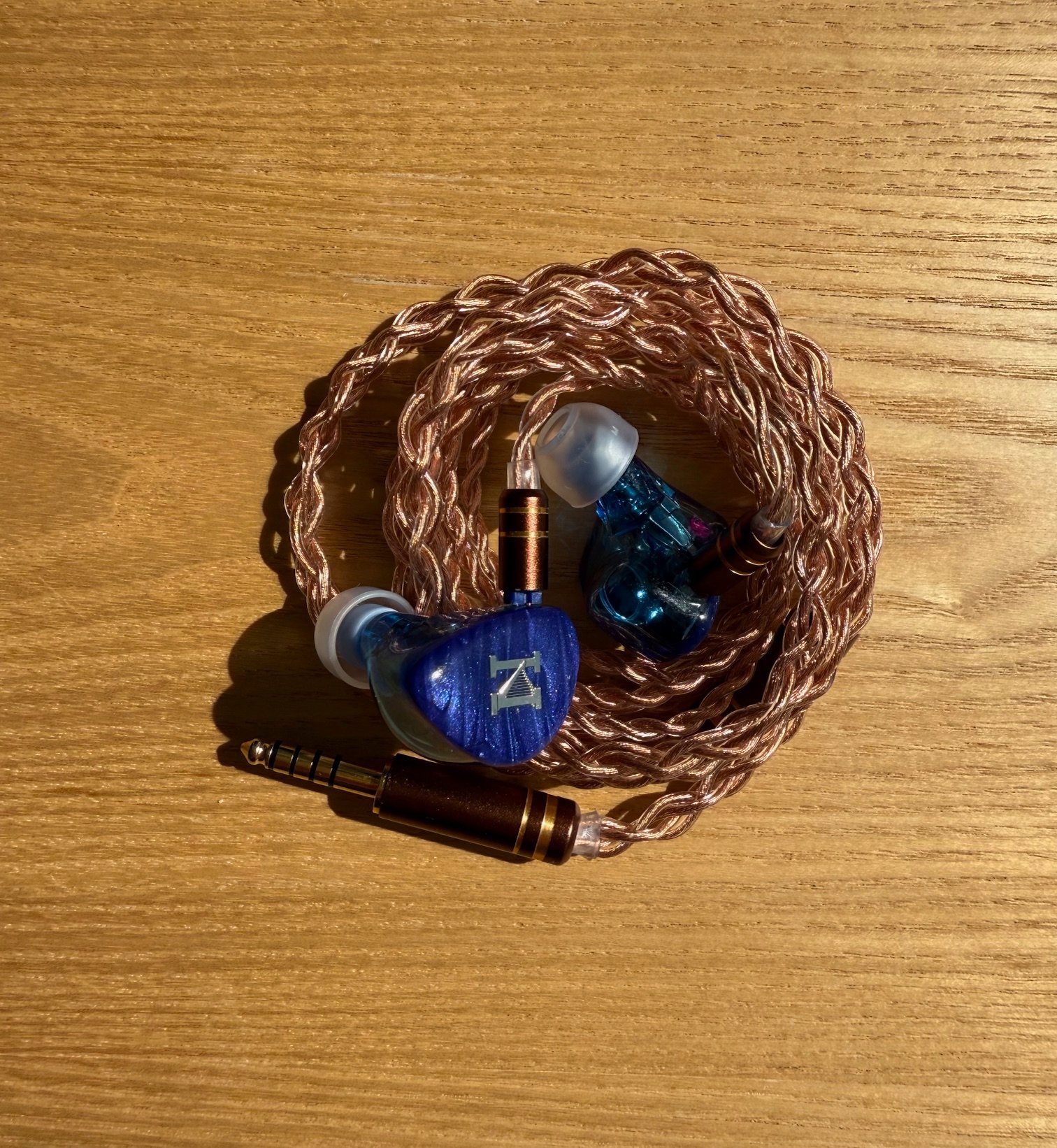
I’ve tried a few of Penon’s other offerings in the past such as Impact, Voltage & Quattro, which were a bit hit-and-miss, but it seems with the ISN-branded H60, Penon have a winner.
The packaging is MUCH better than the boring yellow box and cheap-feeling “pleather” case of every other Penon-branded IEM I’ve seen. Here, you get a nice blue box, decent carry case and a wide selection of tips. One thing Penon do always get right is the tips.

The stock cable is not particularly great, but then you do have to compromise at this price point. I have a preference for ear-hooks, which this cable doesn't have, making it just that bit more fiddly to use and keep the IEMs seated properly. The quality of the cable itself is average at best, I’d strongly recommend an upgrade here. For example, I had the Effect Audio Signature Series II cables around as part of another tour, and I thought that Ares S II at the very least was a sizable improvement over the stock cable. Yes that's another $199 for a cable on top of the moderately priced H60, but I think it's worth it.
The first thing I notice listening with H60 is it’s engaging warmth. This the kind of IEM when you hear it makes you “lean forward” into the music, and while it has a few flaws, it’s really quite a nice IEM to spend time with. Bass is probably the star of the show, the H60's DDs do a great job providing satisfying rumble that is a lot of fun. Midbass is just a little bit north of neutral, providing a pleasing warmth. After a while though, I do notice the upper mids and treble have a bit of harshness that starts to get fatiguing, like maybe after 45 minutes or so. I think this is probably due to a lack of coherence between the DD drivers down low, and the BA's in the higher frequencies. And while H60 does an admirable job resolving detail, you do get much better performance out of IEMs further up the price scale.
Vs Hidisz MP145
MP145 slams very well down low, however upper midrange is a bit recessed with vocals, especially female. MP145 treble extends pretty well, and you get a rather nicely detailed presentation. Stage feels tall with all that sub-bass, but not as proportionally wide or deep. H60 stage is not huge by comparison, but is more properly 3D and spherical in shape. One thing the MP145 does well is a more coherent presentation of the entire FR with it's single planar driver, vs the DD/BA hybrid H60. Almost a toss-up, but the H60 has a nose in front.
Vs Campfire Andro2020
Yes, the venerable Andro2020. H60 has much better bass depth and tactility with it's DD's, however Andro2020 is still a winner for stage size, especially width, which gives it a much more spacious and airy presentation. And while Andro bass quantity is well behind the H60, you do get much better resolution down low and all up the FR actually. The Andro2020 being all BA also has a cleaner sense of coherency than the H60. I guess it depends whether you value the tactility and timbre of H60s bass vs the more airy and sparkly Andro2020.
Vs Noble Spartacus
Spartacus bass quantity is not quite as much as with H60, but the quality is one or two orders of magnitude better. Spartacus also has more mid-bass that gives it a very lush, addictively engaging kind of sound. Detail up top is also significantly better on Spartacus, and stage width is larger in all 3 dimensions, which I think is the effect of its BCDs. Perhaps this is not really a fair comparison for H60 considering the price difference, but it does show that spending more $$ definitely does get you a better quality IEM imho.
I haven’t heard too many other IEMs around H60's price point recently, but it does seem like a very strong contender at $349. Yes, like many things in life you do get a better IEM if you spend more; but for where it sits in the market, I’d have zero hesitation recommending H60 sub-$500.

I’ve tried a few of Penon’s other offerings in the past such as Impact, Voltage & Quattro, which were a bit hit-and-miss, but it seems with the ISN-branded H60, Penon have a winner.
The packaging is MUCH better than the boring yellow box and cheap-feeling “pleather” case of every other Penon-branded IEM I’ve seen. Here, you get a nice blue box, decent carry case and a wide selection of tips. One thing Penon do always get right is the tips.

The stock cable is not particularly great, but then you do have to compromise at this price point. I have a preference for ear-hooks, which this cable doesn't have, making it just that bit more fiddly to use and keep the IEMs seated properly. The quality of the cable itself is average at best, I’d strongly recommend an upgrade here. For example, I had the Effect Audio Signature Series II cables around as part of another tour, and I thought that Ares S II at the very least was a sizable improvement over the stock cable. Yes that's another $199 for a cable on top of the moderately priced H60, but I think it's worth it.
The first thing I notice listening with H60 is it’s engaging warmth. This the kind of IEM when you hear it makes you “lean forward” into the music, and while it has a few flaws, it’s really quite a nice IEM to spend time with. Bass is probably the star of the show, the H60's DDs do a great job providing satisfying rumble that is a lot of fun. Midbass is just a little bit north of neutral, providing a pleasing warmth. After a while though, I do notice the upper mids and treble have a bit of harshness that starts to get fatiguing, like maybe after 45 minutes or so. I think this is probably due to a lack of coherence between the DD drivers down low, and the BA's in the higher frequencies. And while H60 does an admirable job resolving detail, you do get much better performance out of IEMs further up the price scale.
Vs Hidisz MP145
MP145 slams very well down low, however upper midrange is a bit recessed with vocals, especially female. MP145 treble extends pretty well, and you get a rather nicely detailed presentation. Stage feels tall with all that sub-bass, but not as proportionally wide or deep. H60 stage is not huge by comparison, but is more properly 3D and spherical in shape. One thing the MP145 does well is a more coherent presentation of the entire FR with it's single planar driver, vs the DD/BA hybrid H60. Almost a toss-up, but the H60 has a nose in front.
Vs Campfire Andro2020
Yes, the venerable Andro2020. H60 has much better bass depth and tactility with it's DD's, however Andro2020 is still a winner for stage size, especially width, which gives it a much more spacious and airy presentation. And while Andro bass quantity is well behind the H60, you do get much better resolution down low and all up the FR actually. The Andro2020 being all BA also has a cleaner sense of coherency than the H60. I guess it depends whether you value the tactility and timbre of H60s bass vs the more airy and sparkly Andro2020.
Vs Noble Spartacus
Spartacus bass quantity is not quite as much as with H60, but the quality is one or two orders of magnitude better. Spartacus also has more mid-bass that gives it a very lush, addictively engaging kind of sound. Detail up top is also significantly better on Spartacus, and stage width is larger in all 3 dimensions, which I think is the effect of its BCDs. Perhaps this is not really a fair comparison for H60 considering the price difference, but it does show that spending more $$ definitely does get you a better quality IEM imho.
I haven’t heard too many other IEMs around H60's price point recently, but it does seem like a very strong contender at $349. Yes, like many things in life you do get a better IEM if you spend more; but for where it sits in the market, I’d have zero hesitation recommending H60 sub-$500.
Attachments
Singaravelan
How does project M compare to this please?
ammagamma
New Head-Fier
Pros: + Organic, balanced and cohesive sound
+ 3D sound stage, high and wide
+ Super imaging and layering of instruments
+ Dense midrange with nice timbre
+ Vented shell with R/L channel marking
+ 3D sound stage, high and wide
+ Super imaging and layering of instruments
+ Dense midrange with nice timbre
+ Vented shell with R/L channel marking
Cons: - No modular connector :(
I had a pleasure of listening to H60 by ISN as part of the Audio Geek EU Tour. It's a subsidiary of Penon Audio and can be purchased from their official site.
Set is made from resin in very nice two shades of blue and a gold-colour cable provided compliments it very well. However I could not use the cable as it had fixed balanced connector, so was using Ziigaat Estrella’s cable instead.
Its a very musical IEM with amazing dynamics that caught my attention right off the bat while listening to “Walk on By” from Isaac Hayes album Hot Buttered Soul. The amazing orchestration parts on the song grows to a climatic crescendos, yet the sound never loses the resolution or detail.
Bass
There's plenty of impact in the bass department, a lot of air is being pushed, nice slam form the kick drum but it lacks a bit of definition or texture in the lowest region as evident on “Dancing Queen” from Mamma Mia’s exceptionally well produced OST (nice, very dynamic master). I would like to hear a bit more weight in the sub-bass. So I guess you can say the set is more tuned towards mid- or upper-bass. Don’t get me wrong, there's is a lot of sub-bass there when needed, just not as well defined altough it would probably sound better with more decent amplification than what i have been using (Meridain Explorer 2 DAC).
Mids
Midrange has an amazing "dense" texture and is very sweet and lush (but not as much as Penon Voltage) which makes the keyboard parts sound exceptionally tasty, like for example in “Winter Wine” by Caravan. Female vocals are clear, intimate and nuanced as on “Wuthering Heights” by Kate Bush, while male vocals have nice timbre and tone as in “Streets of Philadelphia” by Bruce Springsteen.
At times upper midrange and treble seemed slightly recessed (some electric guitar solos) but it’s hard to judge these things as they often depend very much on how particular records were mixed and mastered.
Treble
Treble is nicely extended, crisp and sparkly. I love how the hi-hat action is rendered on “Three of a perfect pair” by King Crimson, it really kept my ears glued to Bill Brufford’s drumming throughout the song.
Listening to keys solo on “Africa” by Toto I think there might be a bit of spike in treble, around 7kHz region or so.
Technicalities
H60 delivers amazing dynamics and attack from brass section on aforementioned “Walk on By” and other tracks. Percussion and brass sounded also really nice and smooth on Santana's Supernatural album. Imaging and layering of instruments is superb as well, creating sense of height and width in the soundstage with 3D-chamber feel as clearly portrayed on the songs like “Night by Night” by Steely Dan or “Sunlight” by Herbie Hancock. It can be very subtle and nuanced where needed as for example in the gentle ebb and flow of brass section in Bill Whiters’ excellent “Lovely Day”, which we used to play on my music course but only now I’ve finally got that drum part correctly
Conclusion
To conclude I will say that H60 is a very musical, organic and cohesive sounding set with amazing dynamics and great technicalities. It provides a lot of details and is very musical at the same time. It's the sound I could easily settle for in this price range.



Set is made from resin in very nice two shades of blue and a gold-colour cable provided compliments it very well. However I could not use the cable as it had fixed balanced connector, so was using Ziigaat Estrella’s cable instead.
Its a very musical IEM with amazing dynamics that caught my attention right off the bat while listening to “Walk on By” from Isaac Hayes album Hot Buttered Soul. The amazing orchestration parts on the song grows to a climatic crescendos, yet the sound never loses the resolution or detail.
Bass
There's plenty of impact in the bass department, a lot of air is being pushed, nice slam form the kick drum but it lacks a bit of definition or texture in the lowest region as evident on “Dancing Queen” from Mamma Mia’s exceptionally well produced OST (nice, very dynamic master). I would like to hear a bit more weight in the sub-bass. So I guess you can say the set is more tuned towards mid- or upper-bass. Don’t get me wrong, there's is a lot of sub-bass there when needed, just not as well defined altough it would probably sound better with more decent amplification than what i have been using (Meridain Explorer 2 DAC).
Mids
Midrange has an amazing "dense" texture and is very sweet and lush (but not as much as Penon Voltage) which makes the keyboard parts sound exceptionally tasty, like for example in “Winter Wine” by Caravan. Female vocals are clear, intimate and nuanced as on “Wuthering Heights” by Kate Bush, while male vocals have nice timbre and tone as in “Streets of Philadelphia” by Bruce Springsteen.
At times upper midrange and treble seemed slightly recessed (some electric guitar solos) but it’s hard to judge these things as they often depend very much on how particular records were mixed and mastered.
Treble
Treble is nicely extended, crisp and sparkly. I love how the hi-hat action is rendered on “Three of a perfect pair” by King Crimson, it really kept my ears glued to Bill Brufford’s drumming throughout the song.
Listening to keys solo on “Africa” by Toto I think there might be a bit of spike in treble, around 7kHz region or so.
Technicalities
H60 delivers amazing dynamics and attack from brass section on aforementioned “Walk on By” and other tracks. Percussion and brass sounded also really nice and smooth on Santana's Supernatural album. Imaging and layering of instruments is superb as well, creating sense of height and width in the soundstage with 3D-chamber feel as clearly portrayed on the songs like “Night by Night” by Steely Dan or “Sunlight” by Herbie Hancock. It can be very subtle and nuanced where needed as for example in the gentle ebb and flow of brass section in Bill Whiters’ excellent “Lovely Day”, which we used to play on my music course but only now I’ve finally got that drum part correctly

Conclusion
To conclude I will say that H60 is a very musical, organic and cohesive sounding set with amazing dynamics and great technicalities. It provides a lot of details and is very musical at the same time. It's the sound I could easily settle for in this price range.



Last edited:
PeacockObscura
Headphoneus Supremus
Pros: 1. Premium build
2. Natural timbre
3. HOLOGRAPHIC staging
4. cohesive sound signature
5. Hybrid configuration
6. Balanced tuning
2. Natural timbre
3. HOLOGRAPHIC staging
4. cohesive sound signature
5. Hybrid configuration
6. Balanced tuning
Cons: 1. Needs A good copper cable to bring out the best.
2. Might be a bit bright for nuetral sources
2. Might be a bit bright for nuetral sources

Being a reviewer of sorts I try to give my subjective opinions on iems, in the hobby at the moment 95% of iems released at the moment are good a solid 4 stars in their price segment so the differences between great iems and good iems is all about the nuances. All reviews are based on a single point in time for the reviewer next week an iem can come along and make a mockery of your previous judgement. So why this introduction? The ISN H60 is an iem that had made me hit reset its ability to project a 3D holographic staging is beyond anything I've experienced before. So much so I'd like to give it a 5 Star+ designation.
The iems are a typical understated blue resin shell not unlike any number of ISN previous releases this is a good thing as they fit my ears like a glove.

The H60 is an hybrid 2DD + 2 Knowles BA and 2 Sonion ba's I had to check the configuration a couple of times as I was convinced they must have a Bone Conduction driver somewhere in there that gives that aforementioned holographic presentation. Unlike many ISN iems this is not a bass dominant iem sure the bass is there but the emphasis is on quality not quantity, they are not bass shy rather extremely well balanced the bass is quick snappy with decent sub bass rumble the magic is the texture layering and detail in that bass.
So what have ISN brought to the iem market that's any different to the countless other hybrid iems released this year?
Well a unique sound signature for one thing this iem is different, the H60 doesn't conform to the standard sound signatures that their rivals are pumping out. The H60 has more air, more positional cues, more resoluion a signature where no frequency level pushes forward to draw your attention it just presents music effortlessly with details and strong dynamics.
The H60 is an exciting iem it instantly grabs your attention, it opens up the most densely produced music giving space around instrumets, you can appreciate the playing of the individual musicians while still appreciating the music as a whole. I can't oversate the wonder as the music dances around outside your head. I found myself losing hours at a time just enjoying the music as if I was in the same environment as the musicians.
The bass quailty with texture and details and is available when the music calls for it never adding extra colouration to the mids. The quantity is at the level of slightly boosted from natural but still impressive. My preferences are for big strident bass with strong dynamics and deep rumble. The ISN H60 bass is less in quantity than I usually enjoy (I'm a basshead) here its quality more than makes up for the slight dip in quantity. Dont think that its light in bass it isnt, its just not the main player.
The mids are smooth, extremely airy, not thin they have good body and very natural timbre, class leading details and a major strong suit the Vocals are wonderfully natural both male and female sounding on point neither recessed nor forward, perfectly positioned centre stage. Instruments are layered with pin point accuracy.
Treble is extended with amazing details and good air as I noted earlier this iem just plays music as an holographic cohesive whole no part standing out from the rest. What you get is every part of the frequency range opened up to reveal details lesser iems dont. There's zero unnatural timbre from the ba's. The overall timbre is supremely natural with no fatiguing peaks or obvious defects. Not something I have experienced at this price point infact not at any price point, I think you would have to spend 4 times more to achieve this level of nuanced tuning.
Here's the frequency graph for those that like this sort of thing

I'd just like to say upfront I believe we are all biased when giving our subjective thoughts about IEMs and earbuds be it a particular type of signature that works with our music library or how they look and feel in our ears. On the subject of ears everyone's ear anatomy is different and this effects fit and seal which in turn effects the perception of bass response so I recommend finding the right ear tips or foams that suit your ears to get the best of any earphone.
My review star ratings are linked to the price range of the iem eg a 5 star review of a $100 iem is not equal to one of a $500 iem.
I’m and audio enthusiast with a collection of over 250 iems, 30 different sources with a music collection that numbers over 100,000 tracks and 18 flathead buds I share my impressions as a way to share my enthusiasm for the hobby I approach from the premise of music first technology 2nd, what does this mean? For me the technicalities are not of prime importance but does the music move with this particular iem.

I’m a connoisseur of many different sound signatures. The only prerequisite is musicality I’m not a fan of analytical cold playback. My scale of success when it comes to evaluating earphones is; do I get goosebumps when they playback my favourite tunes. There are many good earphones but do they give me goosebumps? Unfortunately I have a draw full of just good earphones.
I want the earphone that I reach for without thinking because I instinctively know it will bring the thrill I’m seeking from my music.
The H60 comes with a nice quality 2pin copper cable termination is 4.4mm or 3.5mm chosen at time of order the cable is OK but changing it to the Penon OCC849 improved the overall sound giving a touch of warmth. There's a nice pocketable case and a selection of eartips , unfortunately for me due to my giant ear canals they aren't suitable for so I used XL white final e type tips I found Divinus Velvets were also a good match.

Now I know there are those who don’t believe in burn in of earphones, all I’m going to say is, I burn in all my earphones the H60 bass really opened and up at the 50 hour mark.
Disclaimer
ISN was kind enough send me a sample of the H60. I am not affiliated with ISN and of course was not asked for any copy checking before publishing, they are seeing this the same time as you. All pictures taken be me or sourced from the Penon website . ALL opinions shared in this review are my subjective thoughts.
Make sure to research any earphone before you buy!
The ISN H60 is available from the Penon website,
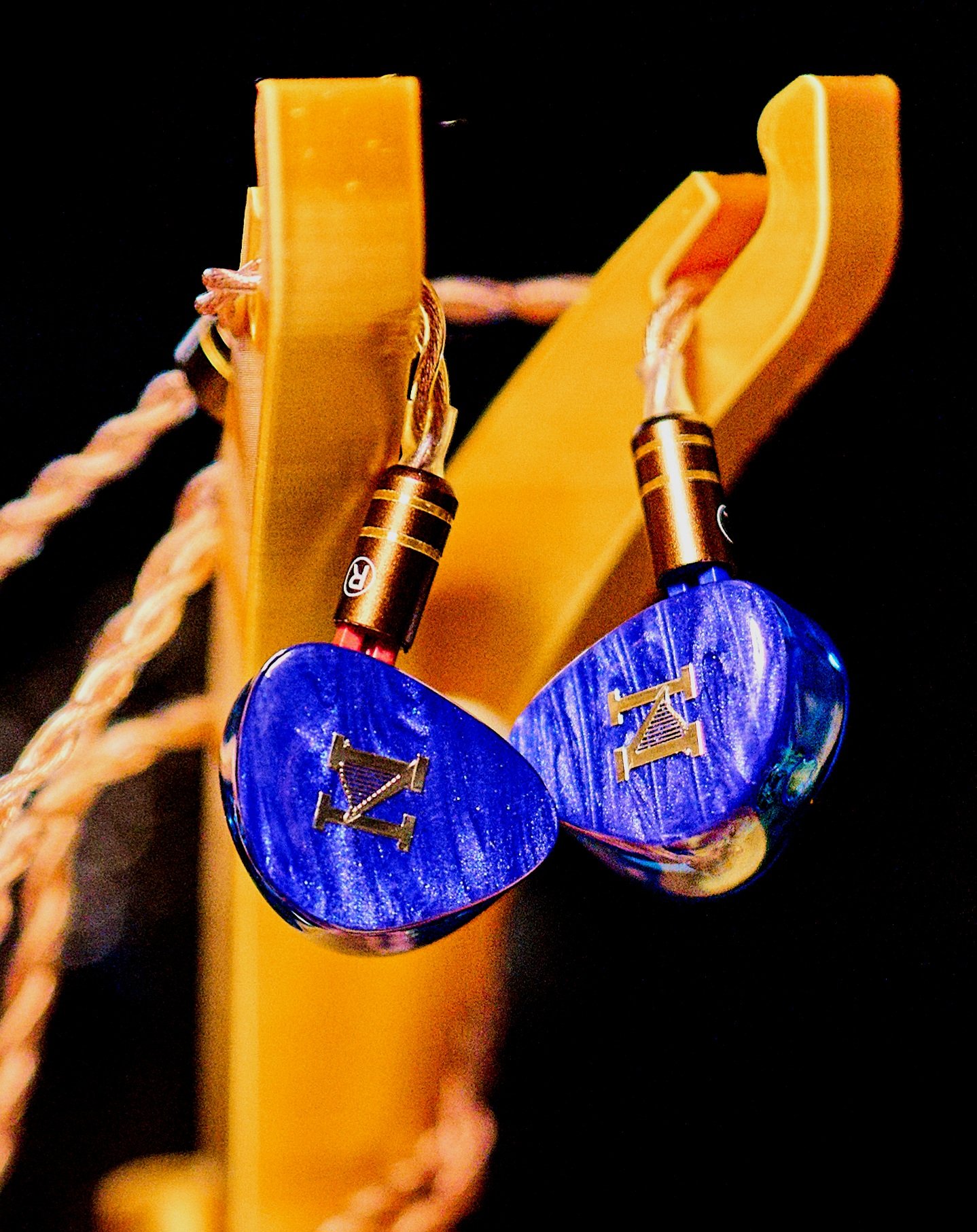
see the non affiliated link below
https://penonaudio.com/ISN-Audio-H60.html
Description
ISN Audio H60 4BA + 2 Dynamic Driver Hybrid
2Pin 0.78mm HiFi Earphone Audiophile IEMS
Brand:ISN AUDIO Model:H60
Handmade,durable and solidMedical grade resin material, light and comfortable to wear
4 Balanced Armature + 2 Dynamic driver hybrid
2 x Knowles Balanced Armature for high frequency
2 x Sonion Balanced Armature for middle frequency
2 x 8mm liquid silicone gel diaphragm for low frequency
3-way crossoverImpedance: 18ohm ± 10% Sensitivity: 112 @ 1KHZ
Frequency response: 5Hz-40kHzPlug:
Gold-plated Cable length: 1.2M
Package ISN H60 earphone
Warranty18 months warranty
I want to really enjoy my music. Something that releases the full scope of what the artist created in the studio. The H60 achieves that with cohesion ensuring to there’s no jarring transitions between the frequency range. The H60 has a natural slightly elevated bass signature, its not thin though it has an very open detailed signature bass is textured and layered. The mids are free of colouration with no extra colour in the vocals male vocals and female are realistic and sweet with a natural timbre. The vocals are front and centre with instruments placed exactly where they should be showing depth to the stage with natural wide holographic presentation . The H60's double dynamic drivers with Knowles and Sonion BA drivers sound very coherent no trace of uneven timbre just everything working together as one.
The mids are natural and organic, with no edge there's added excitement to vocals and guitars I was drawn into the music, Pianos and Guitars are given a really even treatment with good note weight sounding exactly as you would expect if you were in a concert hall or studio.
The Transition from upper mids to lower treble is smooth as butter and sibilance free, even with songs that have sibilance bult into the recording.
The timbre and tactility of drums, strings, guitars and brass instruments is very natural all instruments find their own place. Vocals both male and female are reproduced authentically with emotion, every inflection, intonation is apparent as a singer climbs the scale to the crescendo it is presented well with nice separation, if a voice has gravel you hear it vocals have a very pleasing weight coming across very natural the H60 is highly detailed and not very forgiving of poorly produced music.

When I'm evaluating earphones I have a play list of roughly 100 songs of mixed genres. With the H60 I was analysing the different frequency ranges listening to albums in their entirety just loosing myself in the music. I found they I worked across all the genres in my library with including Hip hop where the bass is sufficient enough for the big bass drops always sounding smooth, spacious and detailed .

Michael Bolton - When a man loves a woman
Sounded wonderfully full and clean with the crisp drums and full bodied of guitars Bolton's magical tenor vocals sounding full and sweet with no thinness the layering in this 80s classic AOR song was produced with expert precision full of atmospherics a really enjoyable listen
Alanis Morissette: You Oughta know ,
the angst ridden vocal is fabulous with just enough weight to draw you in slowly building with emotion the vocal acrobatics are surrounded with the instrumentation. The staging is brilliantly reproduced increasing the atmospherics greatly. The H60 works incredibly well with studio and live recordings putting you front and centre in the room with the artist surounded by the instrumets

Steely Dan's – Black Cow, one of the best produced albums in my opinion was played with a breathtaking expertise at this price range, drums, keyboards, vocals , hi-hats and cymbals were natural with excellent decay space and staging with good height, depth and width enabling me to pick out instruments in the mix, this song felt open and airy with the layering of the instruments expertly presented
Peter Gabriel- Solsbury hill the way the H60 played back this song was a real goosebumps moment Gabriel's vocals were wonderfully separated allowing me to fully appreciate his fabulous voice the strum of the guitars separated from the complex percussion the individual parts of the song floating in the mix separate but together in a cohesive whole. The H60 manages to keep production in control sounding immersiive avoiding any congestion, impressive.
Earth Wind and Fire – Fantasy
This Funky masterpiece with its magnificent horns funky bass lines and outstanding vocals is played with effortless ease the holographic staging really drawing me into the music. This description from Wikipedia perfectly sums up the experience of listening with the H60 "Voices and a light touch of strings suddenly appear over a choppy, propulsive track, swell and swoop, only to disappear at the snap of a finger and pop up moments later for an exciting, powerful finale. White also utilizes an odd instrumental mix that gives equal emphasis to percussion (except the bass drum, which is usually played down), bass, rhythm guitars and stabbing, staccato horn bursts. The result is light but substantial" simply a stunning track played back with impressive skill and finesse.
DIRE STRAIGHT: PRIVATE INVESTIGATIONS
The H60 was made for listening to this classic atmosphere song with its sprinkling of multi-layered instrumentation and sound effects every pluck of the string ringing out in perfection Mark Knophlers half whisper vocals breathing in your ear the impactful drums with awesome transients fading into the mix every footstep making you check the room. There's a part of the song about two thirds of the way through when a cat calls followed by breaking glass I swear the H60 shows more detail of the shards crashing to floor of any iem i have in my 250 iem collection. Breathtaking
The H60 is reasonably easy to drive I had no issues using them with my , Daps, Dongles in getting loud enough, the dynamics and open sound was present with all sources the texture and layering they are capable of was available for all to some degree. The H60 let's the signature of the source shine in the way only a truly transparent iem can do this which can make the treble a little too much with really nuetral sources like the Astell&Kern Activo P1. The H60 when using a warmer source like the Sony NW-WM1Z or Shanling M6Ultra really shines
They sounded good with all sources. This is an iem that doesn’t need a powerful source but it does scale impressively.
I'm not a fan of analytical sounding IEMs that force details into your ears like a photograph with HDR and sharpening set at max a decidedly digital representation. I'm more Vinyl on a turntable, Leica manual focus, sumptuous colours on kodak colour gold film, kinda guy, where if you look really close all the details are there but it's the whole image you appreciate rather than just how sharp it is.the H60's secret sauce to present all the details without any sharpness or fatigue

Sources used:
Onix XM5 Overture
Shaning M6 Ultra
Sony NW-WM1Z
Fiio Jm21
Fiio BTR17
Aune M1P
Cayin N7
KAEI TAP1 with Burson v7 OP AMPs

My Favourite sources was without doubt the Cayin N7, Onix XM5 Overture and Sony NW-WM1Z the H60 is in my opinion without doubt the most transparent holographic natural sounding earphone in my collection even outperforming my more expensive iems in its staging capabilities with its unique talents. The H60 definitely suits a warmer source as mentioned above.
I also really enjoyed the H60 with the Fiio BTR17 out and about streaming from my Samsung Galaxy S24Ultra using LDAC.
The medium sized shells were very comfortable and I used them for over 8hours without break and had zero fatigue issues.
Cable rolling

I'm a cable believer but if you are not then skip this bit. While the ISN H60 comes with a decent 4.4mm or 3.5mm cable I wanted to try them out with pure copper cable.
The results of my experiments led me to the believe that the H60 enjoys an elevation is sound quality.
When I paired with Penon OCC849 COPPER CABLE one of my favourite copper cables the bass became richer and fuller a touch of warmth was perceived in the mids while the treble remained sparkling and detailed the special power of this cable is that it adds a depth and warmth to the bass and mids without any form of bloat or veiling
Penon OCC849 (penonaudio.com)
Penon OCC849 Single Crystal Copper
HiFi Audiophile IEMs CableType-4 Litz configuration
Description6n single crystal copper cable8 strands, single strand is 49 cores, a total of 8 × 49.
The plug contains 68% copperThe solder joints is silver – contained tinCarbon fiber metal splitter and CNC integrated sliderCable
length: 1.2M
OS849
An equally beautiful cable the OS849 is a silver plated copper cable while this cable also boosted the bass is wasn't quite as warm plus that silver coating did its job too well for my tastes the treble was a little too prominent. I stuck with the OCC849
Penon OS849 (penonaudio.com)
Penon OS849 Single Crystal Copper Silver-plated HiFi Audiophile IEMs Cable
Type-4 Litz configuration Description6n single crystal copper silver-plated cable
Contained 8% silver, the thickness is 10μm,8 strands, single strand is 49 cores, a total of 8 × 49.
The plug contains 68% copperThe solder joints is silver –contained tinCarbon fiber metal splitter and CNC integrated slider
Sound field is very big and very natural
Cable length 1.2m
Comparison
This is quite difficult as the H60 is so unique in sound signature. With this in mind I'm going to compare with similar priced iem.

Dita Audio Project M
The Project M has 1 dd + 1ba and retails around the same price the quickest comparison remarks are the H60 Annihilates it, in bass detail, texture and quantity when it comes to the mids they have a similar timbre but the H60 is taller, deeper, wider and more accurate positioning of instruments making it easier to track instruments across the stage.
Treble on the Dita is very detailed but a little thin and fatiguing over longer sessions while the H60 has more air and greater resolution the notes are rounder less harsh, therefore not fatiguing
When comparing the sonic signatures overall H60's blend of low, mids and high are smoother seemingly with out any dips or peaks to signal transitions. The Project M is a great iem and one of the best in its price bracket of 2024 it's just not as holographic or engaging as the H60.

Conclusion
The ISN H60 sounds like it's been tuned just for me, hitting all my targets it has been a revelation giving me goosebumps on multiple occasions. My mainly Classic Rock and Pop of the 70s,80,and 90s sounded fresh, involving and on many an occasion like I was listening to them for the first time. I enjoyed using them with my DAP collection to taste the different signatures they present. If I was looking for just one iem to just plug and foget the hobby the H60 would be the one. Well till next week when another amazing iem is released and I jump further down the rabbit hole. Music as its meant to be heard an absolute recommendation from me!

Attachments
jbfps116
I fully agree with your description of the sound. Holograph especially in the mids, without a BC driver. Fantastic! The nozzles are almost too wide for comfort though… have to use small ear tips when I normally use mediums.
PeacockObscura
@jbfps116 my ear canals are huge I really need 15mm tips to get a secure fit with any iem so I don't have issue with nozzle size on any iem. I'm lucky that way sort of. Can't get a sure iem to fit ever with their needle nozzles lol
ICYGENIUS
Head-Fier
Pros: Very balanced and competent tuning
Versatile sound for absolutely any musical genre
Emotional and intense presentation
Tonal accuracy natural and balanced sound without unnecessary accents
Amazing technicality and analytics
The bass attack is very fast
The sub bass is very deep and detailed
Mid bass is punchy and extremely textural
Transients are the real trump card of this set
The midrange is very airy and exciting
The upper midrange area is very neat in its presentation
The treble is truly audiophile-grade and insanely detailed on micro nuances
The airiness and openness in the treble region is really surprising
The soundstage is very detailed, and literally perfect in all directions, width,depth,height
The separation and localization of the instruments is awesome
Versatile sound for absolutely any musical genre
Emotional and intense presentation
Tonal accuracy natural and balanced sound without unnecessary accents
Amazing technicality and analytics
The bass attack is very fast
The sub bass is very deep and detailed
Mid bass is punchy and extremely textural
Transients are the real trump card of this set
The midrange is very airy and exciting
The upper midrange area is very neat in its presentation
The treble is truly audiophile-grade and insanely detailed on micro nuances
The airiness and openness in the treble region is really surprising
The soundstage is very detailed, and literally perfect in all directions, width,depth,height
The separation and localization of the instruments is awesome
Cons: Nope, and I think it's the best choice at the moment with this kind of sound delivery
- Introduction -
Hi friends, today in the review we're going to take a look at a gorgeous $349 hybrid headphone from ISN AUDIO.
And they come in a small blue reflective box here there is a company logo.
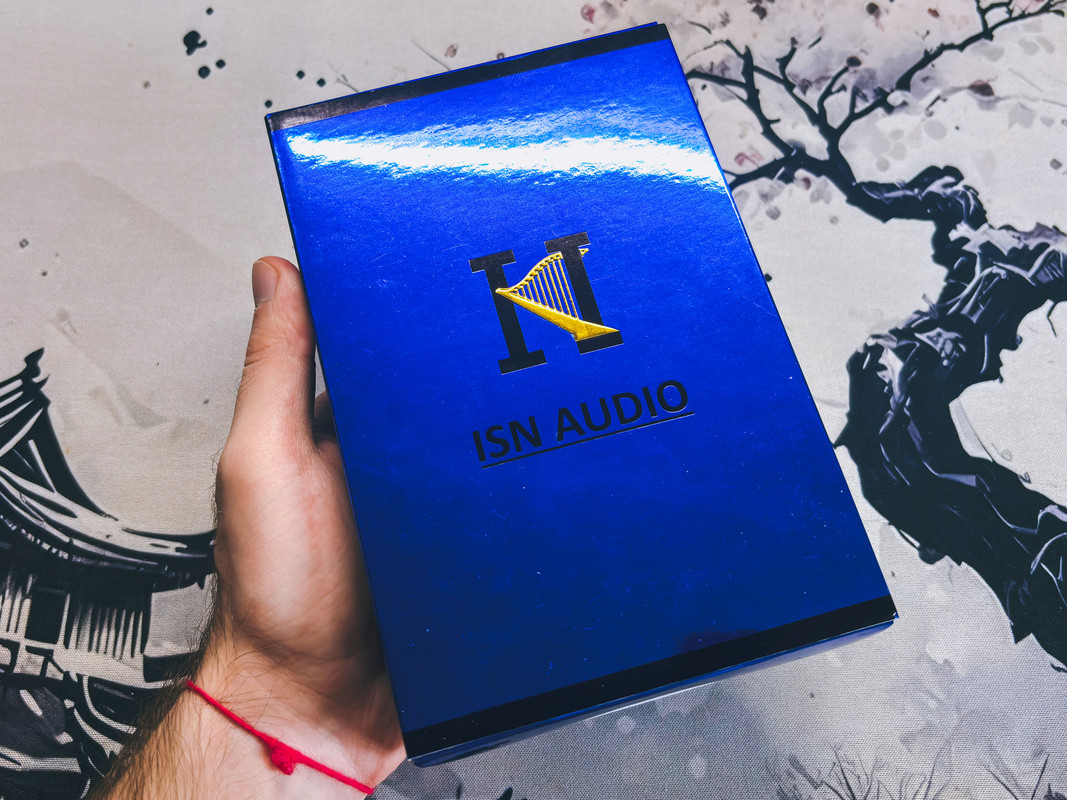
And on the side there is a marking with the selected cable plug, in my case it's a 4.4 jack.
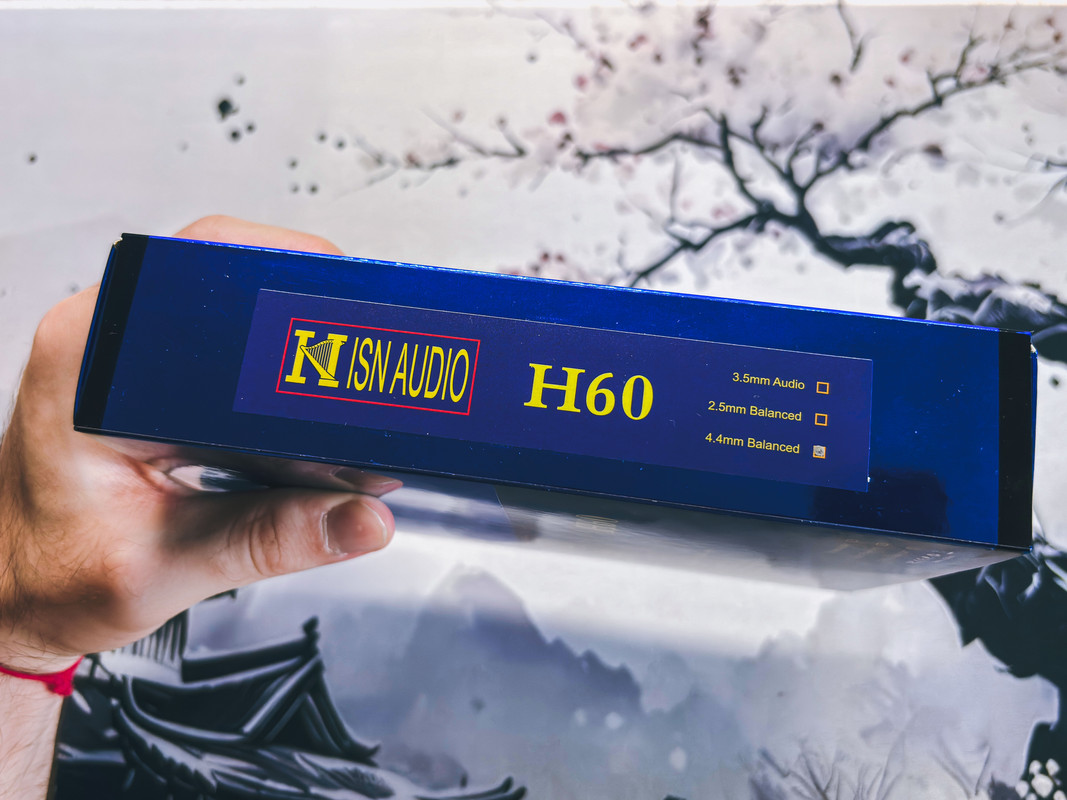
And at the back are specified technical specifications and for the sound in these headphones is responsible for two dynamic drivers, and 4 armature drivers two of which are from Sonion is responsible for the middle frequencies, and two from Knowles to reproduce the high frequencies, the sensitivity is 112 dB and they received an impedance of 18 ohm, and to drive these headphones are quite light.
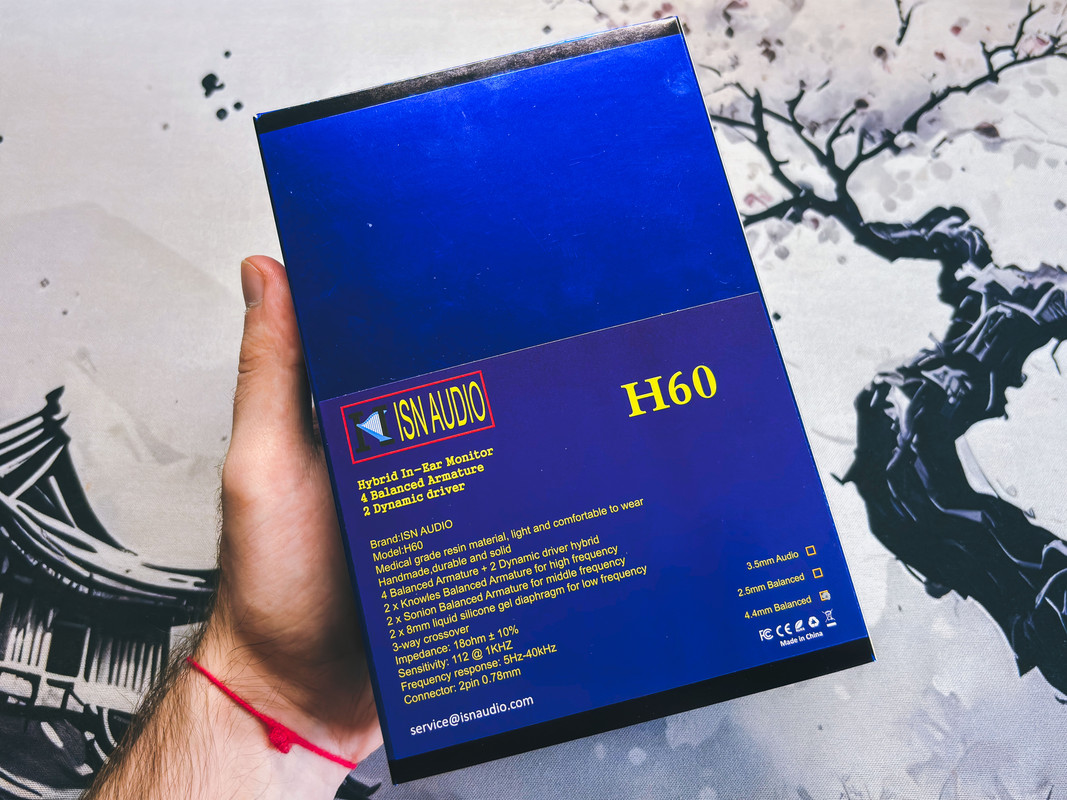
- Let's take a look at what's included -
1.Branded case.
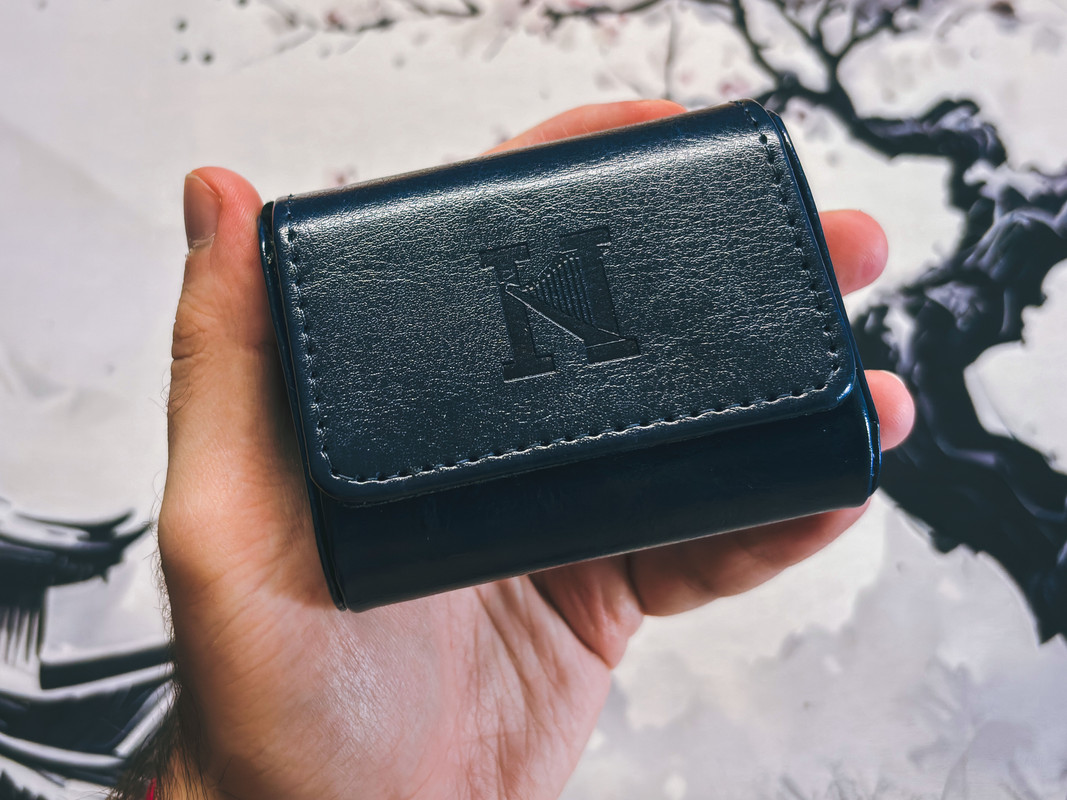
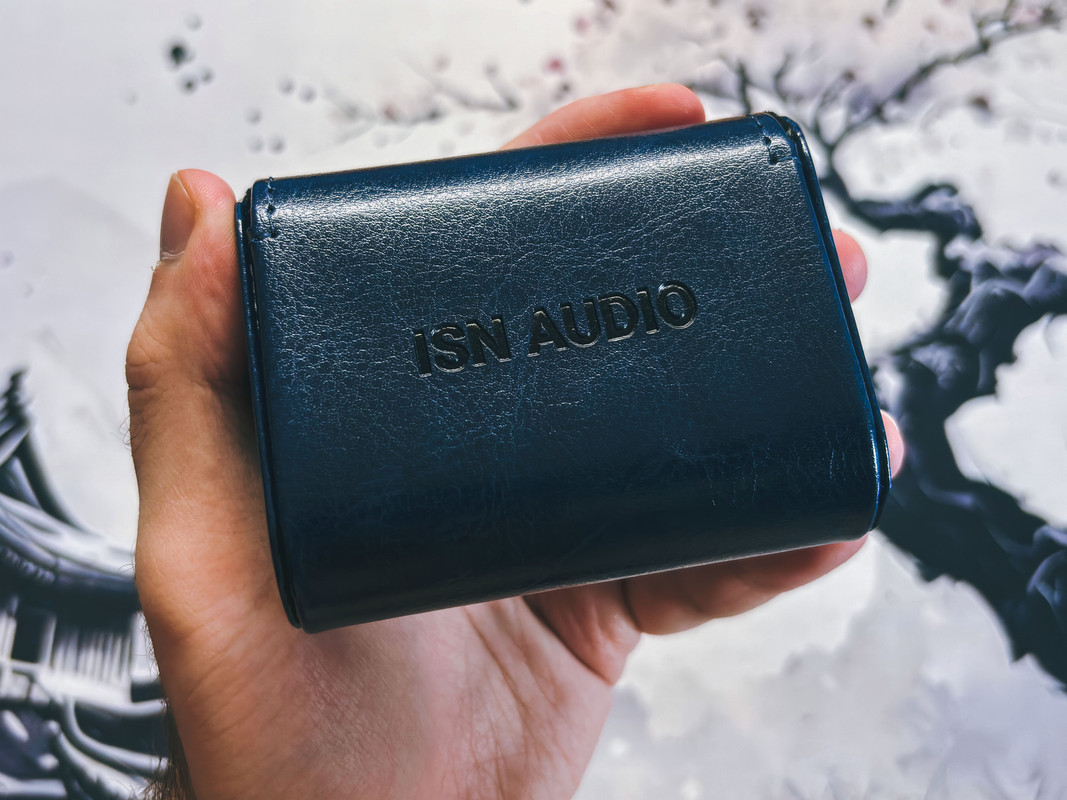
2.Eartips.
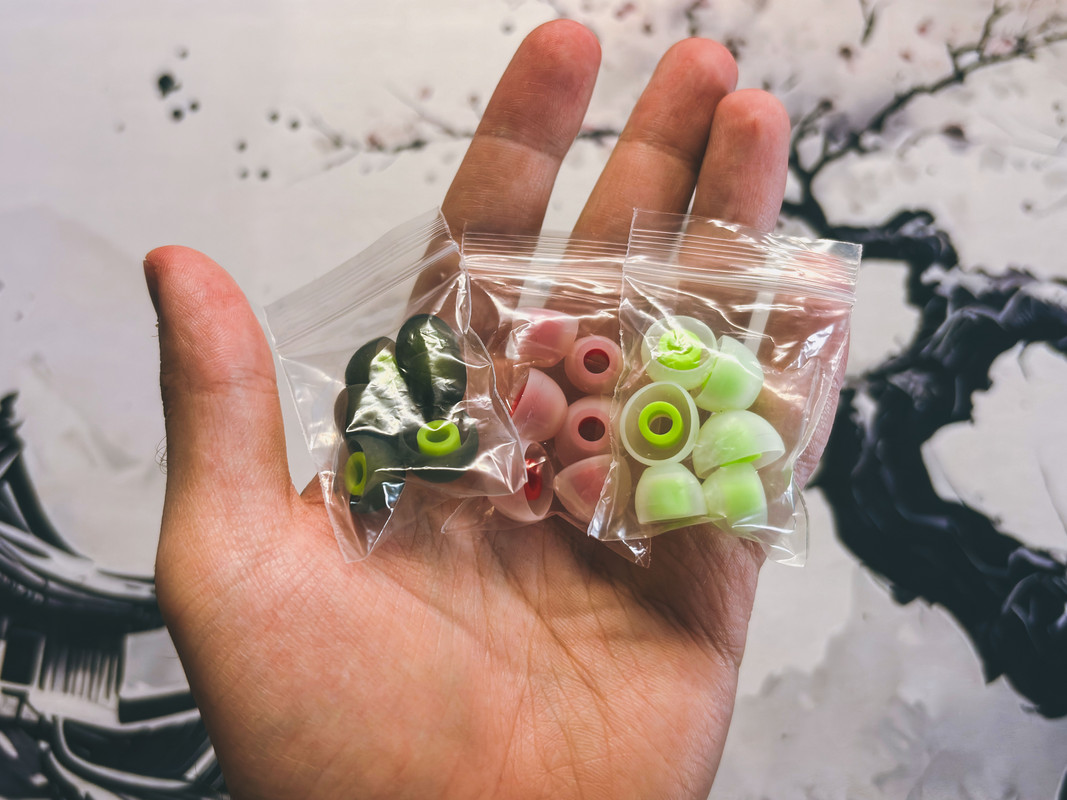
3.High quality copper audio cable with 4.4 jack and 2 pin connectors.
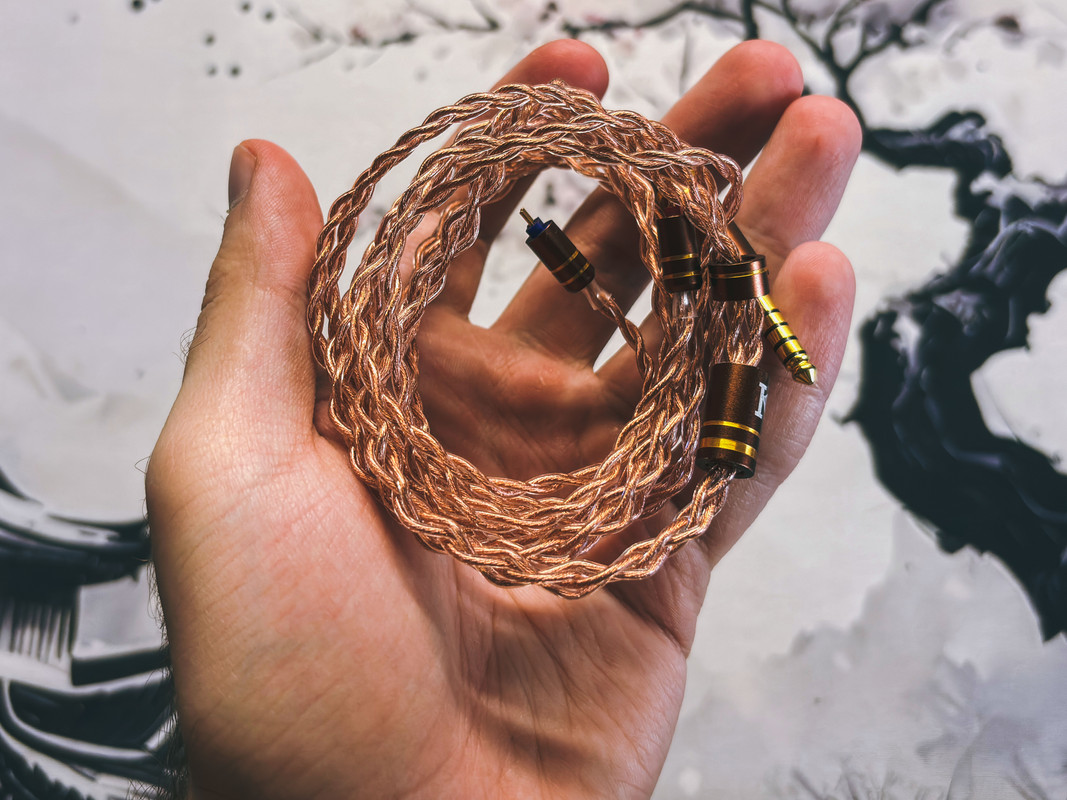
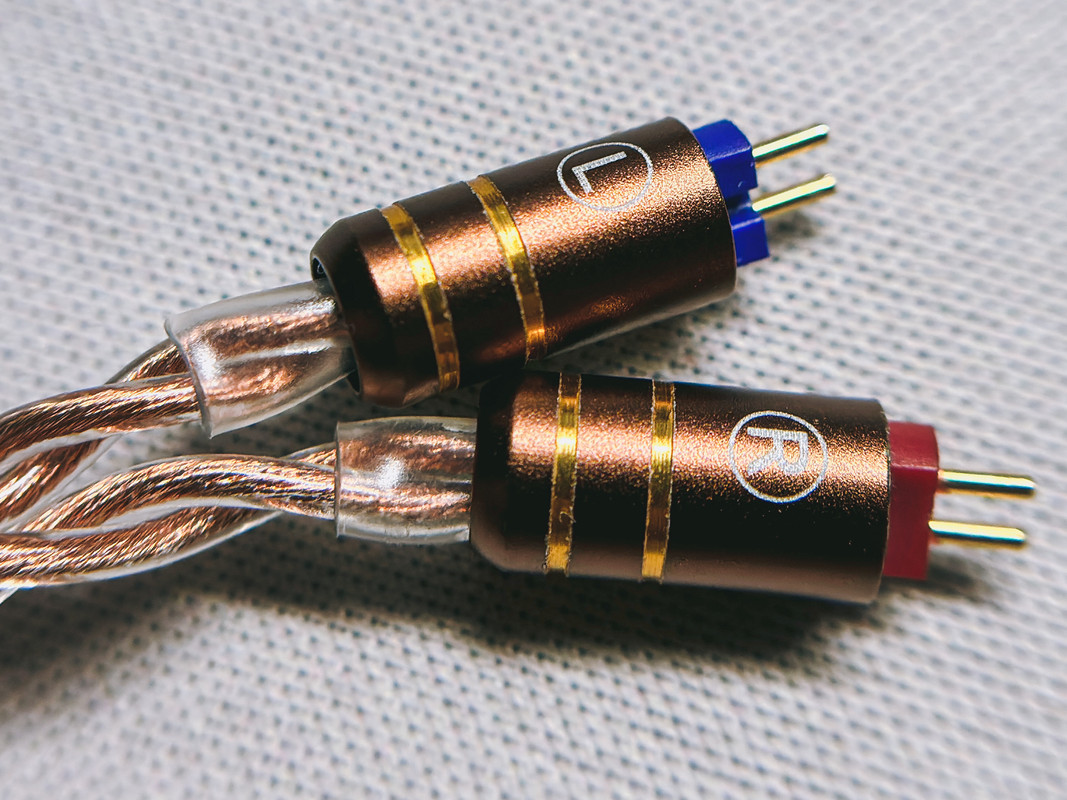
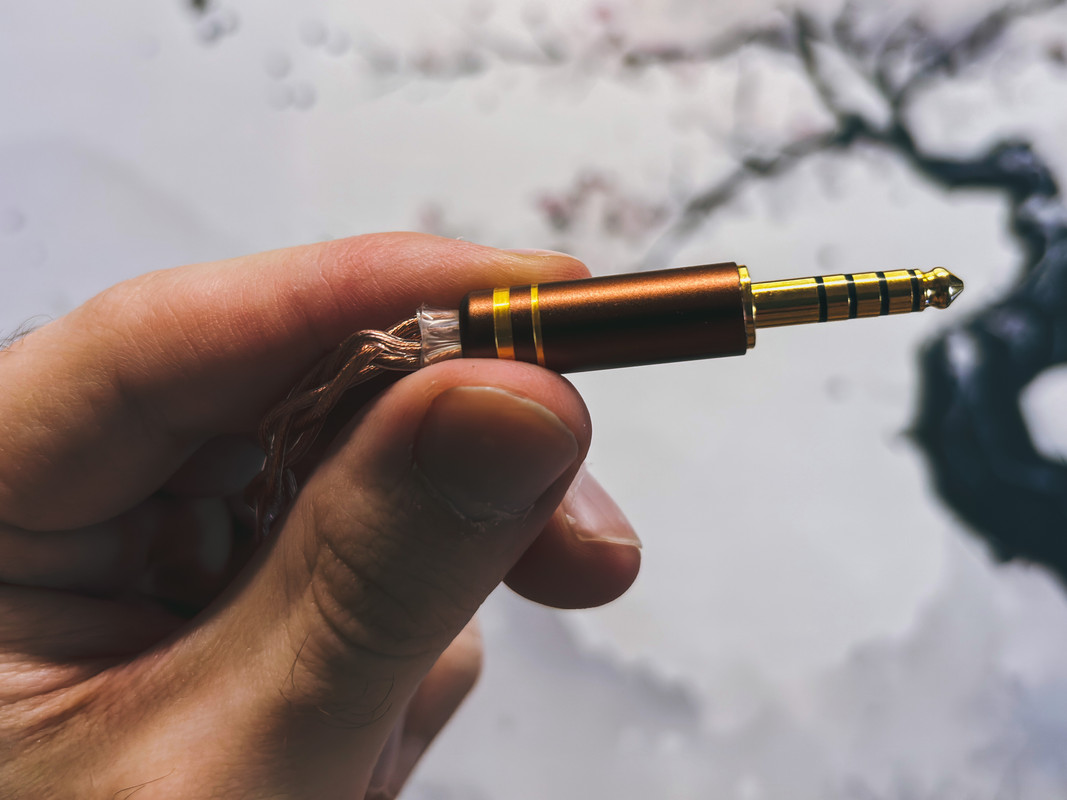
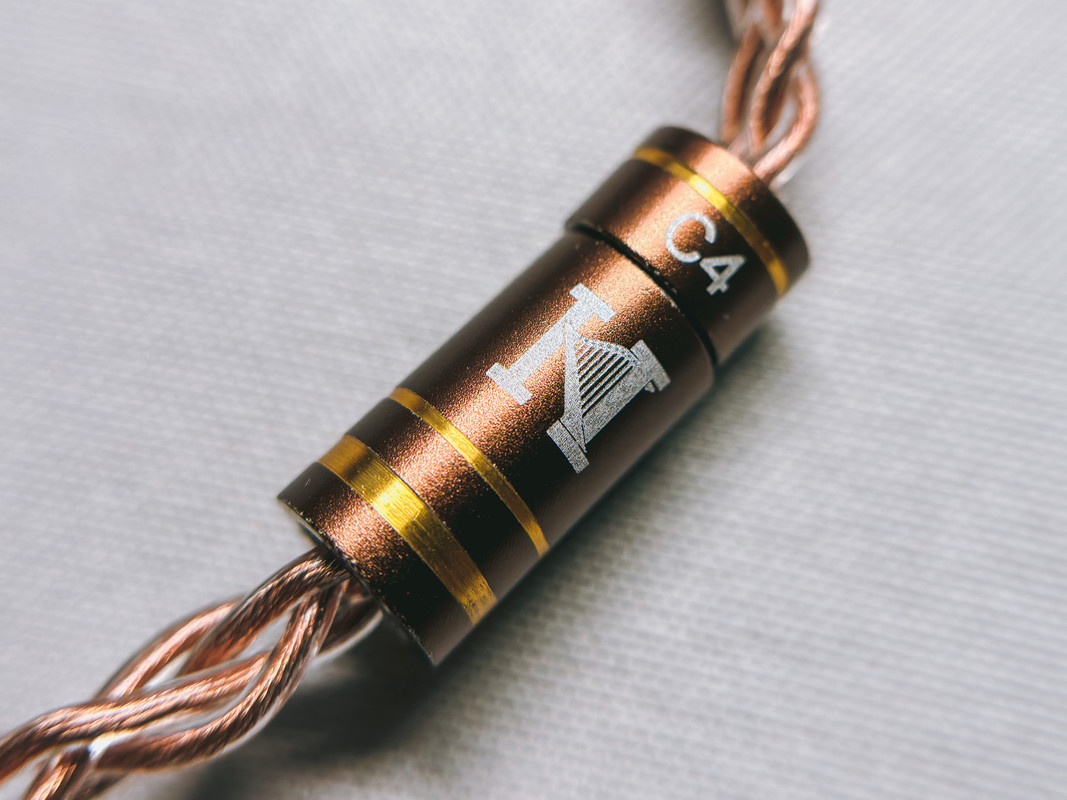
4.Cleaning brush.
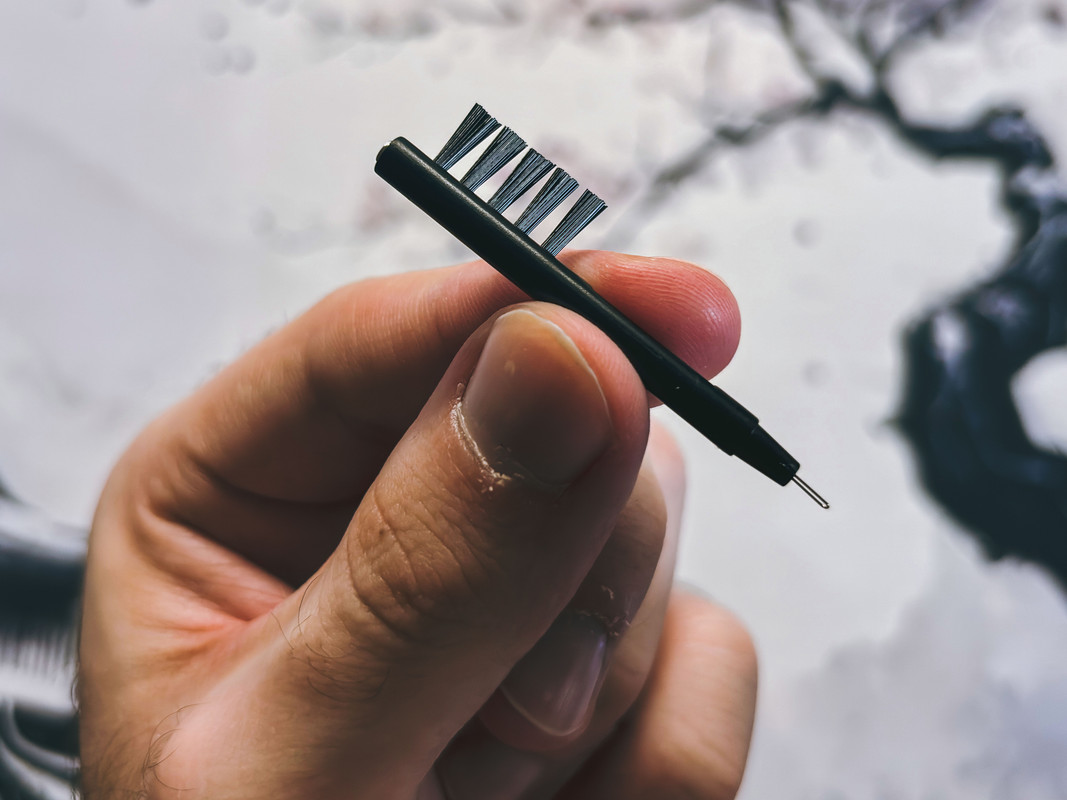
5.Clip.

6.IEM.
The headphones are very large and made entirely of medical grade resin with a beautiful translucent blue design on the inside, while the front panel here is dark blue and already with a striped design and a large gold company logo on both headphones.
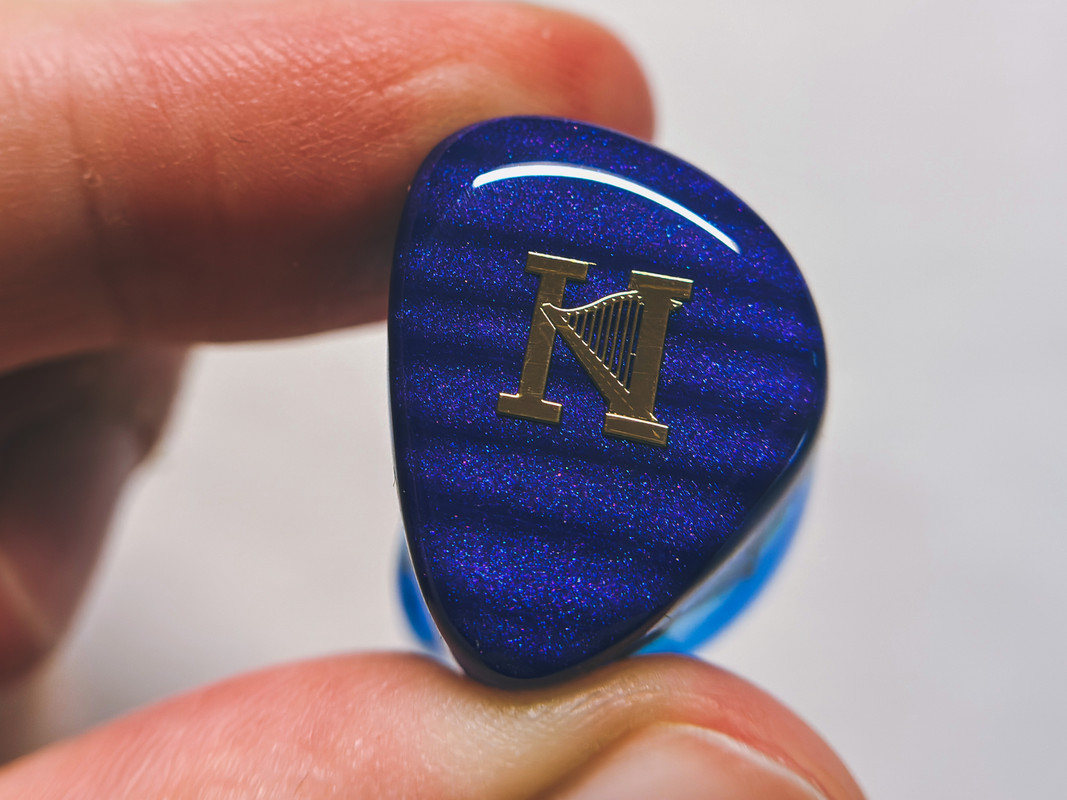
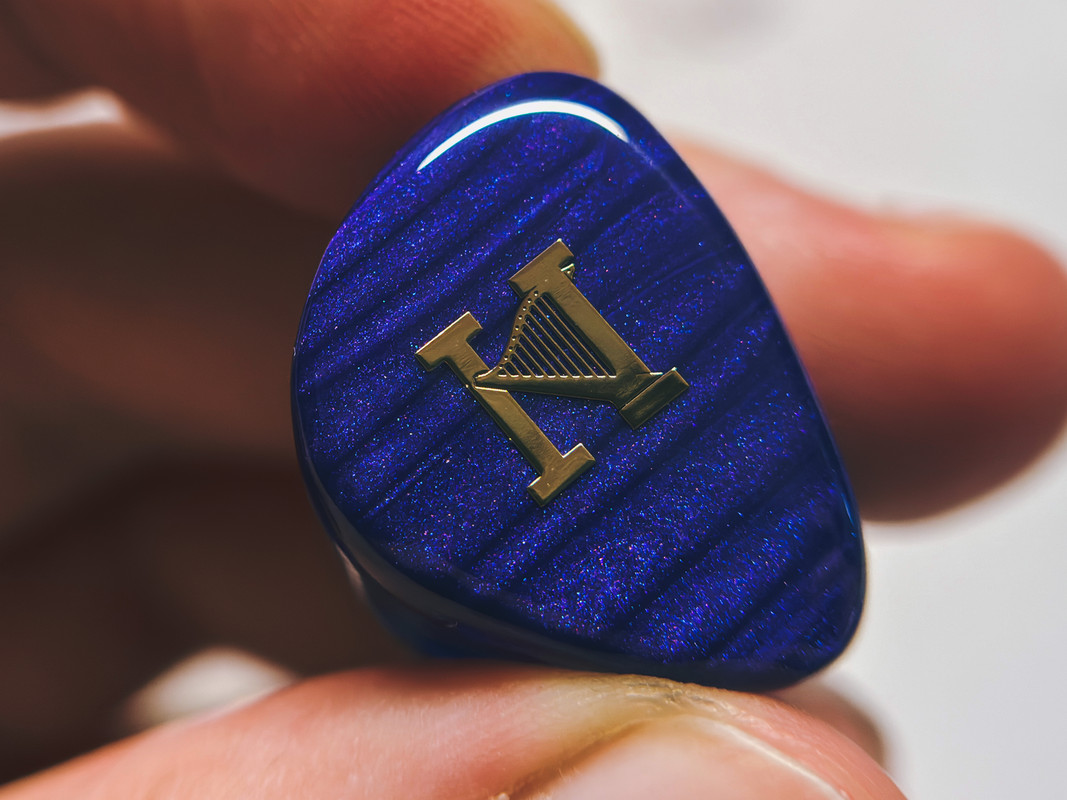
And here is a 2 pin connector for connecting the cable, and there is a single hole for compensation and on the right earpiece it is additionally colored.

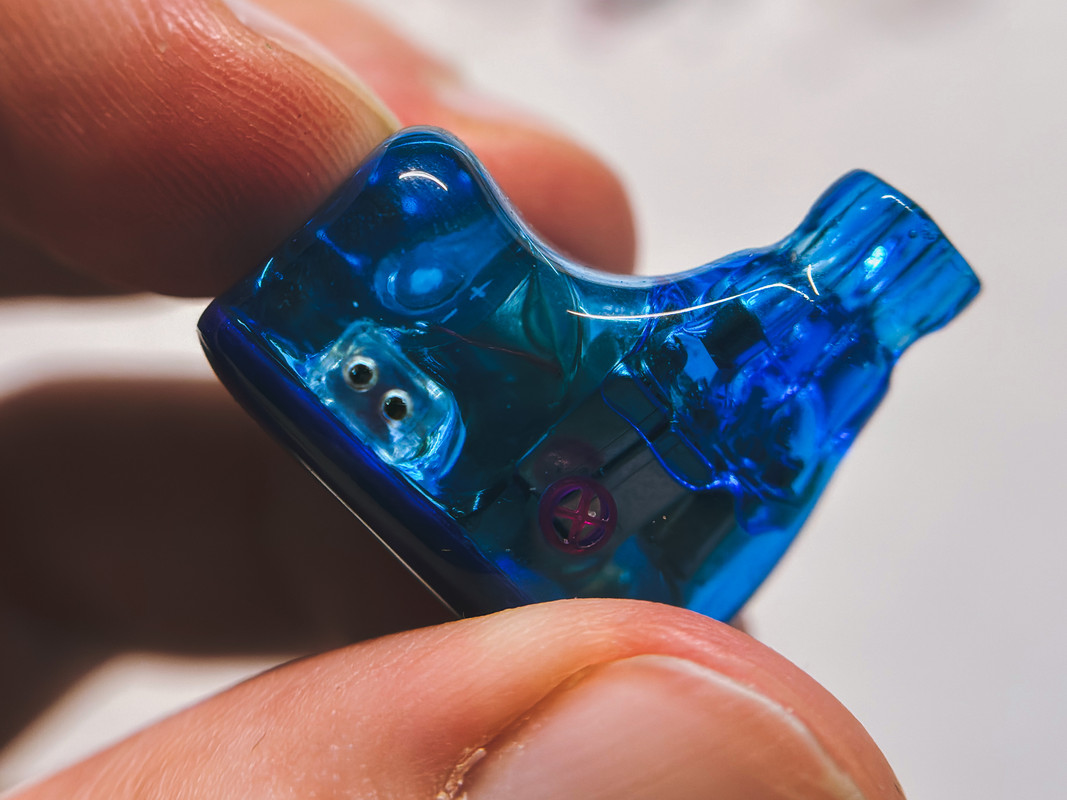
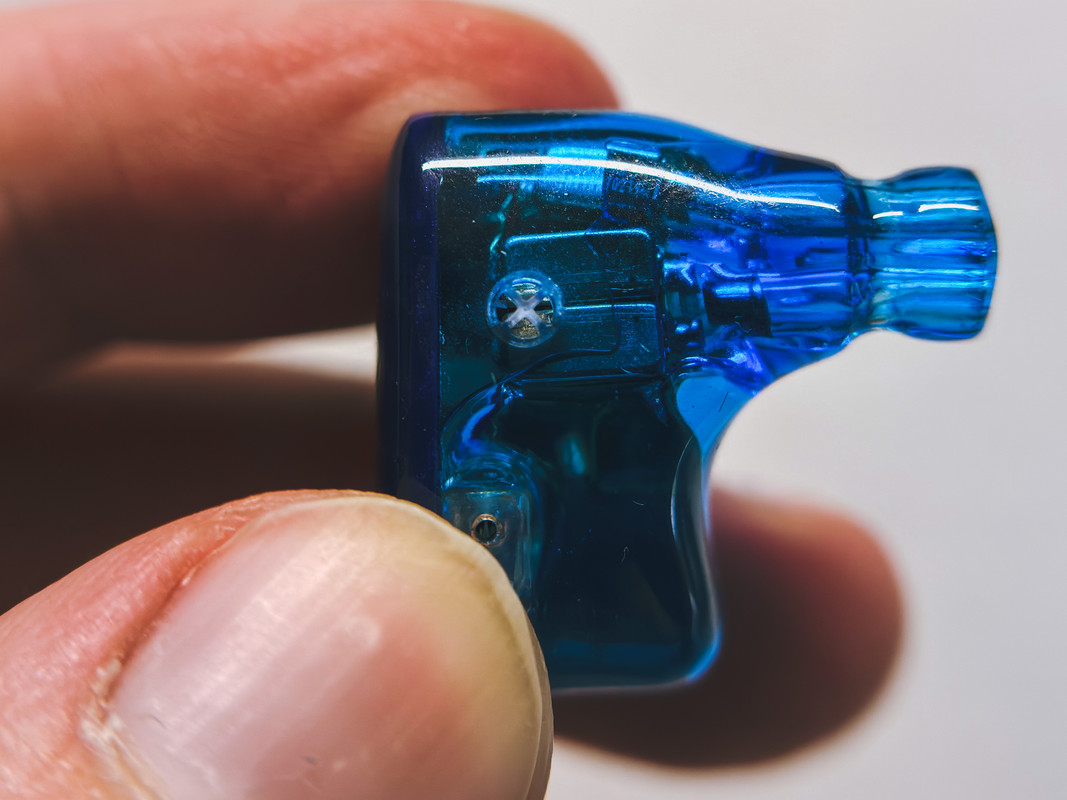
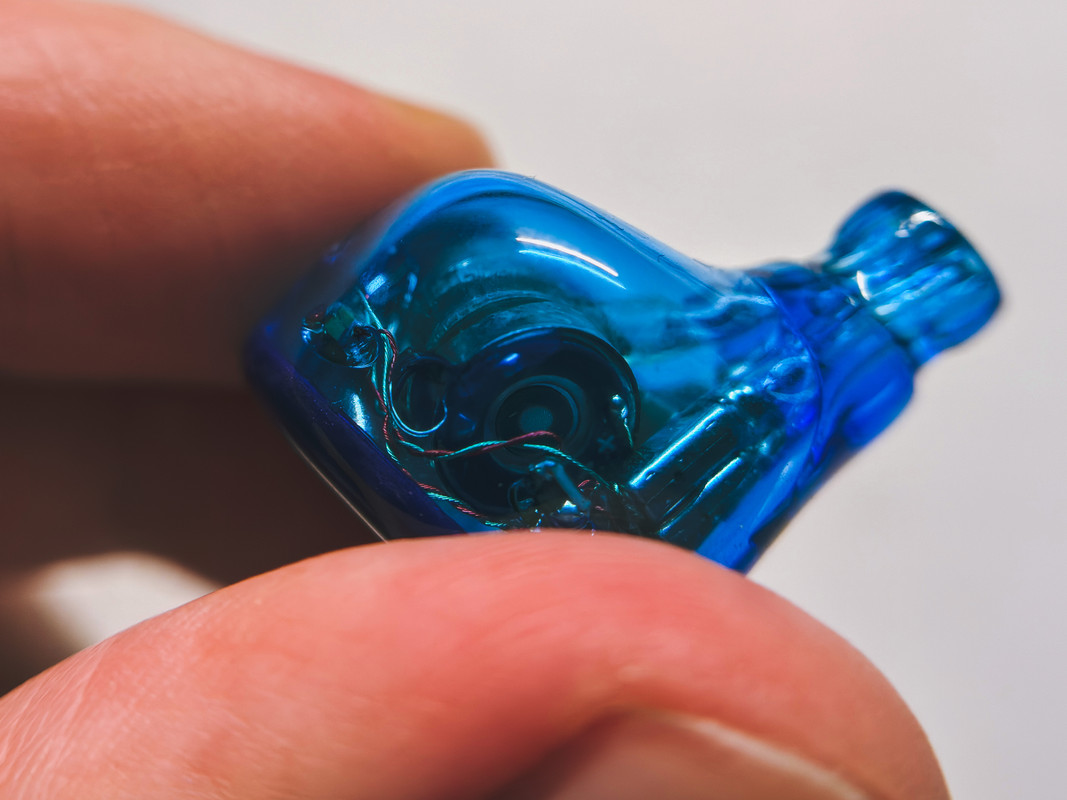
And on the inside there is a small inscription H60 and you can see absolutely all the beauty and stuffing of these headphones, here are those two dynamic drivers with a diameter of 8 mm, and 4 armature drivers, which are under the soundhole and set off by special tubes in it.
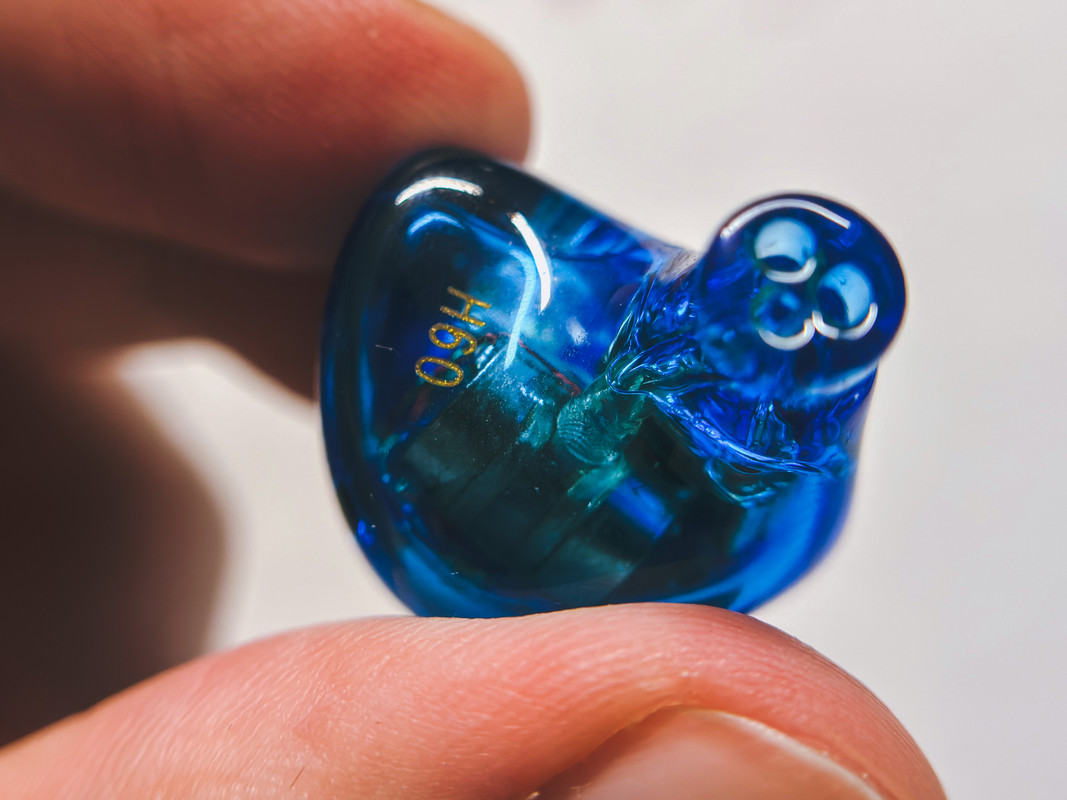
And yes guys, of course the soundhole of these headphones is very big and its diameter is 6.8mm, which is a lot, but at least it has a little bit of a dedicated edge for better fixation of the ear tips.
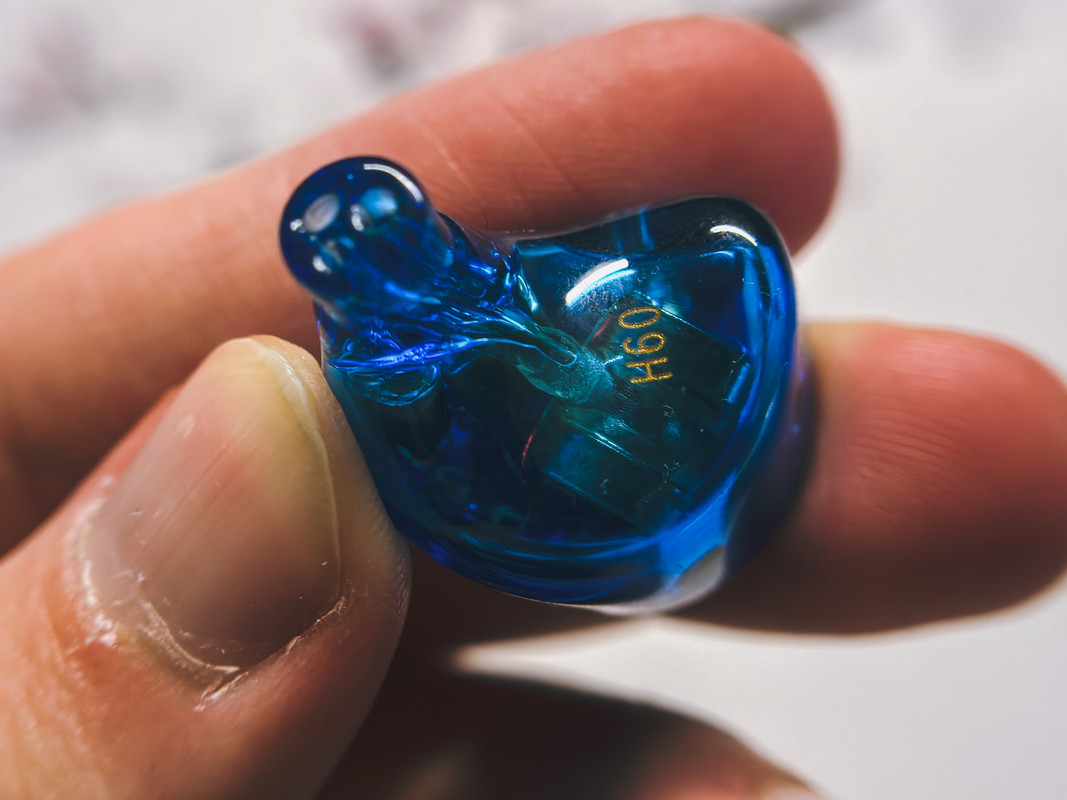 And personally, I have long been used to such larger hybrid models, so I had no problems using these headphones and comfort, they sit very tightly and the sound insulation is excellent, you can use them with complete silicone ear pads or pick up any others you want, and it is advisable to choose wider ones, since the nozzle of these headphones is really not small, and the complete cable is surprisingly very g od, it was convenient to use it despite the fact that it does not have any formed ears.However, it's just a high-quality copper cable.
And personally, I have long been used to such larger hybrid models, so I had no problems using these headphones and comfort, they sit very tightly and the sound insulation is excellent, you can use them with complete silicone ear pads or pick up any others you want, and it is advisable to choose wider ones, since the nozzle of these headphones is really not small, and the complete cable is surprisingly very g od, it was convenient to use it despite the fact that it does not have any formed ears.However, it's just a high-quality copper cable.
- Tuning and Conception -
Well now let's talk about how the ISN Audio H60 hybrid headphones sound, this is how their frequency response graph looks like, these headphones have a 8dB bass boost with a very smooth transition to the midrange, and what surprised me is a very small boost in the upper midrange, recently the headphones that I tested had a much more noticeable boost in this area but not in the case of these headphones, and it pleased me directly such a bold decision I very much approve, and the high frequencies here are also good with excellent duration that will definitely please the most demanding audiophiles, now let's analyze the sound of these headphones in more detail.
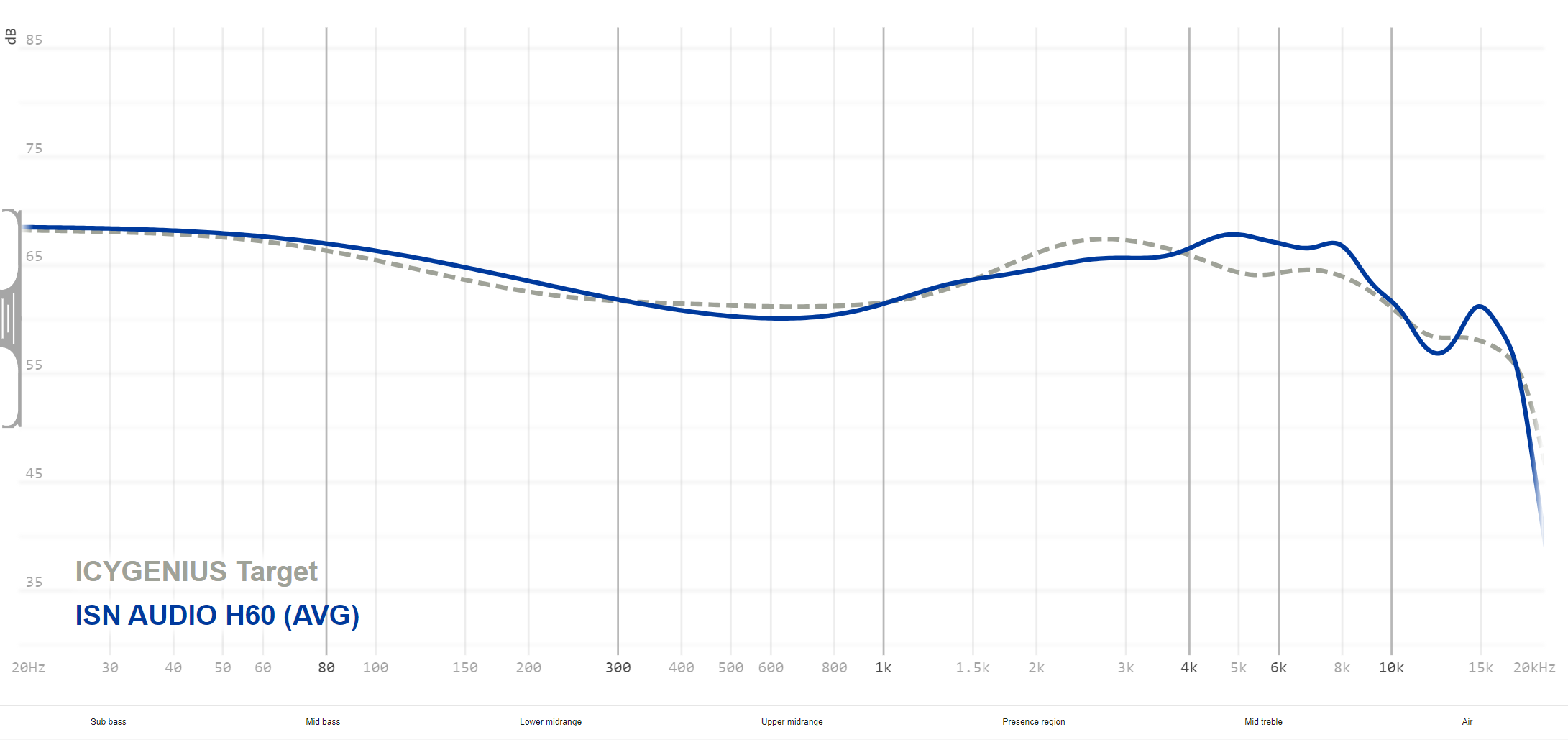
- Low Frequencies -
The bass in the ISN H60 is an example of real mastery of balance, as it is restrained, neat, but at the same time rich and highlighted enough to create a good sense of volume and depth, but without being too intrusive.
Bass in these headphones does not come to the forefront, but it is felt in each song as a very accurate and well-defined foundation, which emphasizes the necessary dynamics and emotional component of the track.
And what makes the bass in these headphones especially appealing is its texture. As each kick or sub bass vibration in the lowest register sounds with almost unbelievable clarity, c very highlighted attack and without any blurring.
That is, these headphones do not drown in muddy bass, but sound very transparent and even I would say airy, and to some extent technical, with excellent audibility of saturation in synthesizer bass and distortion in guitars, so you can clearly and very clearly distinguish how the sub-bass opens up with noticeable clarity and abstraction, without absorbing other elements of the sound spectrum in the lower midrange, and without disturbing this perfectly laid balance in these headphones, so it immediately makes them ideal for those who appreciate purity in the sound, but at the same time not ready to give up the richness, depth and richness of low frequencies, and when listening to these headphones it feels like the bass is smoothly integrated into the overall sound picture, creating a sense of necessary harmony, not excessive dominance as in basshead models.
And the more I listen to them, the more I feel how the bass is not just somehow pressing, but creates a really dense and maximally concentrated bass base, on which the rest of the musical palette unfolds.
And as a result, the low frequencies in these headphones are the cleanest, crisp and neatly balanced bass, which does not distract from the overall sound, but gives it the right depth, foundation and texture, with a clearly highlighted punch and very cheerful musicality in its presentation.
- Mid Frequencies -
At the same time, the midrange frequencies in ISN H60 deserve special attention.
They are very well balanced, quite neutral in their presentation, they do not stand out too forward, but also do not get lost in the overall picture at all. And this makes the sound tonally natural, musical and at the same time very detailed. The midrange here does not sound too warm, as in some models, but at the same time is not too bright, as in the headphones already with Harman setting.
And as for me they are in perfect balance, creating a very comfortable and natural authentic sound, without any aggression and pretentiousness in the upper midrange, which is very important for me, and here this range does not bother me at all.
At that and how the midrange in these headphones is a real example of perfect transparency and clarity with just some crazy airiness in presentation.
Due to which any vocal and instrumental parts sound with great precision, and voices in these headphones are transmitted very vividly and emotionally, with good texture and depth, thanks to which you can catch even the smallest detail in the performance, whether it is a slight vibration of the voice or nuances in the accompaniment.
At the same time, I immediately liked the fact that the middle frequencies have even a certain elegant restraint in their presentation. As they do not seem overly obtrusive and tiresome when listening for a long time, which allows you to enjoy the music in a fuller volume for a long time listening to absolutely different musical genres.
And so the midrange in the ISN H60 is the perfect balance between precision, neutrality and just the right amount of musicality. They are not bright, not aggressive, and to my taste just perfectly convey all the nuances of music, without distracting you with any unnecessary accents, and perfectly fit into the overall context of sound, as from the point of view of tuning everything is perfect here.
- High Frequencies -
The high frequencies in the ISN H60 are another of the nice features of these headphones.
There's none of the harshness or brightness that characterizes some models, where the high frequencies literally drill your ears. Instead, they remain crisp, detailed and tonally very natural, with simply stunning technicality and analysis.
And from the first listen, their transparency is immediately apparent. You can really hear all the nuances from literally crystal cymbals to the clicks of strings or light taps on the keys.
Everything in this range sounds very clear, without distortion and aggression, that is only clean and detailed sound.
Where each, even the smallest detail in the mix, remains in its place and does not protrude against the background of other frequencies, which adds balance and harmony to the overall sound picture.
And I immediately liked that when listening to them do not create a feeling of excessive lightness or some kind of dryness in the sound, as it happens in some headphones with an emphasis on the highs.
Instead, the highs in the ISN H60 are revealed with good texture and some smoothness and slight softening, which is especially important for those who like to listen to micro nuances but don't want to feel like something is sticking out too intrusively.
And I should mention that another important aspect is their ability to add depth and space.
The high frequencies here literally create atmosphere, adding a sense of air and three-dimensionality to the sound.
And even in very complex musical compositions, the high frequencies retain their clarity and transparency, so to speak, not overloading the overall mix, but, on the contrary, creating an effect of lightness and freedom in the sound, which I personally like very much and you know that I love headphones with such a presentation.
And to summarize, the treble in these headphones is literally all about clarity and insane detail, without any distortion or over-emphasis. They add the necessary depth and space, and do not make your ears suffer from any harshness or brightness, and as for me are ideal for those who appreciate accuracy and really verified precision in the sound for audiophiles.
- Sound Stage -
Well, the soundstage of ISN H60 is one of the things that impressed me immediately.
First of all, the width of the ISN H60's stage is very good, and even on complex tracks with multiple instruments, you can feel that the sounds are very clearly distributed throughout the space. And when listening to them you don't lose details in the center or at the edges, but hear how each instrument takes its exact position.
And the depth of the stage is also top-notch.It's not just a flat reproduction of music, you can feel the “distance” between instruments, as if they were at different levels or even distances from you.
For example, if there is some distant element in a composition, say a quiet background vocal or an instrument, it will be perfectly audible but with some sense of distance, which is cool and on more complex pieces with multiple layers it gives a real sense of proper depth and volume, and this is especially good in classical music or live recordings where you can feel how an orchestra sounds and each instrument in the ensemble has its own depth.
The same goes for jazz, where if you're listening to a band and you can hear each musician occupying a different part of the stage, whether it's the drums in the back, the guitar in the center or the brass on the sides.
And when it comes to precision and separation, these headphones do a great job here, too.
You can clearly distinguish the location of each element, whether it's individual instruments in a live performance or layers in a complex studio recording.And there's no elements getting lost or blended, everything sounds very harmonious, and with a clear understanding of where and what is located.
In general, the soundstage in ISN H60 is exactly that space where all elements of the musical picture have their clear contours, but at the same time do not interfere with each other due to their excellent localization and separation.
And it's exactly the kind of space that gives you depth, detail and the feeling that the music is not just playing in your ears, but literally exists all around you.
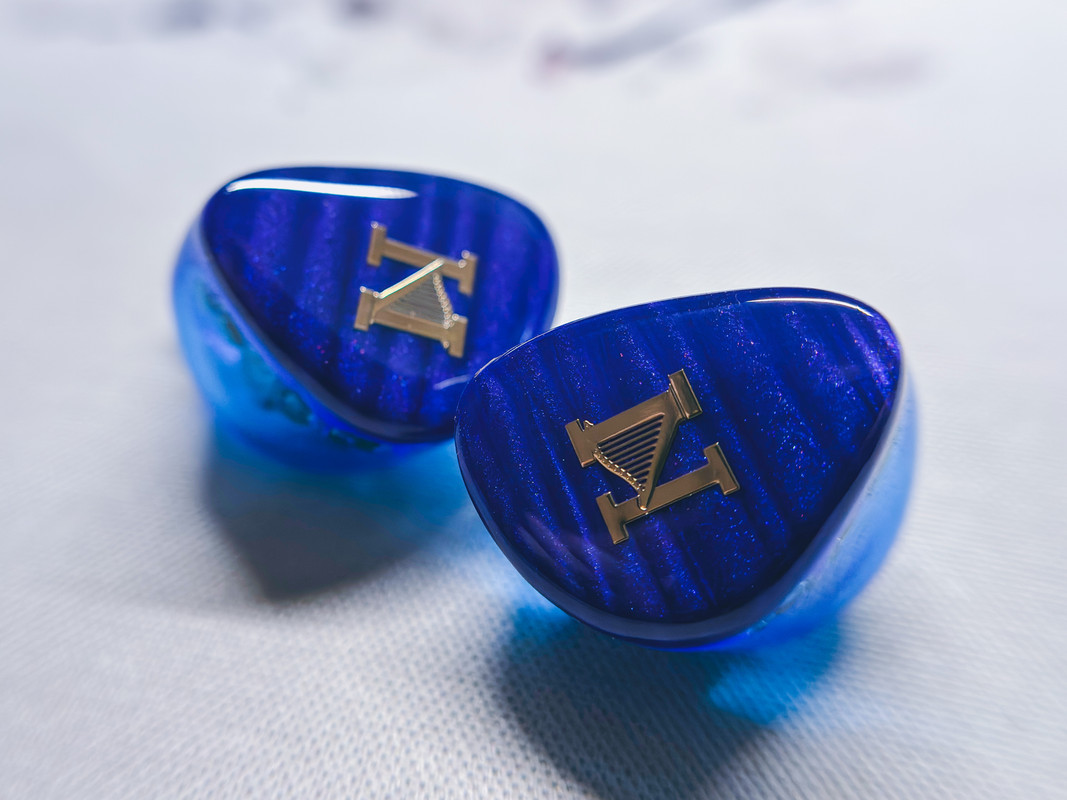
My conclusion on this headphones!
Without any doubt, these are gorgeous hybrid headphones, with an absolutely accurate and competent approach to headphone tuning, they sound very smooth, neutral, but at the same time with excellent emotion in the midrange and really captivating and immersing you in the music super clear pitch, with a very technical and transparent sound at high frequencies, and accurate and textured bass will definitely not leave you indifferent to these headphones, and for my taste in their presentation is absolutely everything enough and fans of such tuning will definitely be satisfied, and from myself I definitely recommend these headphones to buy.
Penon Official Store: https://penonaudio.com/ISN-Audio-H60.html
Hi friends, today in the review we're going to take a look at a gorgeous $349 hybrid headphone from ISN AUDIO.
And they come in a small blue reflective box here there is a company logo.

And on the side there is a marking with the selected cable plug, in my case it's a 4.4 jack.

And at the back are specified technical specifications and for the sound in these headphones is responsible for two dynamic drivers, and 4 armature drivers two of which are from Sonion is responsible for the middle frequencies, and two from Knowles to reproduce the high frequencies, the sensitivity is 112 dB and they received an impedance of 18 ohm, and to drive these headphones are quite light.

- Let's take a look at what's included -
1.Branded case.


2.Eartips.

3.High quality copper audio cable with 4.4 jack and 2 pin connectors.




4.Cleaning brush.

5.Clip.

6.IEM.
The headphones are very large and made entirely of medical grade resin with a beautiful translucent blue design on the inside, while the front panel here is dark blue and already with a striped design and a large gold company logo on both headphones.


And here is a 2 pin connector for connecting the cable, and there is a single hole for compensation and on the right earpiece it is additionally colored.




And on the inside there is a small inscription H60 and you can see absolutely all the beauty and stuffing of these headphones, here are those two dynamic drivers with a diameter of 8 mm, and 4 armature drivers, which are under the soundhole and set off by special tubes in it.

And yes guys, of course the soundhole of these headphones is very big and its diameter is 6.8mm, which is a lot, but at least it has a little bit of a dedicated edge for better fixation of the ear tips.

- Tuning and Conception -
Well now let's talk about how the ISN Audio H60 hybrid headphones sound, this is how their frequency response graph looks like, these headphones have a 8dB bass boost with a very smooth transition to the midrange, and what surprised me is a very small boost in the upper midrange, recently the headphones that I tested had a much more noticeable boost in this area but not in the case of these headphones, and it pleased me directly such a bold decision I very much approve, and the high frequencies here are also good with excellent duration that will definitely please the most demanding audiophiles, now let's analyze the sound of these headphones in more detail.

- Low Frequencies -
The bass in the ISN H60 is an example of real mastery of balance, as it is restrained, neat, but at the same time rich and highlighted enough to create a good sense of volume and depth, but without being too intrusive.
Bass in these headphones does not come to the forefront, but it is felt in each song as a very accurate and well-defined foundation, which emphasizes the necessary dynamics and emotional component of the track.
And what makes the bass in these headphones especially appealing is its texture. As each kick or sub bass vibration in the lowest register sounds with almost unbelievable clarity, c very highlighted attack and without any blurring.
That is, these headphones do not drown in muddy bass, but sound very transparent and even I would say airy, and to some extent technical, with excellent audibility of saturation in synthesizer bass and distortion in guitars, so you can clearly and very clearly distinguish how the sub-bass opens up with noticeable clarity and abstraction, without absorbing other elements of the sound spectrum in the lower midrange, and without disturbing this perfectly laid balance in these headphones, so it immediately makes them ideal for those who appreciate purity in the sound, but at the same time not ready to give up the richness, depth and richness of low frequencies, and when listening to these headphones it feels like the bass is smoothly integrated into the overall sound picture, creating a sense of necessary harmony, not excessive dominance as in basshead models.
And the more I listen to them, the more I feel how the bass is not just somehow pressing, but creates a really dense and maximally concentrated bass base, on which the rest of the musical palette unfolds.
And as a result, the low frequencies in these headphones are the cleanest, crisp and neatly balanced bass, which does not distract from the overall sound, but gives it the right depth, foundation and texture, with a clearly highlighted punch and very cheerful musicality in its presentation.
- Mid Frequencies -
At the same time, the midrange frequencies in ISN H60 deserve special attention.
They are very well balanced, quite neutral in their presentation, they do not stand out too forward, but also do not get lost in the overall picture at all. And this makes the sound tonally natural, musical and at the same time very detailed. The midrange here does not sound too warm, as in some models, but at the same time is not too bright, as in the headphones already with Harman setting.
And as for me they are in perfect balance, creating a very comfortable and natural authentic sound, without any aggression and pretentiousness in the upper midrange, which is very important for me, and here this range does not bother me at all.
At that and how the midrange in these headphones is a real example of perfect transparency and clarity with just some crazy airiness in presentation.
Due to which any vocal and instrumental parts sound with great precision, and voices in these headphones are transmitted very vividly and emotionally, with good texture and depth, thanks to which you can catch even the smallest detail in the performance, whether it is a slight vibration of the voice or nuances in the accompaniment.
At the same time, I immediately liked the fact that the middle frequencies have even a certain elegant restraint in their presentation. As they do not seem overly obtrusive and tiresome when listening for a long time, which allows you to enjoy the music in a fuller volume for a long time listening to absolutely different musical genres.
And so the midrange in the ISN H60 is the perfect balance between precision, neutrality and just the right amount of musicality. They are not bright, not aggressive, and to my taste just perfectly convey all the nuances of music, without distracting you with any unnecessary accents, and perfectly fit into the overall context of sound, as from the point of view of tuning everything is perfect here.
- High Frequencies -
The high frequencies in the ISN H60 are another of the nice features of these headphones.
There's none of the harshness or brightness that characterizes some models, where the high frequencies literally drill your ears. Instead, they remain crisp, detailed and tonally very natural, with simply stunning technicality and analysis.
And from the first listen, their transparency is immediately apparent. You can really hear all the nuances from literally crystal cymbals to the clicks of strings or light taps on the keys.
Everything in this range sounds very clear, without distortion and aggression, that is only clean and detailed sound.
Where each, even the smallest detail in the mix, remains in its place and does not protrude against the background of other frequencies, which adds balance and harmony to the overall sound picture.
And I immediately liked that when listening to them do not create a feeling of excessive lightness or some kind of dryness in the sound, as it happens in some headphones with an emphasis on the highs.
Instead, the highs in the ISN H60 are revealed with good texture and some smoothness and slight softening, which is especially important for those who like to listen to micro nuances but don't want to feel like something is sticking out too intrusively.
And I should mention that another important aspect is their ability to add depth and space.
The high frequencies here literally create atmosphere, adding a sense of air and three-dimensionality to the sound.
And even in very complex musical compositions, the high frequencies retain their clarity and transparency, so to speak, not overloading the overall mix, but, on the contrary, creating an effect of lightness and freedom in the sound, which I personally like very much and you know that I love headphones with such a presentation.
And to summarize, the treble in these headphones is literally all about clarity and insane detail, without any distortion or over-emphasis. They add the necessary depth and space, and do not make your ears suffer from any harshness or brightness, and as for me are ideal for those who appreciate accuracy and really verified precision in the sound for audiophiles.
- Sound Stage -
Well, the soundstage of ISN H60 is one of the things that impressed me immediately.
First of all, the width of the ISN H60's stage is very good, and even on complex tracks with multiple instruments, you can feel that the sounds are very clearly distributed throughout the space. And when listening to them you don't lose details in the center or at the edges, but hear how each instrument takes its exact position.
And the depth of the stage is also top-notch.It's not just a flat reproduction of music, you can feel the “distance” between instruments, as if they were at different levels or even distances from you.
For example, if there is some distant element in a composition, say a quiet background vocal or an instrument, it will be perfectly audible but with some sense of distance, which is cool and on more complex pieces with multiple layers it gives a real sense of proper depth and volume, and this is especially good in classical music or live recordings where you can feel how an orchestra sounds and each instrument in the ensemble has its own depth.
The same goes for jazz, where if you're listening to a band and you can hear each musician occupying a different part of the stage, whether it's the drums in the back, the guitar in the center or the brass on the sides.
And when it comes to precision and separation, these headphones do a great job here, too.
You can clearly distinguish the location of each element, whether it's individual instruments in a live performance or layers in a complex studio recording.And there's no elements getting lost or blended, everything sounds very harmonious, and with a clear understanding of where and what is located.
In general, the soundstage in ISN H60 is exactly that space where all elements of the musical picture have their clear contours, but at the same time do not interfere with each other due to their excellent localization and separation.
And it's exactly the kind of space that gives you depth, detail and the feeling that the music is not just playing in your ears, but literally exists all around you.

My conclusion on this headphones!
Without any doubt, these are gorgeous hybrid headphones, with an absolutely accurate and competent approach to headphone tuning, they sound very smooth, neutral, but at the same time with excellent emotion in the midrange and really captivating and immersing you in the music super clear pitch, with a very technical and transparent sound at high frequencies, and accurate and textured bass will definitely not leave you indifferent to these headphones, and for my taste in their presentation is absolutely everything enough and fans of such tuning will definitely be satisfied, and from myself I definitely recommend these headphones to buy.
Penon Official Store: https://penonaudio.com/ISN-Audio-H60.html
Last edited:
sKart7
New Head-Fier
Pros: • Excellent build quality and beautiful translucent blue shells.
• Smooth all resin construction and lightweight shells.
• Comfortable for long listening sessions with proper tips.
• Great bass impact and extension.
• Smooth and inoffensive treble.
• Excellent mids presentation. Best vocals in this price range.
• Holographic soundstage. Above average imaging.
• Good resolution, timbre, and cohesion. Separation is noteworthy as well.
• Easy to drive.
• One of the best IEMs under 500 USD and punches way above its price point.
• Smooth all resin construction and lightweight shells.
• Comfortable for long listening sessions with proper tips.
• Great bass impact and extension.
• Smooth and inoffensive treble.
• Excellent mids presentation. Best vocals in this price range.
• Holographic soundstage. Above average imaging.
• Good resolution, timbre, and cohesion. Separation is noteworthy as well.
• Easy to drive.
• One of the best IEMs under 500 USD and punches way above its price point.
Cons: • Sound is dependent on tips and cable.
• Shells are a bit on the larger side. May not be comfortable for people with small ears.
• Stock cable is not up to the mark and holds back IEM’s true capability.
• Shells are a bit on the larger side. May not be comfortable for people with small ears.
• Stock cable is not up to the mark and holds back IEM’s true capability.

Disclaimer:
I’d like to thank AudioGeek, Sandeep Agrawal and Penon Audio for including me in the tour of ISN H60 IEM. I was given a chance to audition this IEM for a week and provide my honest opinion. The impressions shared in this write-up are my unbiased and honest subjective take on the ISN H60 IEM.
Introduction (Design and Specs):
H60 shells are made with vented medical grade resin, in a beautiful translucent blue color. The shells are a bit on the larger side however extremely smooth. With proper tip rolling they are comfortable to wear for long time. With Dunu S&S eartips, there was no discomfort whatsoever even after 2 to 3 hrs. of continuous use.
ISN H60 driver configuration:
4BA + 2 Dynamic Driver Hybrid
2 x Knowles Balanced Armature for high frequency
2 x Sonion Balanced Armature for middle frequency
2 x 8mm liquid silicone gel diaphragm for low frequency
3-way crossover
Impedance – 18 Ohms
Sensitivity: 112dB
Frequency response: 5Hz-40kHz

Cables and Tips:
The supplied stock cable is ISN audio C4. Cable is okish and nothing special. To unleash the true potential of this IEM cable rolling is must I feel. I tried with Effect audio Eros S and Dunu Hulk Pro mini cable. Both sounds much better than stock cable. Eros S brings out the true potential of H60. As per my tests SPC cables performed better with this IEM compared to pure copper.
With Eros S cable, there was an immediate wow factor. Eros S greatly enhances the soundstage, details, imaging, and layering. With Eros S, H60 imaging was more on point with better precision. Bass has better punch and details. I used Eros S cable for the rest of review.
As for tips I couldn’t find a proper fit with the supplied ones. Dunu S&S was excellent pairing with H60. With S&S tip I can wear H60 for long time without any comfort issues.
IEM setup – H60 + EA Eros S Cable + Dunu S&S Eartips


Sources Used:
- Chord Hugo 2
- Onix Alpha Xl1 Dongle
Samsung S23 Ultra Phone > UAPP > Tidal/local Files > Onix Alpha
Samsung S23 Ultra Phone > Apple Music > Onix Alpha
ISN H60 is an easy to drive IEM. It sounded great with Onix Alpha dongle DAC. The bass have great impact and rumble. Technicalities were above average. Nothing to complain here.
With Hugo 2, H60 is a different beast altogether. Excellent details and terrific bass impact. Hugo 2 is the one source which will bring out the best of almost all the IEMs. Soundstage gained dimensions and the imaging is amazing.

Sound Analysis:
H60 has a mild V shaped tuning. The bass has good impact and rumble. Mids are lush, very smooth and full of details. the highs are well extended and great for the price. Vocal lovers should try this IEM, its best for the price and above.
Bass:
Bass is handled by 2 x 8mm liquid silicone gel dynamic drivers. The bass is quite impactful and visceral. Speed is quite commendable as well, neither slow nor too fast. Subbass is given a bit more focus than the midbass. H60 bass helps in creating an immersive depth perception to the overall sound. H60 slams hard when the music calls for it.
Bass doesn’t interfere with mids as well. Overall, excellent bass performance.
Mids:
The mids are highlight of this IEM. I would say that the mids comes dangerously close to penon voltage IEM. Quite detailed and lovely sense of space and separation. Instrument and vocals are both given equal importance. Detail retrieval is excellent here.
Male vocals are full bodied and has that heft to it. Female vocals are clear and detailed.
The mids overall are excellent and ISN has done a seriously good job making it clean and well separated yet still having that lush organic tonality.
Treble:
Treble region is sparkly and crisp. No sibilance at all. Upper treble has good energy and shimmer. Cymbal crashes felt so real.
Treble may not be the highlight aspect of H60 however it doesn’t feel lacking as well.
Technicalities:
H60 really shines here. It got excellent stage width and depth. Height is more than average. Detail retrieval is one of the best under 500 USD. Soundstage is holographic and 3D sounding. Dynamics is average and nothing to brag about. Imaging is good for the price as well.
Instrument separation and layering is excellent. No congestion with busy passages.
Gaming:
I did some gaming with H60 to gauge its soundstage and imaging performance. Tried with my PS5 on games Fortnite Battle Royale and God of War.
Soundstage perception in Fortnite and GOW is awesome. Very vast, expansive, and great imaging too. I can clearly hear the players around me. H60 clearly shows where the players are in the map. Whether they are above, below, or same level as me, H60 clearly images that. I can clearly hear enemy footsteps. I can even hear gunfights happening very far away and its distance. Overall good IEM for gaming.

Comparisons:
Brief comparison to IEMs I own/tried.
Dunu SA6 MK2:
SA6 MK2 is a bit higher priced IEM however this is a fair comparison. SA6 MK2 shells are smaller and more comfortable.
Coming to sound H60 has better cohesion and is more musical. For bass, no contest H60 is the clear winner. With its 2 DD, H60 has better rumble and slam. SA6 bass sound mushy in comparison to H60, no wonder as it uses BA drivers. The SA6 MK2s are darker and treble quality is better on the H60s as well, which are also more dynamic. The SA6 MK2s have a wider stage compared to H60 but it’s much shallower, and imaging isn’t as precise. H60 is clear winner.
Penon Voltage:
I know this is not a fair comparison. I was lucky enough to try Voltage as a part of AG/Penon IEM tour. Voltage is more than 3X the price of H60. H60 is a like a mini Voltage. That’s the best complement for an IEM priced at around 350 USD. Both are musical sounding and shares a similar tuning. H60 bass is quite enjoyable like voltage. Mids are where the H60 comes close to Voltage. H60 mids and vocals are quite appealing for the price range. Voltage is clearly ahead in treble with its EST drivers. Technicalities are also at a higher tier in voltage, no wonder as the Voltage is a much higher priced IEM.


Conclusion:
I am massively impressed with the ISN H60. For the price it’s an absolute steal. Quite commendable what ISN Audio has achieved with H60. Those who are looking for a musical sounding IEM with exciting bass, perfect mids and decent technicalities, look no further. Without any doubt H60 is one of the best IEMs under 500 USD.
Attachments
thaslaya
Headphoneus Supremus
Pros: + Heavy mid-bass focus is a fun divergence from the sub-bassy Harmon sets
+ Smooth and forward midrange
+ Treble is very tame and takes a backseat which suits me just fine
+ Fit and comfort are good but beware the nozzle size is a bit large
+ Musicality dialed up to eleven
+ Smooth and forward midrange
+ Treble is very tame and takes a backseat which suits me just fine
+ Fit and comfort are good but beware the nozzle size is a bit large
+ Musicality dialed up to eleven
Cons: - Detail retrieval and resolution take a hit for the more musical tuning
- Trebleheads—don’t even bother
- Bass isn't the cleanest but that could be considered part of its charm
- Niche tuning won't be for everyone
- Trebleheads—don’t even bother
- Bass isn't the cleanest but that could be considered part of its charm
- Niche tuning won't be for everyone

thaslaya's star rating system:
☆☆☆☆☆ - Fantastic!
☆☆☆☆ - Recommended
☆☆☆ - There are buyers but not for me
☆☆ - Can't see the appeal
☆ - Product is a failure
Disclaimer:
This product was loaned to me by a friend in exchange for a review period. I recieve no compensation and all thoughts and opinions are my own. A special thanks to @FreeWheelinAudioLuv2 for this opportunity!
Gear used:
●LG v30+
●Samsung Galaxy s22 Ultra
●Samsung dongle
●Hiby FC4
●Kiwi Ears Allegro
●Letshuoer DT03
●Dunu DTC480
●BLON V1
Source:
●Listening was done through Amazon Music HD or Ultra HD.
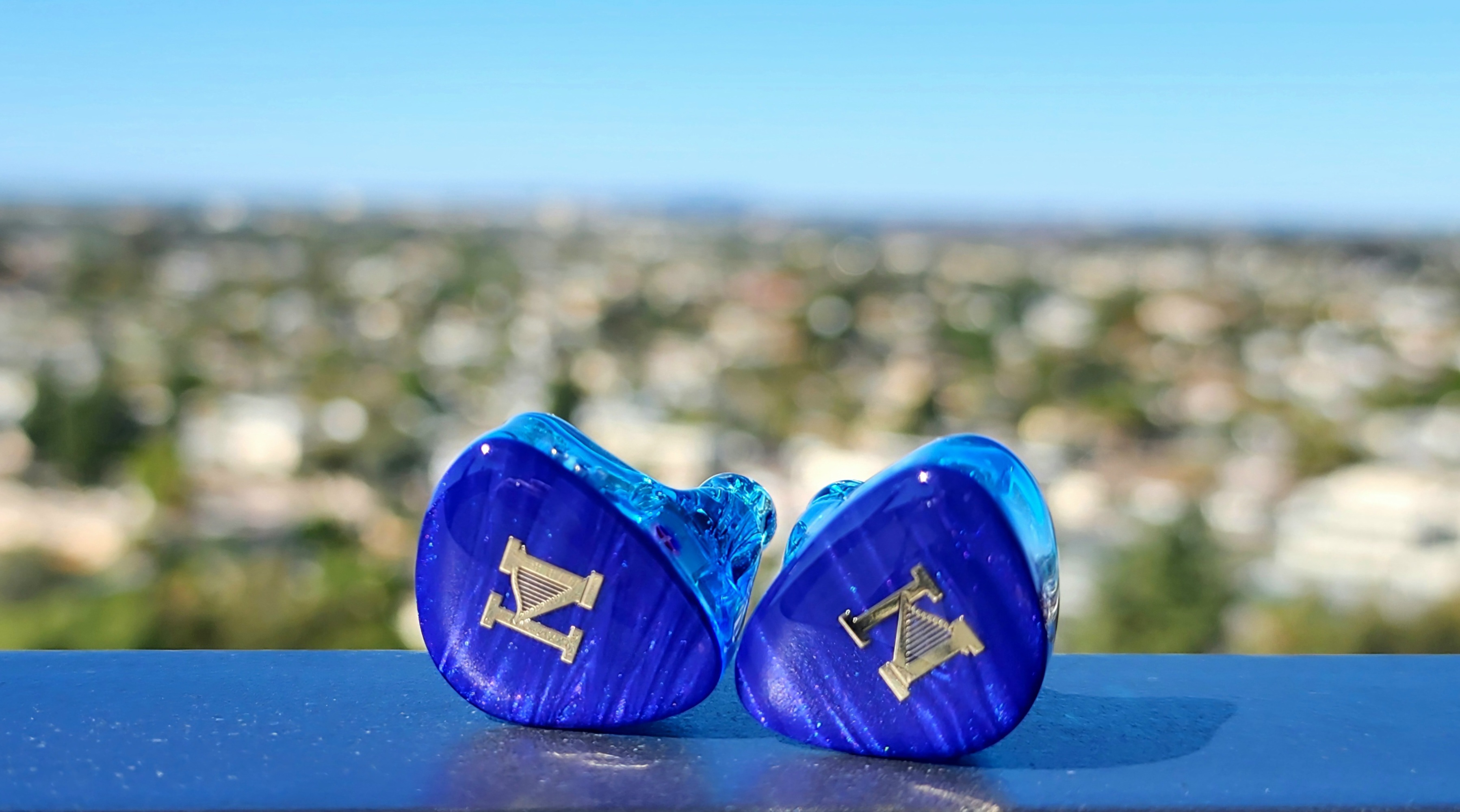
Introduction:
ISN Audio is an IEM and cable manufacturer and a subsidiary of Penon. They are often lumped together, but they both offer their own unique products and house sound. ISN has released a few popular and mostly well-received IEMs such as the Neo 5, Neo 3, and EST50. The H60 is one of their newer releases, and it features a hybrid design sporting two dynamic drivers for the lows, two Sonion balanced armatures for the mids, and two Knowles balanced armatures for the highs. It is currently available through Penon's website for $349, but those who sign up for their newsletter may be able to receive discount codes for certain products. Let's dive into the latest hybrid by ISN and see how it stacks up in today's market.

Build, fit, ergonomics:
Unfortunately, I can't speak to the unboxing or accessories since this is a loaner set. I only received the IEMs themselves, so I'm unable to make comments about the stock cable and tips. The H60's shells are made of a transparent blue resin with a darker blue faceplate featuring the ISN logo. The shell size might be just a bit larger than average, but they also feature a contoured surface that faces the ear, and they fit comfortably for me. The flat 2-pin connection is great since I was able to try many of my own cables. There is a small vent hole for pressure relief near this connection as well. The nozzle is quite large—dare I say it's one of the largest I've come across—measuring 6.8 mm at the widest point, where there is a slight lip. While the nozzle size does not pose an issue for me personally, its width could be a nonstarter for those with smaller ears. Since I didn't have access to the stock tips, I tried a variety of my own and eventually settled on the Tri Clarions. The H60 is already a bassy set, so narrow bore tips were not the best match for me. They have the potential to add even more emphasis on the bass and can lead to them sounding more congested and closed off. The wider bore really helps to maximize the amount of air and treble extension while still allowing the full bass to shine through. As far as cables are concerned, I decided to use my Penon PAC480 mixed copper and silver cable. Adding a bit of silver helped to open up the top end slightly and better balance the large bass shelf.


Sound impressions:
The overall tuning of the H60 is somewhere between a V- and L-shape, with more of a mid-bass focus over sub-bass and a rolled-off treble. The note weight is thick and meaty; there's no thinness here at all. It's enjoyable for me personally, but I understand it won't be everyone's style. This set is easy to drive and can reach high volume levels without needing amplification. However, I prefer it with an injection of power, as it helps it exhibit a fuller, more effortless quality that is smoother and more robust. Detail retrieval is not the H60's best feature; it's a strong case of choosing musicality over technicality. It's much more enjoyable for simply listening and enjoying the music instead of dissecting the nuances and subtleties within it. I'd go so far as to say it's subpar for the price, but again, there's a trade-off here, and I think it was a conscious decision by ISN to tune it this way. The soundstage has decent width and depth, and I consider it one of its better features. The timbre is slightly off and it doesn't quite have the degree of natural or organic quality that I would hope for. The thick, syrupy note weight may have something to do with it. Imaging is very accurate and three-dimensional, and the dynamics are decent too. The tuning holds up well at lower volumes, but the bass truly comes to life when it's pushed more. I do have some issues with the separation, as the H60 has trouble keeping up with complex tracks and can get bogged down a bit. However, since it is more about musicality and enjoyment than critical listening, I can forgive this somewhat, but it is worth noting. Despite its somewhat lackluster technical performance, the H60 does have some special qualities to it. For those who grew up on 90's rock and alternative, this set is probably the closest I've heard to reproducing the same sound quality from my youth, at least as far as my nostalgic brain can be convinced. It harks back to the days of portable CD players and I believe these genres are where this set truly excels. That also might mean it has more niche audience. In modern recordings, it can sound a little off or too "lo-fi." But how it plays back less-than-stellar quality recordings is uncanny.
After trying many different sources, I found the Blon V1 dongle to be the best pairing. It helped bring out a bit more sub-bass to balance the prominent mid-bass while preserving the smoothness of the stock tuning and pushed the vocals forward just a bit more.


●Lows - The H60 is definitely a fun, bassy set, but it has a lot of mid-bass and less sub-bass. It has that sort of "lo-fi" quality, but that's not necessarily a bad thing. It just sounds different and unique from many others. The impact might be just a touch on the soft side, but that mid-bass thump is definitely there in spades. The low-end extension is okay, but since there is more focus on the mid-bass, it stands to reason that the sub-bass rolls off a little early. The sub-bass rumble is decent, but the mid-bass really is the star of the show. Of course, a lot of mid-bass does mean there is a bit of bleed here, but it's not too bad. The speed is good, but the decay can linger a bit, leading to some not-so-well-separated double bass kicks. The texture is a bit too wet or muddy, but again, that might be a good thing at times. The bass has a sort of gritty and grungy quality that somehow does sound natural with the 90's rock and alternative genres. For upbeat pop music? Eh. Metal? Again, not great. Classic rock, chill-hop, and alternative? Yes, sir! It must be something about the way it's recorded or mixed, but it just works. Overall, the bass is really fun and enjoyable for mid-bass enthusiasts, but don't expect a deep extension or the highest resolution.
●Mids - There is a certain degree of warmth here in the midrange that I find enjoyable. Vocals are smooth, clear, and forward, but at the same time, they are not overly prominent and definitely not shouty. They have somewhat of a relaxed quality that makes for easier, longer listening sessions. They are pretty much positioned perfectly for my preferences. Lower-octave instruments like cello and some brass and woodwind have a lot of presence and authority thanks to the extra energy in the mid-bass and throughout the lower midrange. The upper mids are still decently accentuated, and because of this emphasis, female vocalists stand out a bit more than their male counterparts. Guitars on the H60 have a very distinct weight and an almost guttural quality that is a rare find for me. This is where some of the magic of the H60's tuning comes out. It's hard for me to put my finger on what exactly it does so well, but running through some of the big 90's rock and alternative hits brings on wave after wave of nostalgia. This is how I remember these tracks sounding on the audio equipment of my youth. Obviously, technology has advanced quite a long way since that time, but the H60 is able to preserve some of that magical quality I remember while also offering better performance and breathing some life into these genres in particular.
●Highs - The treble takes a bit of a back seat to the bass and mids on the H60, which is how I prefer it. There is still plenty of sparkle with a tinge of brightness to counteract the big bass shelf, but things rarely get spicy. To its credit, I don't get any true sibilance or very irritating notes, just a little too much energy depending on the track. The extension and air are a little lacking, though, and this is not a set for those seeking an emphasis on the treble. Cymbals can sound splashy at high volumes, but otherwise, they are fine. I do tend to listen pretty loudly, so take that with a grain of salt. Hi-hats and snares have a good edge and crispness without detracting too much. There's not a whole lot to dissect here in the treble since it is pretty tame in order for the bass and midrange to shine. If I were to change anything here, I'd dial back the treble energy just a tad to keep any little shrillness that can pop up on some tracks at bay. Overall, the treble has a good balance with the excessive mid-bass and still makes for a prominent enough part of the tuning.


Comparisons: Credit to the audio store and treble well xtended for the graphs.

● Dunu DaVinci ($300) - Both sets feature the same driver configuration (2DD, 4BA) and a bass-forward tuning style, but the H60 comes across as more L-shaped, while the Davinci is closer to U-shaped. The H60 is mid-bass heavy with a more authoritative impact, while the DaVinci has a better balance of sub and mid-bass. The DaVinci also has an overall warmer tonality with more intimate and less forward vocals. The vocals on the H60 can sometimes sound too dark and lack the same vigor as the DaVinci. Neither set has a ton of treble air or extension, but the H60 sounds more rolled off. The DaVinci has a wider soundstage to my ear, but the H60 is more dynamic and energetic. Overall, the Davinci sounds a bit cleaner, and its timbre is slightly better. The H60 is not without its merits, of course, but it's hard to dethrone the DaVinci for me since it resonates so well with my tuning preferences. I'll take the less expensive, better-accessorized, and better all-around tuning any day.
My pick: DaVinci
● Aful Performer 5+2 ($240) - Sorry, there's not a graph available yet for this one. Here we have a hybrid against a tribrid utilizing micro planars. The Performer 5+2 sounds much more balanced, with cleaner bass and better-represented male vocals. The bass of the P5+2 is more sub-bass focused but still has a decent mid-bass impact and slam. The midrange is much cleaner and more resolving, thanks to the lack of mid-bass bleed. Vocals are positioned more forward and better balanced with the overall tuning. The treble is definitely brighter and more extended, with a more distinct punch but not overwhelming. The P5+2's technicalities are much better across the board for me. It's more resolving, has better detail retrieval, and much better timbre. It's honestly a massacre. That's not to say the H60 is without its own charms, but boy, what Aful has been able to do here is impressive, and the P5+2 is also over $100 cheaper. The H60 has a more unique tuning and a certain warmth and musicality that the Aful lacks, but that's not to say the P5+2 is not musical in its own right. These two are very different and fill different roles. The H60 is a strong contender and has more of a niche tuning, but the P5+2 is simply a better all-rounder and the superior performer (see what I did there?).
My pick: Performer 5+2

● Ziigatt Estrella ($300) - The Estrella and H60 feature the same driver configuration, but the former has more of a traditional V-shaped tuning, with sub-bass emphasis and better treble extension and air. There's also a wider sense of space and better layering and separation. The Estrella's bass is much cleaner and more resolving. The midrange is clear and showcases more nuances and subtleties, such as guitar strumming. The treble is crisper and has more of an edge, but it can also be more fatiguing. The Estrella's resolution, imaging, and layering are superb. Also, the timbre is more natural, and vocals are positioned slightly more forward in the mix, which I prefer. Without a doubt, the Estrella is the better technical performer, but it also lacks the same musicality, soul, and special qualities that make the H60 unique. I think the Estrella is the one to pick for that more traditional "hi-fi" sound quality upgrade, but my choice between these two would be the H60. It just has some innate, special, and unique qualities, with a certain amount of heart that the Estrella's technical performance can't match.
My pick: H60

● Penon Fan 3 ($349) - The Fan 3 has a unique hybrid driver configuration of two BAs and one BCD. Its tuning is closer to a more traditional V-shaped style with a greater emphasis on the sub-bass and better extension on both ends. It has superior imaging, a more expansive soundstage, and an overall cleaner sound. The bass is much more resolving and less bloomy or pillowy. Vocals are a hair more forward on the Fan 3, but they do sound a bit thin in comparison. Even though vocals aren't as forward as I would like on the H60, I prefer its warmer, more intimate, and natural quality. Treble is much more apparent with the Fan 3, with better extension and more air and sparkle. Both sets have things that I like and things that I would change. The Fan 3 has superior technicalities, and I prefer its sub-bass rumble and extension, but it also comes across as more clinical, and its treble can be irritating at times. The H60 is a little more "lo-fi," and I wish the overall sound was a bit cleaner. Also, the mid-bass can sometimes be a bit much, but overall it has an innate charm and a warmer, more musical quality. These two can easily coexist in a collection and are somewhat complementary. If I'm forced to choose between the two, my affinity for warmth and musicality wins out in the end, and I find the H60 to be more unique and enjoyable.
My pick: H60
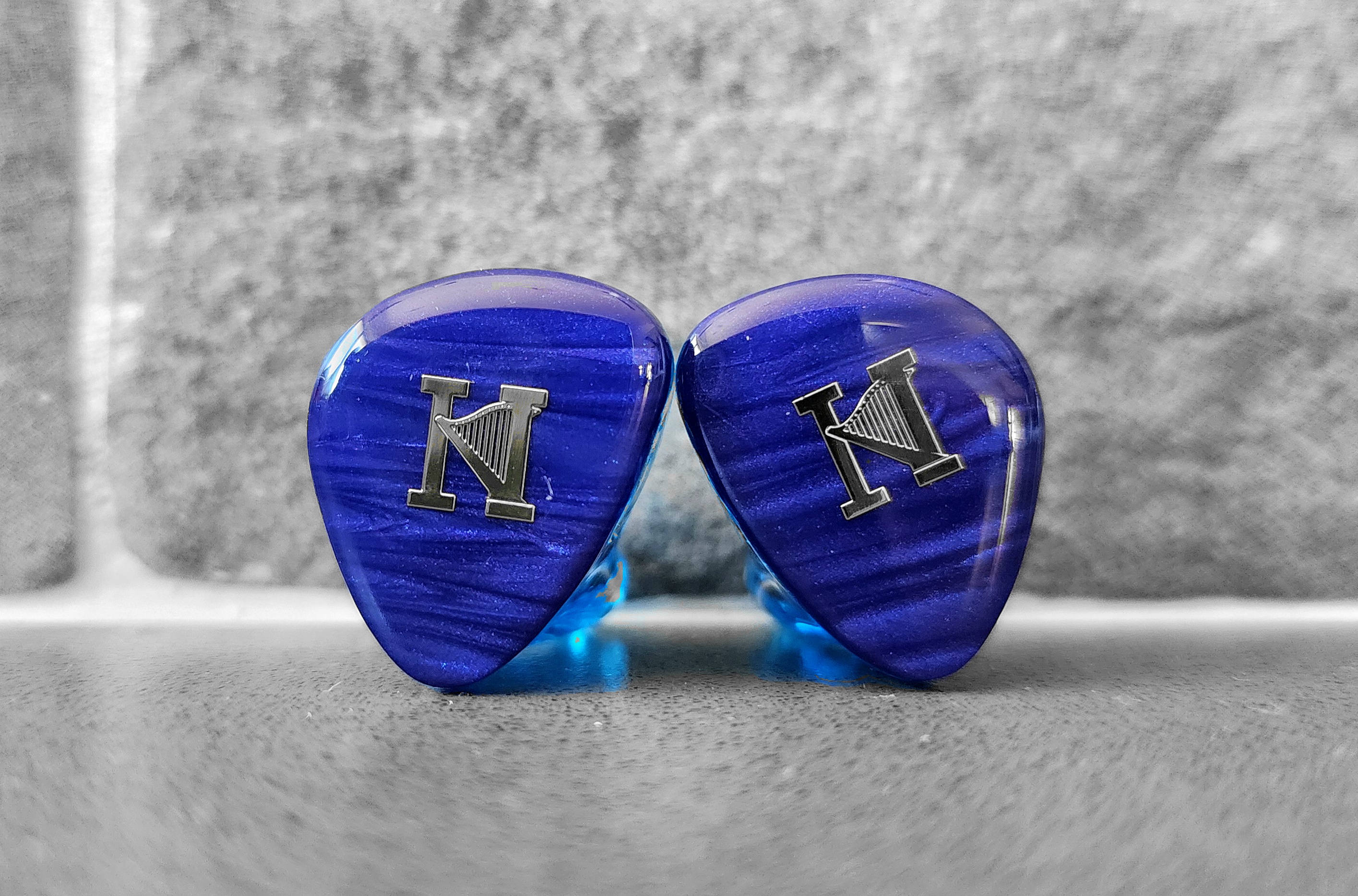
In conclusion:
The ISN H60 is a very interesting set. I wouldn't characterize it as an all-rounder, but when paired with the right tracks and genres, it can sound absolutely excellent! I would definitely recommend this set more for easy listening, relaxation, and simple audio enjoyment. It's not really made for dissecting the music or revealing every little detail. To my ear, it has somewhat of a "lo-fi" sound quality, but I really do mean that in the best way possible. It's just part of the H60's charm. The tuning is more musical in that it presents a smooth, pleasant, and forgiving experience; recording quality isn't as much of a factor as it is with other IEMs. Sure, you might miss some of the subtleties and nuances that are revealed with better technicalities, but I can almost guarantee that the music won't hit the same way and might not be as enjoyable. The best way I can describe the H60's tuning is that it takes me back to the days of portable CD players. When I first put the H60s in my ears and started some 90's alternative music, I was hit with a wave of nostalgia. Suddenly, I was 10 years old again, sitting on the floor of my brother's room, perusing his CD collection. Something about the sound quality brings me back to carrying a Discman and how music sounded back then, at least to my nostalgia-flooded brain. For me, the H60 shines fantastically with 80s/90s rock and alternative genres. That's not to say it sounds inherently bad with more modern music, but there is a bit of magic in the way it plays back those tracks from my childhood. In my opinion, the ISN H60 is for those who enjoy a lot of mid-bass. It's one of the more niche tunings I've come across so far. Because of this, I'm not sure I can give the H60 an outright recommendation. However, when you find the music it's best suited for, it truly shines. Sure, my enjoyment factor is quite high, but I do understand that this tuning has its limitations. The price-to-performance ratio is also lower than I would expect for the $349 MSRP, and the H60's technicalities are not its strong suit. It arguably overpriced in today's market, but I think fans of meaty mid-bass and a greater focus on the midrange will find that the ISN H60 truly is "mid" in the best possible way.

Dhaw
New Head-Fier
Pros: Punchy Dynamic sound
Excellent fast bass response
Good imaging and separation
Top class Timbre and tonality
Excellent rendition of both male and female vocals
Light and comfortable
Excellent fast bass response
Good imaging and separation
Top class Timbre and tonality
Excellent rendition of both male and female vocals
Light and comfortable
Cons: Some listeners might find the sound a little forceful.
The stock cable is adequate but can be improved upon. It has no ear hooks.
The stock cable is adequate but can be improved upon. It has no ear hooks.

Introduction
This H60 set by ISN has been provided for review through the Audio Geeks group and I will provide my best honest impression of this earphone. Thanks to ISN and Audio Geeks for arranging a tour in Australia.
The H60 sells for $349 USD and is a vented resin IEM shell containing 2x 8mm DDs for bass, 2x Sonion BAs for midrange and 2x Knowles BAs for treble.
Listening tests using a Hiby R3 player and lossless files thru a Cayin RU6 dac and my preferred Divinus Velvet wide bore ear tips. I used the stock cable and several cables from my collection.
Drivability
The H60 is very easy to drive. Using the Cayin RU6 at 36 produced a decent sound pressure. I reached ideal listening levels with 15% lower setting than I usually listen at. Another differentiator is feeding more volume in does not result in rewards. This set seems to have an easily reached optimum operating level and scaling it up is unnecessary. It's presentation is clear and energetic and unusually I found myself turning it DOWN on certain recordings. The H60 is an engaging set , delivering the music in an immediate and dynamic way. As such it is great for active listening. Rock and high energy music takes on a extra level of excitement.
Comfort.
The shells are light and fairly large, but I was able to get a very good fit with my preferred Divinus wide bore tips and once seated the IEMs can be worn for long sessions with no discomfort. They fit snugly and have a high level of passive isolation.
Personalisation.
I will always review an IEM as it sounds. I never use equalization with my personal sets. I will find synergy with cables tips and sources but tinkering with the frequency response is not my thing. I was not completely comfortable with the H60 when it arrived. It sounded too forceful. The pinna sound level was overwhelming and distracting. A forum member suggested a single small reduction of 1DB at the 1kHz level on my players equalizer. What have I got to lose I thought? Low and behold the sound levels improved across the board, with a balance that allowed me to focus on the music.

Sound impressions.
Bass.
Big, rich, beautifully and delicately textured. This is a full warm all enveloping bass that with the right song wraps you in a cozy blanket of sound. It's the quality of the bass that impresses with the H60. There is ample sub bass without being overwhelming. The balance of mid bass and the sheer correctness of the mix allows you to settle in and just enjoy the sound. Lose yourself to Dance by Daft Punk is nicely solid sounding without being overwhelming. Bassy but basshead levels? I like my bass and the H60 delivers for me. The hand claps and the punchy snappy mid bass delivers the perfect mix to my ears.
Midrange.
With its excellent tonality and open clarity the midrange excel with this IEM. My Cayin DAC adds just the right amount of warmth, and the slightly forward vocals are transparent and oh so natural sounding. The bass underpins the midrange with no bleed.
Seasons Song by Robert Plant from the album Carry Fire gives you this luxurious effect with a very yearning vocal from Robert and a smooth spread of guitars and backing vocals. Switching up to some indie rock with Middle Kids. The song Bend has singer Hannah's voice ranging from vulnerable and emotional to powerful in the chorus.
Treble.
The treble is well integrated with the midrange. It adds enough splash and details without any sibilance. It’s a smooth yet airy treble which compliments the balanced sound. I did not find any issues with the highs.

Soundstage/Separation
Width is just above average giving a good spread of instrumentation with a mildly forward vocal positioning. Combined with some decent depth the presentation is pleasingly expansive and not congested. Separation is excellent with this set. I can place instruments in the mix with precision. Good recordings reward your ears with accurate and faithful reproduction of the mix. Very monitor like.
Timbre and tonality.
Another attribute of the ISN H60 is its accurate portrayal of tones with instruments sounding natural and correct. Not exactly neutral because it has extra added warmth but both male and female voices sound impeccable. Pianos in particular sound wonderful with natural rounded notes and great decay. Guitars have resonance and tactile details. Drum kits sound like drum kits. By that I mean snares sound crisp and fast, cymbals shimmer with the right amount of sparkle and bass drums have punch and impact. The H60 can rock.

Conclusion.
The ISN H60 is going to be missed. Once I adapted to its dynamic sound presentation and explored my favourite tracks I was hooked. I began to appreciate that within that presentation all the subtleties and tonal fidelity meant this set was special.
MakeItWain
Previously known as SemperMalum
Pros: Pleasant warmer sound balance
Mids are the star of this show - instruments, vocals, all of it
Treble is extended very well - airy without being harsh
Comfortable (for my ears) fit
Bass performance is very solid - with the right tips and source
Good overall technical performance
Mids are the star of this show - instruments, vocals, all of it
Treble is extended very well - airy without being harsh
Comfortable (for my ears) fit
Bass performance is very solid - with the right tips and source
Good overall technical performance
Cons: Source/Synergy dependent: they want/crave power or you're going to get terrible performance
Sub-bass occasionally sounds like it takes a step back from the track/vocals
Smooth nozzle means some tips just don't work with it - I dislike smooth nozzles
Nozzle lip also measures differently all around
Marketing (Personal point)
Sub-bass occasionally sounds like it takes a step back from the track/vocals
Smooth nozzle means some tips just don't work with it - I dislike smooth nozzles
Nozzle lip also measures differently all around
Marketing (Personal point)
TL;DR: Another warm, relaxing alternative
Overview/History
Hi all.
Back again with another review. This time, we're looking at the ISN H60. For anyone familiar with the company Penon Audio, ISN is essentially a sister company so you're mainly going to find this release on Penon Audio's website or their AliExpress store.
I've been fortunate enough to demo/review this as part of a tour group. Pictures are going to be lighter than normal in this case as it's a very, very general straightforward IEM experience but, overall, I'm glad I was given the opportunity to check these out. Penon Audio/ISN releases have been very hyped - with some questionable marketing out there - and I've had my entire expectations demolished when I finally had a chance to listen to the Penon Fan 3, Shock and the Rival over CanJam weekend. Without further adieu, let's get into the ISN H60.

The ISN H60 is a $349 IEM release from Penon Audio/ISN that has 4BA and 2DD. The 2 DDs are 8mm while the BAs are a mixture of Sonion and Knowles branded BAs which reflects well on the build quality and internal components.
Specifications from Penon Audio's website so you don't have to look:
Disclaimers: The ISN H60 was sent to me as part of a tour from Audio Geek US Tour Group. I would like to thank Nenad (not sure if you're on Head-Fi, sir, I'll update if I find your username on there) and the Audio Geek moderation team/group as a whole for the chance to listen and review. While I've been given this unit in exchange for a review, I was provided no instructions or guidance on what I write or how I review so the following is all 100% my own subjective take.
Build Quality, Comfort and Accessories
Photo dump time!




The ISN H60 is a very straightforward no frills IEM. The box provided to me was actually the H30's (per discussion with person handling the tour) box but this is the H60. I only received the cable and the IEM itself. I actually enjoy the translucent shell and it looks very nice.





The nozzle lip is, unfortunately, smooth and measures weirdly. I'm not sure if this just how it's designed? Pictures to show but I measured the nozzle lip anywhere between 6.8, 6.9 and 7.0mm.



Left IEM had range of 6.8mm and 6.9mm. Right IEM had the extra variance. All I did was turn it and re-measure.


7.0mm which puts this as the largest nozzle lip I've tried for any IEM. It's edged out others like the Truthear Zero Red and the FatFreq Deuce.
Still, getting around the nozzle lip side, I was able to use some grippier tips (Dunu S&S, Fiio HS20) to get a good enough comfortable seal.
Tip Rolling
So, with the nozzle lip being 7.0mm, this unfortunately meant that I wasn't able to use some of my favorite tips. But, I was able to find a few that worked for me.
Dunu S&S: The best tips for me in this case. Dunu S&S tips are my second workhorse after the Final Type E. This gave me a slightly bigger sound stage and a bit more body in the mid-bass from what it sounded/felt like.
Fiio HS20: These tips worked out very well but felt like they were stretching out the eartip due to the size. Still, seal was good and I think it worked very well.
Pentacon Coreir - Brass: I think a set like the Pentacon (if you have it) would work out well for this larger nozzle. I didn't prefer the brass as much as the Dunu S&S but it sealed well without feeling like anything was warping. Bass performance wasn't as good as the S&S but helped sweeten the mids/treble a smidge. AL Alloy version of the Coreir was a bit better for the bass for sheer impact.
Cable
Stock cable with the H60 is solid.

It's not a bad cable but I'm not a fan of the lack of an earhook being on there to keep the cable from moving behind my ear. This is my own nitpick, though. Otherwise, it works decently. Not the worst stock cable I've handled.
Sound
So, how does the H60 sound?

The ISN H60 comes off as very balanced/warm without any super true issues that I could find. As a whole, I was pleasantly surprised by the H60 especially given the amount of people that really, really love it. I'll touch on it later, though, but my initial impressions were disappointment until I swapped to a higher level source and put more power through it.
Gear Tested On: Primarily streamed music via either dedicated Streamer, Laptop or Phone
Phone chain: Pixel 8 Pro -> Abigail Pro
Streamed Music Chain Workstation: Raspberry Pi4 w/ Volumio -> JDS Labs Element 3 MK2 (Boosted)
Streamed Music chain: WiiM Mini -> JDS Labs Atom DAC+ -> JDS Labs OL Switcher -> Geshelli Labs Archel 3 Pro
*My Audio Preference and Score Disclaimer*: To preface my breakdown, here's my sound preference. I tend to prefer warmer sound. I enjoy good sub-bass extension with enough mid-bass to feel the music. I prefer more fuller sounding mids to match my library. My preference is for smooth treble extension; while I'm not treble sensitive, I'd probably lean more towards 'safer' treble tuning for longer listening. I also tend to listen at either medium to louder listening volumes (reasonably loud).
In addition, all scores listed below are typically (unless otherwise stated) rated/scored as it relates to it's peers in the same price group.
Lows/Bass: The bass for the H60 is actually very solid with good detail and quality provided. I find that this is more emphasized by on the mid-bass but not distractingly so.
Sub-bass doesn't go as deep as some other IEMs but it retains good detail and will open up depending on the tracks that do call for it. Mid-bass is where it excels the most with good punch and impact. Decay isn't unnaturally fast so the notes linger well enough to feel more musical.
As noted, I think my only real issue with the bass comes from the sub-bass roll off and the H60 does occasionally sound subdued on the bass notes like it's taking a step back from the mid range, instruments and vocals. Some people may prefer this more as it makes the mid-bass pop out more.
Bass Score: 8/10 - TL;DR: Great detail and quality, generally good mid-bass punch. Sub-bass is a bit rolled off for my tastes but it's a nice warm set. Sub-bass will occasionally lack some impact depending on tracks so it either wakes up and is present or it's sleeping behind the mids.
Mids: Absolutely great performance from the mids. This is probably where the H60 shines the most for me. Penon Audio is generally widely praised for their mids performance and it's safe to say that this carried over with the H60.
Vocals are very natural sounding with great warmth and fullness in the male vocals and proper elevation in female vocals. Notes have great weight when called for and proper air when the track plays that back.
I think the instruments are where the H60 perform the best with really good detail that shine through and allow you to fully enjoy piano, guitars, bass strings - nothing sounded lacking at all.

Mids Score: 9/10 - TL;DR: Great mid-range note weight, male vocals are great and female vocals are emphasized well. Instruments are great with emphasis on detail and sounding natural
Treble: The treble for the H60 has good energy and elevation. It doesn't hit me with the same element of control that the mids have but it's handled very well.
There's solid treble detail for the remnants of instruments. Even at higher volumes, the H60 never gets sharp or sibilant. It's very smooth and controlled.
I do find that there were some times (more modern music or with an EDM element or anything emphasizing drums a lot) where everything sounded very smooth but the sparkle/energy of certain notes (cymbals, etc.) would stick out a bit unnaturally. It's more on the subdued side versus any energetic spike that clouds the listening experience so it's not distracting or anything. It's just there.
Treble Score: 8.5/10 - TL;DR: Good treble extension; energy is there without being harsh save for certain notes occasionally coming through in a way to wake up the track.
Detail, Separation, Imaging, Overall Soundstage, Etc.: One thing that really surprised me about the H60 is that while it's a very warm, musical set, you still get good technical performance. I don't think it's better than a lot of the competition but it helps with the overall listening experience.
Details shine and pop overall from bass to treble. Instrument separation and imaging is very well done. It's not exactly precise to a T but it goes hand in hand with the warm presentation so you wouldn't feel like you're getting a dark or sloppy set.
Sound stage is probably the weakest point - there's decent width but everything feels very linear with the presentation. But, everything else is very well handled.
Technicalities Score: 8.5/10 - TL;DR: Great technical performance, good sound stage imaging and separation are very well executed and way above the price point
Library Hit List: Anything where I typically want to have more instrument or mid performance is where the H60 works out the best.
Bastille feat. Hans Zimmer - "Pompeii MMXXIII" (Absolutely great build up, instruments and male vocals)
AC/DC - "Thunderstruck" (guitar, drums, bass - easy to get lost in the music with this one with the H60)
Camille - "Le Festin" (proper air for female vocals, perfect amount of sparkle to compliment the track)
Florence + The Machine - "Dog Days Are Over" (good separation, great female vocals that are airy without being shouty, very engaging)
Franz Ferdinand - "Take Me Out" (great rock music, good details for all the instruments)
The Shins - "Simple Song" (handles some of the synth aspects very well, good impact and detail on the bass lines)
Guns N' Roses - "Sweet Child o' Mine" (great energy on guitar, handles vocals perfectly here, great instrument separation)
The Seatbelts - "Tank" (great imaging and separation here)
Stevie Wonder - "Sir Duke" (good playback on vocals, good imaging for the big band feel)
Fleetwood Mac - "Rumors" (great separation, good details on the instruments, handles Stevie Nicks vocals well)
Comparisons: Quick comparison I wanted to make is against it's sibling: the Penon Fan 3.
Penon Fan 3: As a spoiler alert, I am going to eventually review the Fan 3 but it's currently on loan. I did do some A/B vs the H60 and the Fan 3 and my notes came back that I like the Fan 3 more. That's it. Comparison done.

But, in all seriousness, I think the Fan 3 actually has more of that 'Wow' factor. Bass feels a bit deeper, mids feel more immersive with the BCD on, treble feels smoother overall without that odd occasional 'hitch'. I'd say the H60 is probably more balanced than the Fan 3 but the Fan 3 is more engaging. Fan 3 > H60.
Other Things to be aware of:
So, before I get into volume or source points, I do want to touch on the marketing. I understand that this is what works for Penon. I truly do. I'm just not the biggest fan of needing to join a mailer in order to get a 'promotional code' which can drop the price. I feel like if the price for an item can regularly go for a certain amount, why not price it there? I don't want to get on a soapbox for it but it comes off a bit different.
Volume Listening: So, I found the H60 worked best at moderate/higher volume listening. It's smooth enough that you can really crank up the volume without getting any true issues on the treble or upper mids. It does help with the bass as well doing so. Otherwise, moderate volume will be musical still and very engaging.
Source Synergy: The H60 -needs power to thrive. While I was able to use an Abigail Pro in order to listen to it (and it is technically easy to drive), I felt like the H60 was super flat especially on the bass side. Everything sounded very anemic and concerning. I even went up to the K11 R2R (that I'm currently trying out) and the Single ended output sounded only a little bit better than the Abigail Pro.
Switching to the JDS Element 3 and the K11 R2R's balanced output, though, changed everything and is the only way I can really recommend listening to the H60. I'm currently without a more powerful dongle/dac for testing so I don't know the threshold that the H60 needs in order to sound good but I genuinely don't think you can get away with just an Apple dongle.

Special Sauce/Personal Bias Score: 8/10 - TL;DR: You'll want to sign up for their mailer; marketing practices are a bit... 'aggressive'? Or confusing? Or particular? For people that don't mind holding out/reaching out to try and secure discounts, this is the way you'd want to do it to secure a Penon/ISN product. In the end, you do get a very good IEM that does things differently than standard releases. Just be aware of the source you're using.
Conclusion: Overall, I think the ISN H60 is a very good IEM. It provides a very warm but still balanced presentation to music with good technical performance. There's a musical quality to the H60 but it still remains very engaging. I definitely understand the hype around it and consider me a... fan of it.

I don't think the H60 would be my go-to recommendation (against like it's sibling the Fan 3) but I think it competes well and is different enough to warrant some considerations for anyone that wants a step up in a warmly tuned IEM. Just make sure you sign up for their mailer.

Final Weighted Score: 8.4/10 - Score received is a 4.2 from me which firmly places it as a very good 4 star IEM.
Final Score (on the Guud scale): dis be pretty guuuud
Thanks for reading!
Overview/History
Hi all.
Back again with another review. This time, we're looking at the ISN H60. For anyone familiar with the company Penon Audio, ISN is essentially a sister company so you're mainly going to find this release on Penon Audio's website or their AliExpress store.
I've been fortunate enough to demo/review this as part of a tour group. Pictures are going to be lighter than normal in this case as it's a very, very general straightforward IEM experience but, overall, I'm glad I was given the opportunity to check these out. Penon Audio/ISN releases have been very hyped - with some questionable marketing out there - and I've had my entire expectations demolished when I finally had a chance to listen to the Penon Fan 3, Shock and the Rival over CanJam weekend. Without further adieu, let's get into the ISN H60.
The ISN H60 is a $349 IEM release from Penon Audio/ISN that has 4BA and 2DD. The 2 DDs are 8mm while the BAs are a mixture of Sonion and Knowles branded BAs which reflects well on the build quality and internal components.
Specifications from Penon Audio's website so you don't have to look:
- 4 Balanced Armature + 2 Dynamic driver hybrid
- 2 x Knowles Balanced Armature for high frequency
- 2 x Sonion Balanced Armature for middle frequency
- 2 x 8mm liquid silicone gel diaphragm for low frequency
- 3-way crossover
- Impedance: 18ohm ± 10%
- Sensitivity: 112 @ 1KHZ
- Frequency response: 5Hz-40kHz
Disclaimers: The ISN H60 was sent to me as part of a tour from Audio Geek US Tour Group. I would like to thank Nenad (not sure if you're on Head-Fi, sir, I'll update if I find your username on there) and the Audio Geek moderation team/group as a whole for the chance to listen and review. While I've been given this unit in exchange for a review, I was provided no instructions or guidance on what I write or how I review so the following is all 100% my own subjective take.
Build Quality, Comfort and Accessories
Photo dump time!
The ISN H60 is a very straightforward no frills IEM. The box provided to me was actually the H30's (per discussion with person handling the tour) box but this is the H60. I only received the cable and the IEM itself. I actually enjoy the translucent shell and it looks very nice.
The nozzle lip is, unfortunately, smooth and measures weirdly. I'm not sure if this just how it's designed? Pictures to show but I measured the nozzle lip anywhere between 6.8, 6.9 and 7.0mm.
Left IEM had range of 6.8mm and 6.9mm. Right IEM had the extra variance. All I did was turn it and re-measure.
7.0mm which puts this as the largest nozzle lip I've tried for any IEM. It's edged out others like the Truthear Zero Red and the FatFreq Deuce.
Still, getting around the nozzle lip side, I was able to use some grippier tips (Dunu S&S, Fiio HS20) to get a good enough comfortable seal.
Tip Rolling
So, with the nozzle lip being 7.0mm, this unfortunately meant that I wasn't able to use some of my favorite tips. But, I was able to find a few that worked for me.
Dunu S&S: The best tips for me in this case. Dunu S&S tips are my second workhorse after the Final Type E. This gave me a slightly bigger sound stage and a bit more body in the mid-bass from what it sounded/felt like.
Fiio HS20: These tips worked out very well but felt like they were stretching out the eartip due to the size. Still, seal was good and I think it worked very well.
Pentacon Coreir - Brass: I think a set like the Pentacon (if you have it) would work out well for this larger nozzle. I didn't prefer the brass as much as the Dunu S&S but it sealed well without feeling like anything was warping. Bass performance wasn't as good as the S&S but helped sweeten the mids/treble a smidge. AL Alloy version of the Coreir was a bit better for the bass for sheer impact.
Cable
Stock cable with the H60 is solid.
It's not a bad cable but I'm not a fan of the lack of an earhook being on there to keep the cable from moving behind my ear. This is my own nitpick, though. Otherwise, it works decently. Not the worst stock cable I've handled.
Sound
So, how does the H60 sound?
The ISN H60 comes off as very balanced/warm without any super true issues that I could find. As a whole, I was pleasantly surprised by the H60 especially given the amount of people that really, really love it. I'll touch on it later, though, but my initial impressions were disappointment until I swapped to a higher level source and put more power through it.
Gear Tested On: Primarily streamed music via either dedicated Streamer, Laptop or Phone
Phone chain: Pixel 8 Pro -> Abigail Pro
Streamed Music Chain Workstation: Raspberry Pi4 w/ Volumio -> JDS Labs Element 3 MK2 (Boosted)
Streamed Music chain: WiiM Mini -> JDS Labs Atom DAC+ -> JDS Labs OL Switcher -> Geshelli Labs Archel 3 Pro
*My Audio Preference and Score Disclaimer*: To preface my breakdown, here's my sound preference. I tend to prefer warmer sound. I enjoy good sub-bass extension with enough mid-bass to feel the music. I prefer more fuller sounding mids to match my library. My preference is for smooth treble extension; while I'm not treble sensitive, I'd probably lean more towards 'safer' treble tuning for longer listening. I also tend to listen at either medium to louder listening volumes (reasonably loud).
In addition, all scores listed below are typically (unless otherwise stated) rated/scored as it relates to it's peers in the same price group.
Lows/Bass: The bass for the H60 is actually very solid with good detail and quality provided. I find that this is more emphasized by on the mid-bass but not distractingly so.
Sub-bass doesn't go as deep as some other IEMs but it retains good detail and will open up depending on the tracks that do call for it. Mid-bass is where it excels the most with good punch and impact. Decay isn't unnaturally fast so the notes linger well enough to feel more musical.
As noted, I think my only real issue with the bass comes from the sub-bass roll off and the H60 does occasionally sound subdued on the bass notes like it's taking a step back from the mid range, instruments and vocals. Some people may prefer this more as it makes the mid-bass pop out more.
Bass Score: 8/10 - TL;DR: Great detail and quality, generally good mid-bass punch. Sub-bass is a bit rolled off for my tastes but it's a nice warm set. Sub-bass will occasionally lack some impact depending on tracks so it either wakes up and is present or it's sleeping behind the mids.
Mids: Absolutely great performance from the mids. This is probably where the H60 shines the most for me. Penon Audio is generally widely praised for their mids performance and it's safe to say that this carried over with the H60.
Vocals are very natural sounding with great warmth and fullness in the male vocals and proper elevation in female vocals. Notes have great weight when called for and proper air when the track plays that back.
I think the instruments are where the H60 perform the best with really good detail that shine through and allow you to fully enjoy piano, guitars, bass strings - nothing sounded lacking at all.
Mids Score: 9/10 - TL;DR: Great mid-range note weight, male vocals are great and female vocals are emphasized well. Instruments are great with emphasis on detail and sounding natural
Treble: The treble for the H60 has good energy and elevation. It doesn't hit me with the same element of control that the mids have but it's handled very well.
There's solid treble detail for the remnants of instruments. Even at higher volumes, the H60 never gets sharp or sibilant. It's very smooth and controlled.
I do find that there were some times (more modern music or with an EDM element or anything emphasizing drums a lot) where everything sounded very smooth but the sparkle/energy of certain notes (cymbals, etc.) would stick out a bit unnaturally. It's more on the subdued side versus any energetic spike that clouds the listening experience so it's not distracting or anything. It's just there.
Treble Score: 8.5/10 - TL;DR: Good treble extension; energy is there without being harsh save for certain notes occasionally coming through in a way to wake up the track.
Detail, Separation, Imaging, Overall Soundstage, Etc.: One thing that really surprised me about the H60 is that while it's a very warm, musical set, you still get good technical performance. I don't think it's better than a lot of the competition but it helps with the overall listening experience.
Details shine and pop overall from bass to treble. Instrument separation and imaging is very well done. It's not exactly precise to a T but it goes hand in hand with the warm presentation so you wouldn't feel like you're getting a dark or sloppy set.
Sound stage is probably the weakest point - there's decent width but everything feels very linear with the presentation. But, everything else is very well handled.
Technicalities Score: 8.5/10 - TL;DR: Great technical performance, good sound stage imaging and separation are very well executed and way above the price point
Library Hit List: Anything where I typically want to have more instrument or mid performance is where the H60 works out the best.
Bastille feat. Hans Zimmer - "Pompeii MMXXIII" (Absolutely great build up, instruments and male vocals)
AC/DC - "Thunderstruck" (guitar, drums, bass - easy to get lost in the music with this one with the H60)
Camille - "Le Festin" (proper air for female vocals, perfect amount of sparkle to compliment the track)
Florence + The Machine - "Dog Days Are Over" (good separation, great female vocals that are airy without being shouty, very engaging)
Franz Ferdinand - "Take Me Out" (great rock music, good details for all the instruments)
The Shins - "Simple Song" (handles some of the synth aspects very well, good impact and detail on the bass lines)
Guns N' Roses - "Sweet Child o' Mine" (great energy on guitar, handles vocals perfectly here, great instrument separation)
The Seatbelts - "Tank" (great imaging and separation here)
Stevie Wonder - "Sir Duke" (good playback on vocals, good imaging for the big band feel)
Fleetwood Mac - "Rumors" (great separation, good details on the instruments, handles Stevie Nicks vocals well)
Comparisons: Quick comparison I wanted to make is against it's sibling: the Penon Fan 3.
Penon Fan 3: As a spoiler alert, I am going to eventually review the Fan 3 but it's currently on loan. I did do some A/B vs the H60 and the Fan 3 and my notes came back that I like the Fan 3 more. That's it. Comparison done.
But, in all seriousness, I think the Fan 3 actually has more of that 'Wow' factor. Bass feels a bit deeper, mids feel more immersive with the BCD on, treble feels smoother overall without that odd occasional 'hitch'. I'd say the H60 is probably more balanced than the Fan 3 but the Fan 3 is more engaging. Fan 3 > H60.
Other Things to be aware of:
So, before I get into volume or source points, I do want to touch on the marketing. I understand that this is what works for Penon. I truly do. I'm just not the biggest fan of needing to join a mailer in order to get a 'promotional code' which can drop the price. I feel like if the price for an item can regularly go for a certain amount, why not price it there? I don't want to get on a soapbox for it but it comes off a bit different.
Volume Listening: So, I found the H60 worked best at moderate/higher volume listening. It's smooth enough that you can really crank up the volume without getting any true issues on the treble or upper mids. It does help with the bass as well doing so. Otherwise, moderate volume will be musical still and very engaging.
Source Synergy: The H60 -needs power to thrive. While I was able to use an Abigail Pro in order to listen to it (and it is technically easy to drive), I felt like the H60 was super flat especially on the bass side. Everything sounded very anemic and concerning. I even went up to the K11 R2R (that I'm currently trying out) and the Single ended output sounded only a little bit better than the Abigail Pro.
Switching to the JDS Element 3 and the K11 R2R's balanced output, though, changed everything and is the only way I can really recommend listening to the H60. I'm currently without a more powerful dongle/dac for testing so I don't know the threshold that the H60 needs in order to sound good but I genuinely don't think you can get away with just an Apple dongle.
Special Sauce/Personal Bias Score: 8/10 - TL;DR: You'll want to sign up for their mailer; marketing practices are a bit... 'aggressive'? Or confusing? Or particular? For people that don't mind holding out/reaching out to try and secure discounts, this is the way you'd want to do it to secure a Penon/ISN product. In the end, you do get a very good IEM that does things differently than standard releases. Just be aware of the source you're using.
Conclusion: Overall, I think the ISN H60 is a very good IEM. It provides a very warm but still balanced presentation to music with good technical performance. There's a musical quality to the H60 but it still remains very engaging. I definitely understand the hype around it and consider me a... fan of it.
I don't think the H60 would be my go-to recommendation (against like it's sibling the Fan 3) but I think it competes well and is different enough to warrant some considerations for anyone that wants a step up in a warmly tuned IEM. Just make sure you sign up for their mailer.
Final Weighted Score: 8.4/10 - Score received is a 4.2 from me which firmly places it as a very good 4 star IEM.
Final Score (on the Guud scale): dis be pretty guuuud
Thanks for reading!
Last edited:
Ranjan H
New Head-Fier
Detailed Review of ISN Audio H60
Disclaimer :
The ISN Audio H60 that I received is a part of Worldwide Tour initiated by " Audio Geek _ Brotherhood Of Audiophiles ".
Introduction :
ISN Audio H60 is a Hybrid IEM which consists of :-
2 * 8mm Liquid Silicone gel Diaphragm DD for the Low
Frequency
2 * Knowles BA for High Frequency and another
2 * Sonion BA for the Mids.
It has a 3 way Crossover, with an Impedence of 18 Ohms and a
Sensitivity of 112 dB with a price tag of US$ 349.
Build and Comfort :
The Shell is made up of Medical Grade resin material. They are light and very comfortable to wear although the Nozzle size is on the bigger side.
Note :
My Review is done by using Effect Audio Eros S upgrade Cable along with Divinus Velvet Wide Bore Eartips.
Sound Impressions :
BASS :
First of all this is a Bass boosted IEM, where the Subbass anad Midbass are on par with each other. Nonetheless the quantity are also enormous. It has got a Thick, Big and Bold Subbass but not so Authoritative. The Rumble on the H60 is more than enough to give somebody a bone chilling effect.
Moreover the Bass are on the Tighter side and the Midbass aren't behind. It Slams and Hits hard too. Due to its Tighter nature of the Bass, it doesn't bleeds into the Mids.
The Plus point of the H60 is that, its Low Frequency region are so satisfying to listen.
MIDS :
On first listen, it seems like a proper V - Shape IEM, but upon critical listening I found that the Vocals are placed a little bit forward from the center point, which in return gives a very pleasing sound to my ears. Vocals and Instruments sounds very much close to Natural.
Since H60 is on the Warmer side, with somewhat Boosted Bass, I sometimes feel the Subbass overpower on most of the tracks that i tried. But its not a big issue, thinking a Basshead would Love this particular IEM.
The Snare Drum hits hard and the Kick Drum Slams and Thumps harder too.
Treble :
I find the treble of H60 a little bit on the Smoother side. This is good for long listening session. High hats and Cymbal strike aren't so prominent. But don't just sway away by its smoothness, it still possess a clear and a little bit of sparkle on the Upper Treble region, which I thought brings life to H60 without ever becoming Harsh or Fatiguing.
Technical Aspects :
Soundstage isn't so Wide nor Intimate, its average. It suffers a little on Details and Resolution, might be due to its smoother nature. I'm longing for that tiny little nuances, but its not a big deal, still it can retrieve most of the details and I would say the resolution are quite good for its price point.
Layering is quite good, can easily feel the depth and distance between the instruments. But suffers a little bit on Imaging. On some Busy and Heavy tracks, I find some sort of claustrophobic, but its doing quite good on rest of the tracks that I tried. I think its just a nitpick.
Conclusion :
ISN H60 is a very Fun sounding IEM. The best part is in its Low Frequency region, although both the Subbass and Midbass overpower on certain tracks, still the vocals and instruments are very pleasing to listen.
For the price its a very good and a capable IEM. Above all its a very forgiving IEM too.
Disclaimer :
The ISN Audio H60 that I received is a part of Worldwide Tour initiated by " Audio Geek _ Brotherhood Of Audiophiles ".
Introduction :
ISN Audio H60 is a Hybrid IEM which consists of :-
2 * 8mm Liquid Silicone gel Diaphragm DD for the Low
Frequency
2 * Knowles BA for High Frequency and another
2 * Sonion BA for the Mids.
It has a 3 way Crossover, with an Impedence of 18 Ohms and a
Sensitivity of 112 dB with a price tag of US$ 349.
Build and Comfort :
The Shell is made up of Medical Grade resin material. They are light and very comfortable to wear although the Nozzle size is on the bigger side.
Note :
My Review is done by using Effect Audio Eros S upgrade Cable along with Divinus Velvet Wide Bore Eartips.
Sound Impressions :
BASS :
First of all this is a Bass boosted IEM, where the Subbass anad Midbass are on par with each other. Nonetheless the quantity are also enormous. It has got a Thick, Big and Bold Subbass but not so Authoritative. The Rumble on the H60 is more than enough to give somebody a bone chilling effect.
Moreover the Bass are on the Tighter side and the Midbass aren't behind. It Slams and Hits hard too. Due to its Tighter nature of the Bass, it doesn't bleeds into the Mids.
The Plus point of the H60 is that, its Low Frequency region are so satisfying to listen.
MIDS :
On first listen, it seems like a proper V - Shape IEM, but upon critical listening I found that the Vocals are placed a little bit forward from the center point, which in return gives a very pleasing sound to my ears. Vocals and Instruments sounds very much close to Natural.
Since H60 is on the Warmer side, with somewhat Boosted Bass, I sometimes feel the Subbass overpower on most of the tracks that i tried. But its not a big issue, thinking a Basshead would Love this particular IEM.
The Snare Drum hits hard and the Kick Drum Slams and Thumps harder too.
Treble :
I find the treble of H60 a little bit on the Smoother side. This is good for long listening session. High hats and Cymbal strike aren't so prominent. But don't just sway away by its smoothness, it still possess a clear and a little bit of sparkle on the Upper Treble region, which I thought brings life to H60 without ever becoming Harsh or Fatiguing.
Technical Aspects :
Soundstage isn't so Wide nor Intimate, its average. It suffers a little on Details and Resolution, might be due to its smoother nature. I'm longing for that tiny little nuances, but its not a big deal, still it can retrieve most of the details and I would say the resolution are quite good for its price point.
Layering is quite good, can easily feel the depth and distance between the instruments. But suffers a little bit on Imaging. On some Busy and Heavy tracks, I find some sort of claustrophobic, but its doing quite good on rest of the tracks that I tried. I think its just a nitpick.
Conclusion :
ISN H60 is a very Fun sounding IEM. The best part is in its Low Frequency region, although both the Subbass and Midbass overpower on certain tracks, still the vocals and instruments are very pleasing to listen.
For the price its a very good and a capable IEM. Above all its a very forgiving IEM too.
Attachments
-
 IMG_20241012_191837.jpg6.2 MB · Views: 0
IMG_20241012_191837.jpg6.2 MB · Views: 0 -
 IMG_20241013_132229.jpg4.9 MB · Views: 0
IMG_20241013_132229.jpg4.9 MB · Views: 0 -
 IMG_20241015_165753.jpg5.3 MB · Views: 0
IMG_20241015_165753.jpg5.3 MB · Views: 0 -
 IMG_20241015_170140.jpg6.6 MB · Views: 0
IMG_20241015_170140.jpg6.6 MB · Views: 0 -
 IMG_20241015_170204.jpg5 MB · Views: 0
IMG_20241015_170204.jpg5 MB · Views: 0 -
 IMG_20241015_170303.jpg6.6 MB · Views: 0
IMG_20241015_170303.jpg6.6 MB · Views: 0 -
 IMG_20241015_170442.jpg6 MB · Views: 0
IMG_20241015_170442.jpg6 MB · Views: 0 -
 IMG_20241015_170719.jpg7.5 MB · Views: 0
IMG_20241015_170719.jpg7.5 MB · Views: 0 -
 IMG_20241015_170758.jpg6.7 MB · Views: 0
IMG_20241015_170758.jpg6.7 MB · Views: 0 -
 IMG_20241015_170846.jpg5.7 MB · Views: 0
IMG_20241015_170846.jpg5.7 MB · Views: 0 -
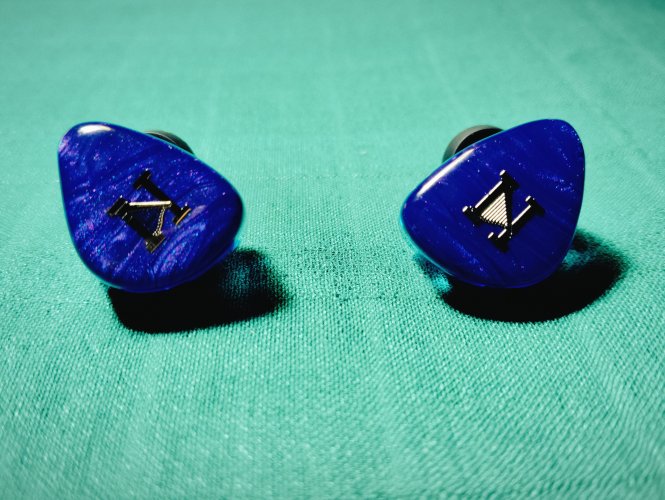 IMG_20241015_171055.jpg5.9 MB · Views: 0
IMG_20241015_171055.jpg5.9 MB · Views: 0 -
 IMG_20241015_171234.jpg7.2 MB · Views: 0
IMG_20241015_171234.jpg7.2 MB · Views: 0 -
 IMG_20241015_171340.jpg6.7 MB · Views: 0
IMG_20241015_171340.jpg6.7 MB · Views: 0
o0genesis0o
@Ranjan H You can edit your review article by clicking on the edit button at the end.
o0genesis0o
Headphoneus Supremus
Pros: + Pleasant neutral-warm tonality
+ Decent Resolution
+ Wide soundstage
+ Tight, thumpy bass response
+ Decent Resolution
+ Wide soundstage
+ Tight, thumpy bass response
Cons: - Stage depth could be improved
- Micro details could be improved
- Treble could sound a bit splashy and truncated with some recordings
- Dynamic and the sense of rhythm can feel a bit lacking with some tracks
- Micro details could be improved
- Treble could sound a bit splashy and truncated with some recordings
- Dynamic and the sense of rhythm can feel a bit lacking with some tracks
ISN Audio H60 has received quite a bit of hype across personal audio communities. Finally, this IEM lands on my review desk. Has the hype been justified? Read on, my friends.
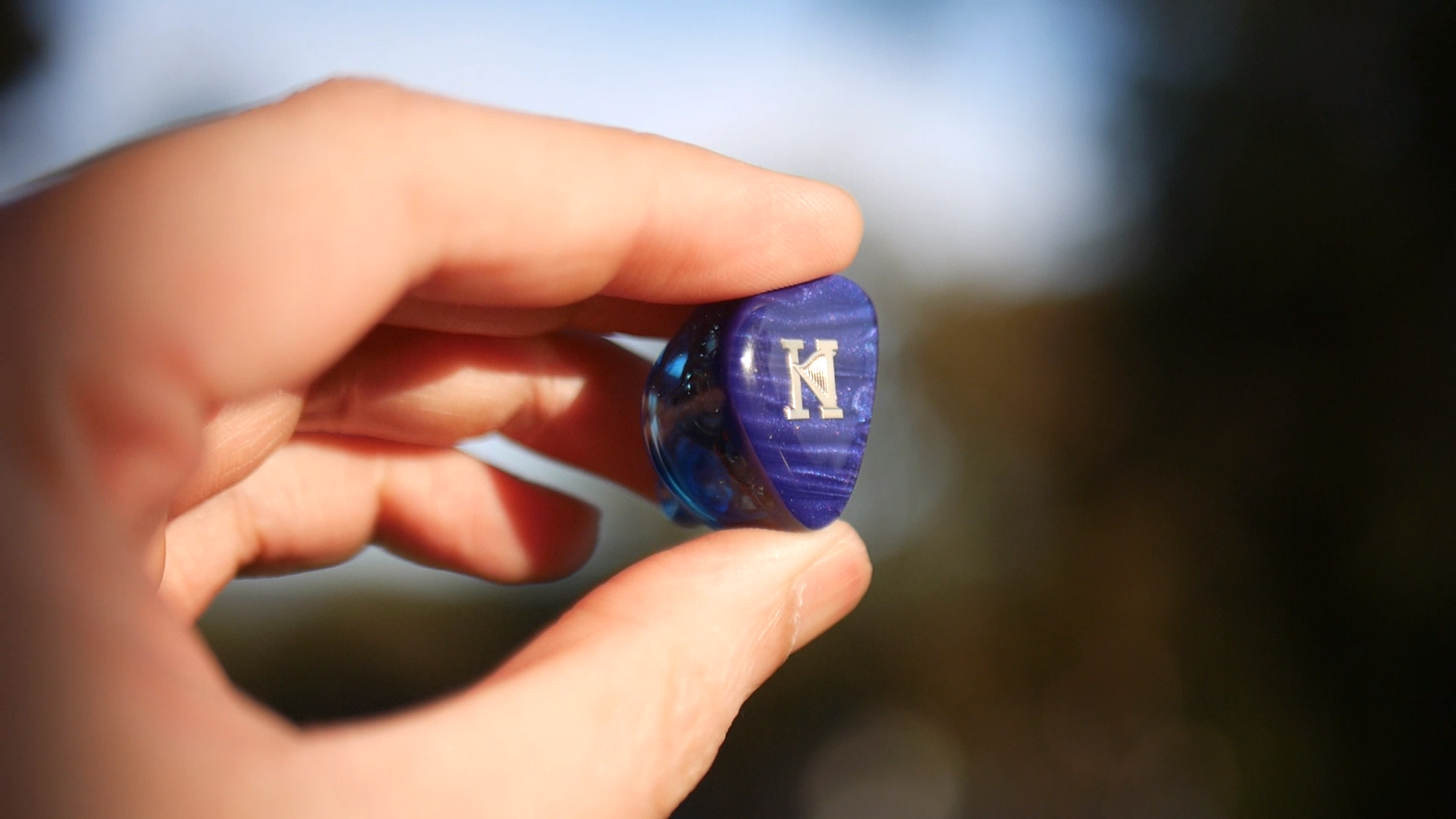
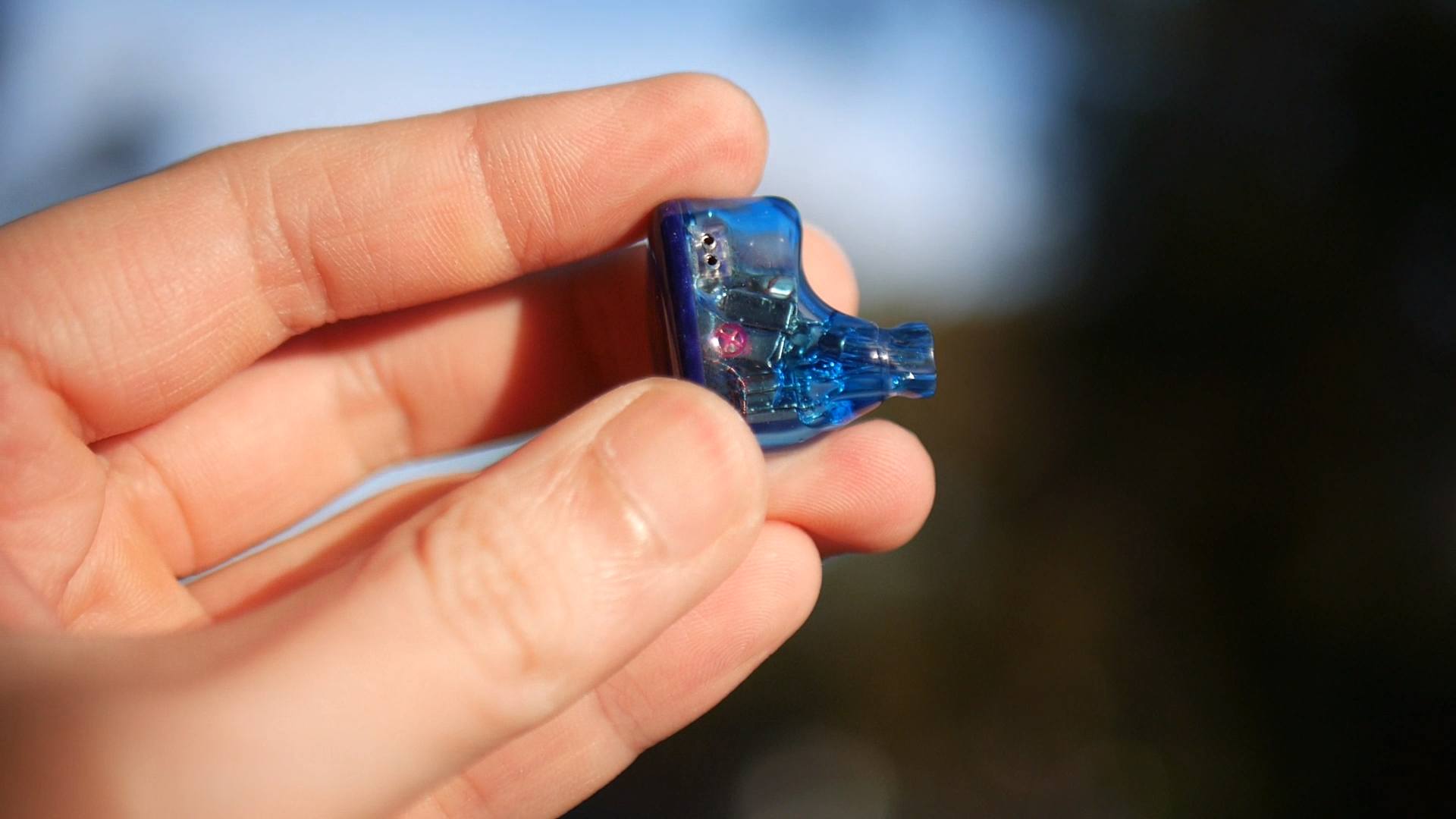
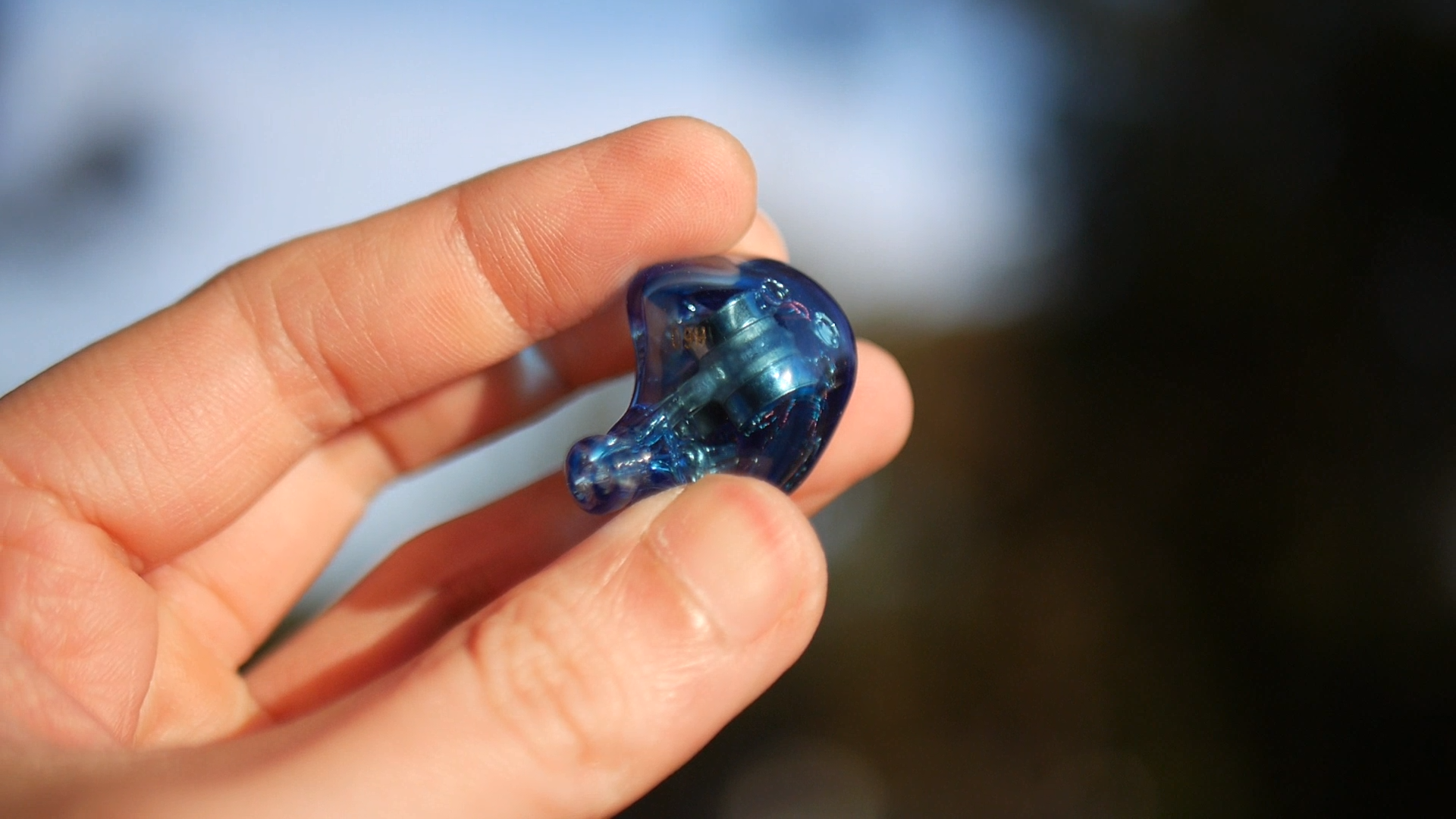
The nozzles of H60 are on the larger side. Fortunately, they have adequate length to avoid any fit problem. That said, you might need to experiment with eartips types and sizes to find the one that offer the right combination of comfort and sound quality.
I use Divinus Velvet Wide Bore eartips across my listening sessions with H60. Due to the large nozzles, my ear canal does get fatigued in longer sessions that last more than an hour. On the plus side, I did not experience any pressure build up during my tests.
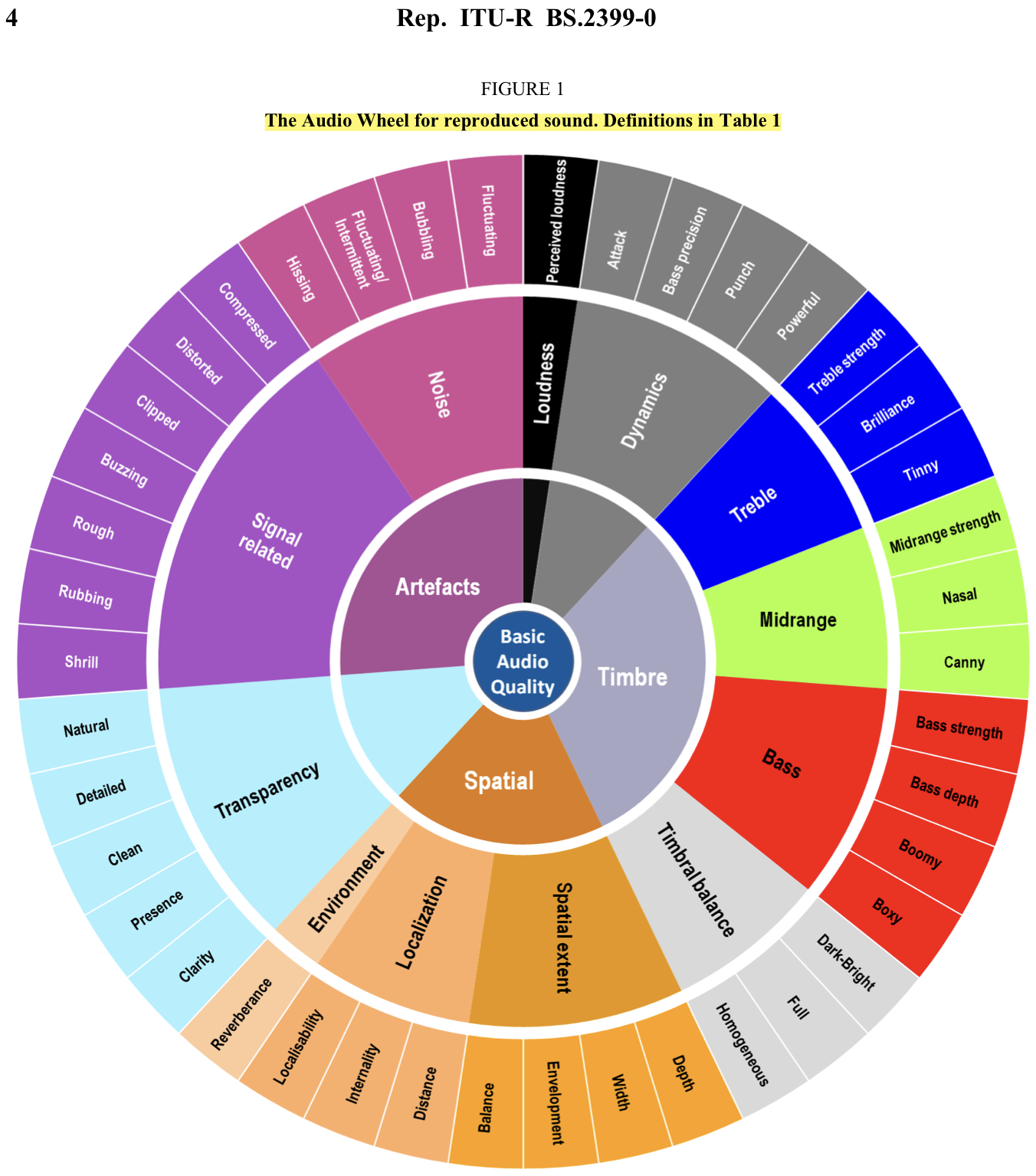
Timbre: Figure shows the frequency response of H60 against the Harman in-ear target. Measurements were done with an IEC-711-compliant coupler and might only be compared with other measurements from this same coupler. Above 8kHz, the measurement likely does not match the response at the ear drum. Visit my graph database for more comparisons.
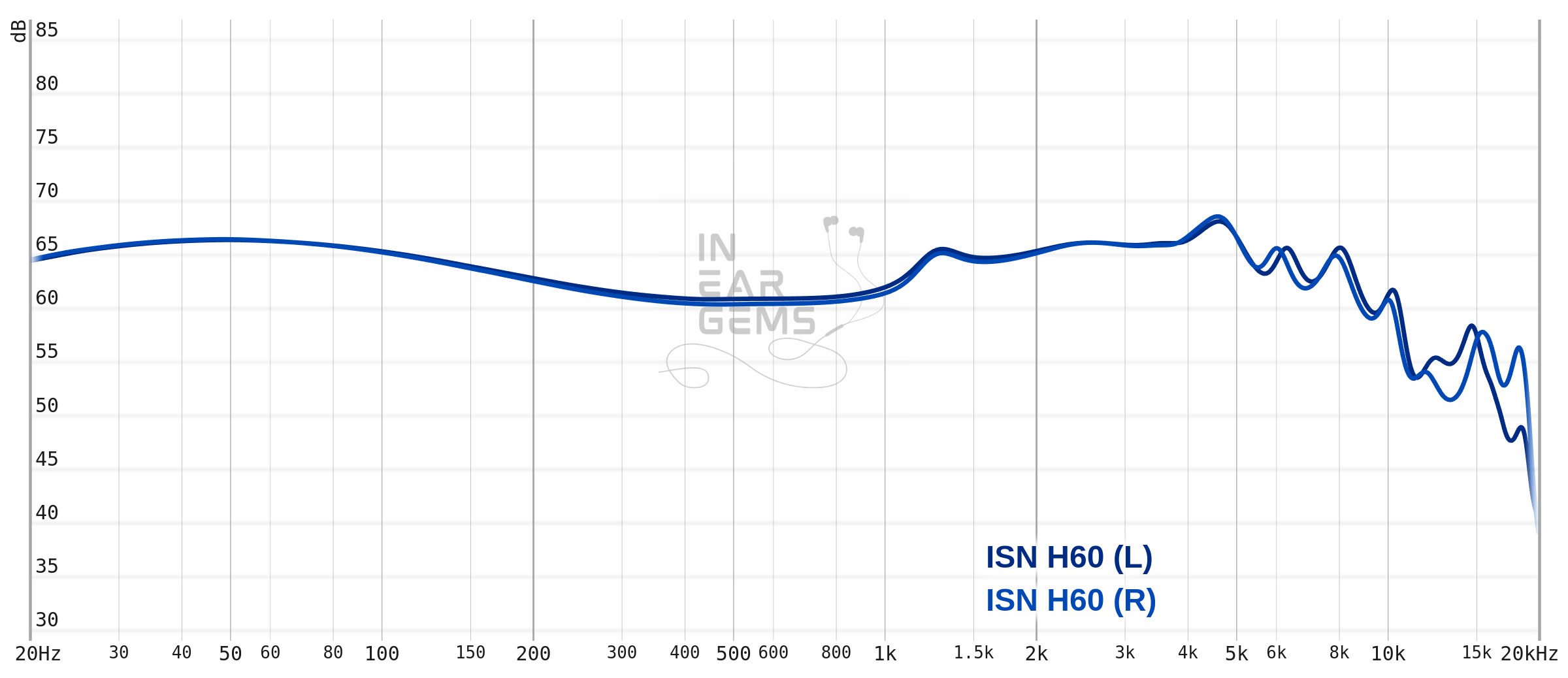
I was quite surprised when listening to H60 the first time, since it is somewhat a departure from what I consider the “house sound” of ISN and Penon, a rich and gooey and cozy sound. It does not mean H60 get rid of that cozy sound signature entirely, but it is noticeably more balanced and neutral than previous releases such as the Neo5.
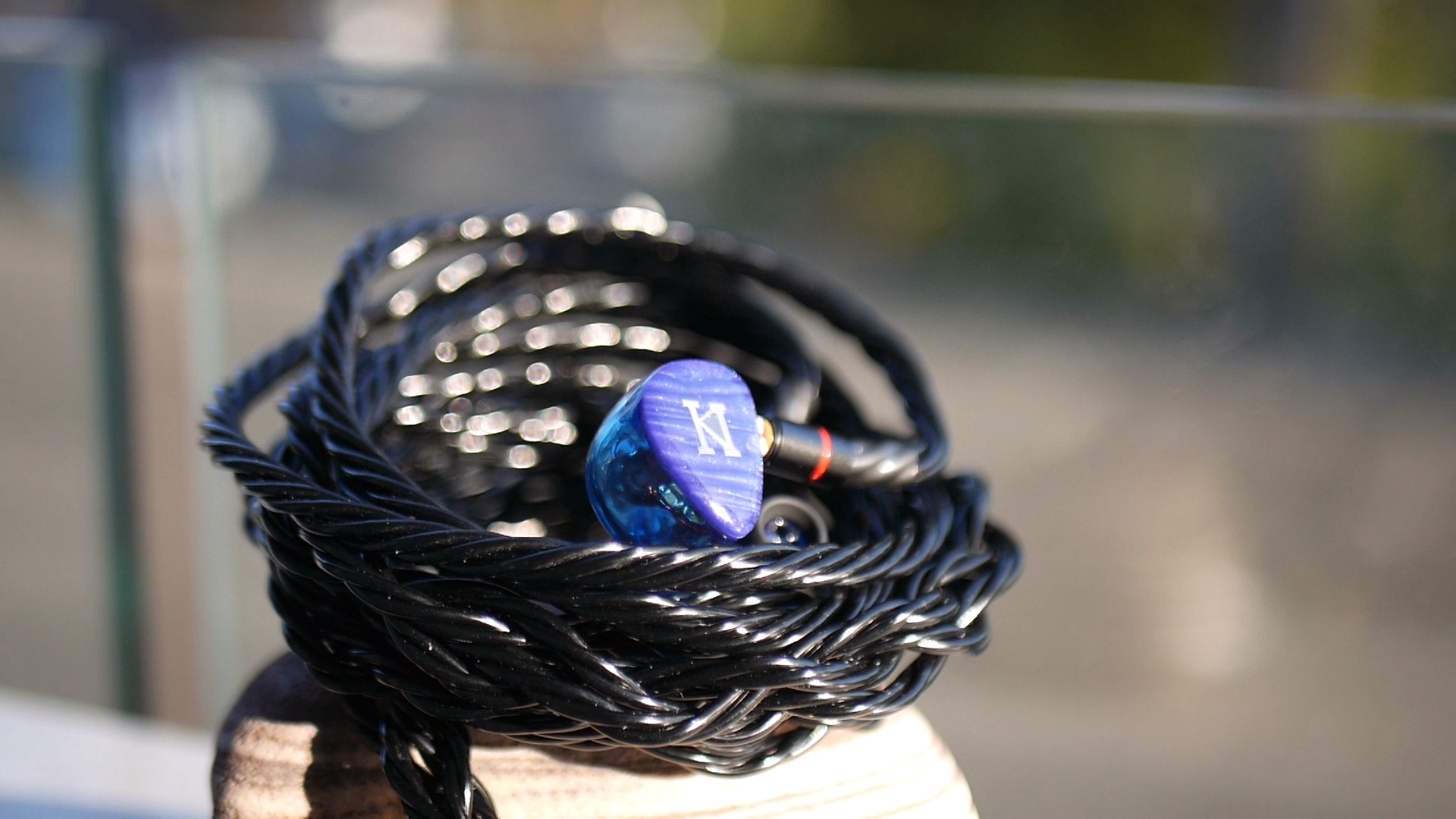
The tonal balance of H60 can be described as neutral warm with boosted bass. It means when I listen to an entire audio mix at the same time, such as Dreamlang Express by John Denver, I found bass guitar to be more prominent (boosted bass) without overwhelming the rest of the mix. The midrange elements such as the voice of John Denver, background singers, and the guitars are prominent without overpowering the rest of the mix. In the same vein, the treble instruments such as cymbals and hats in Playing God by Polyphia do not overpower the mix yet, at the same time, does not sacrifice their energy and volume in the mix. H60 also handles sibilant tracks such as Shivers by Ed Sheeran as expected. It does not make the track worse, but it does not tame the harshness of this track too much.
Zooming into the midrange, I hear a subtle, pleasant warm hue casting across voices and instruments. H60 achieves this warmth by (1) subtly lift the 250Hz region by a few dB and (2) limit the ear gain boost from around 2kHz to a conservative amount of 6dB. This approach stands in stark contrast against the usual approach of lifting every frequencies below 1kHz, which tends to cast thick veil that smother voices and instruments across the frequencies. The approach taken by H60 creates a correct-yet-pleasant midrange, which I find superior.
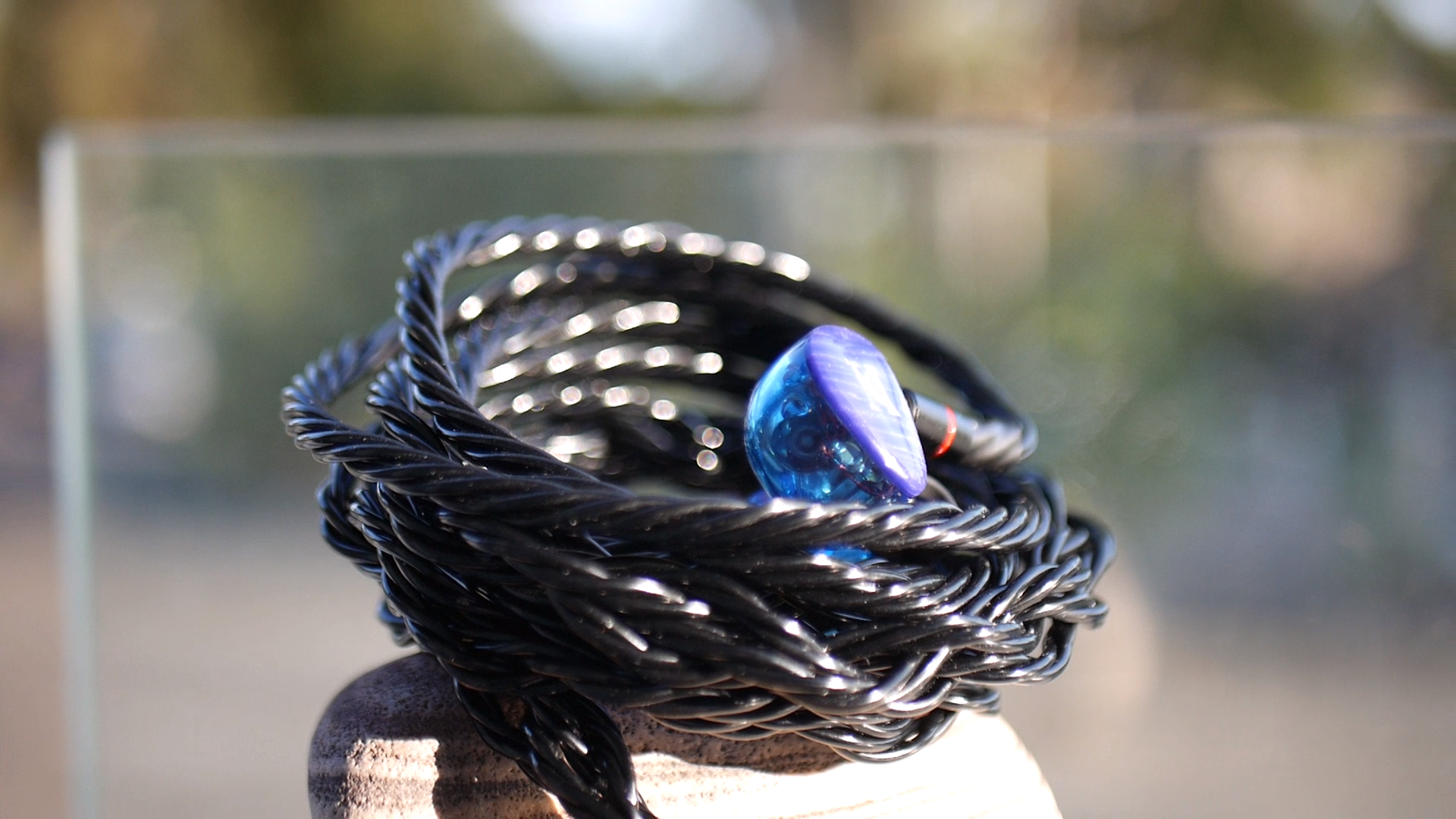
The treble of H60 is where it slightly slips. On the plus side, the tonality of higher pitched instruments do not raise any immediate alert. For example, the hand claps section at the beginning of Synchro BOM-BA-YE by Tokyo Kosei Wind Orchestra, a section where any imbalance in the treble would stand out immediately, was produced without any significant problem by H60. However, closer inspection of the upper midrange and treble of H60 reveals some cracks. Firstly, the brass instruments lack the brilliance and “shine” that I expected. This problem could be due to the more subdued upper midrange of H60.
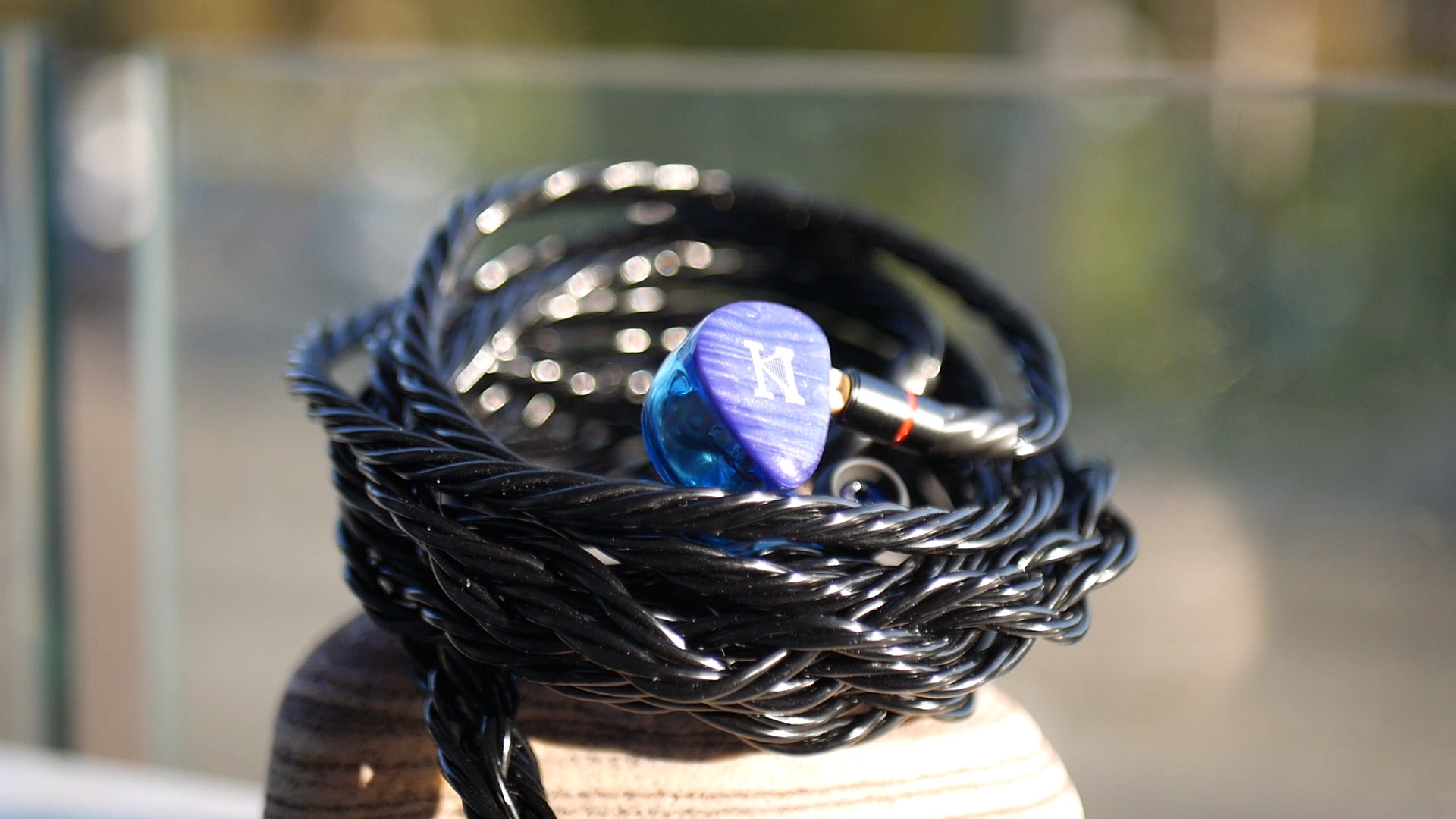
This lack of brilliance and “shine” was also observed in cymbals and hats. The drum focused section that features a lot of cymbals and hats around 1:50 in Playing God by Polyphia highlight this problem. Simply put, the these instruments sounds truncated, as if there is too much of the stick impact without the necessary body and decay to accompany it. Looking at the graph, the small peak at 5kHz followed by a rolled off treble response could be culprit.
Bass and perceived dynamic:
The bass of H60 is good, though lacking a bit of power to be truely outstanding. Let’s talk about the good side first: the bass of H60 feels tight and quite powerful. Attacks of bass notes feel focus and immediate. At the same time, the bass attacks pack decent sense of physical thump, preventing it from sounding hollow.
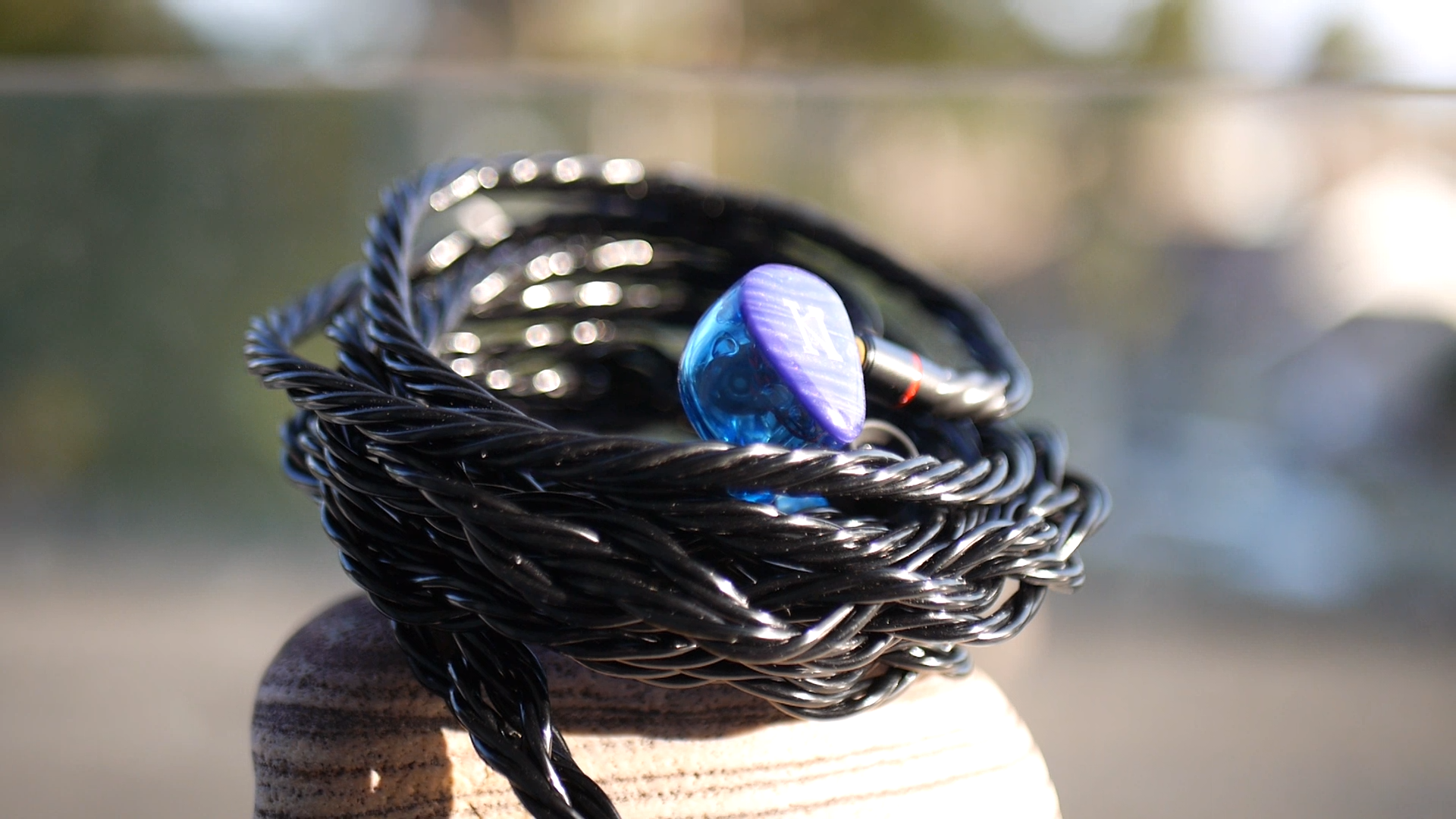
On the other hand, there are moments when H60 fail to convey the subbass rumble, such as the drop around 5:20 in Rengoku Theme cover by Samuel Kim. This track also highlights another problem with H60: it simply fails to convey the expected energy carried by the beat and the rhythm of the track. It feels like the dynamic swings of H60 (loudness jumps) are not distinct and prominent enough. The problem persisted even when I turned up the volume. H60 simply sounds louder rather than becoming more dynamic. The bass texture is only average in the grand scheme.
Resolution:
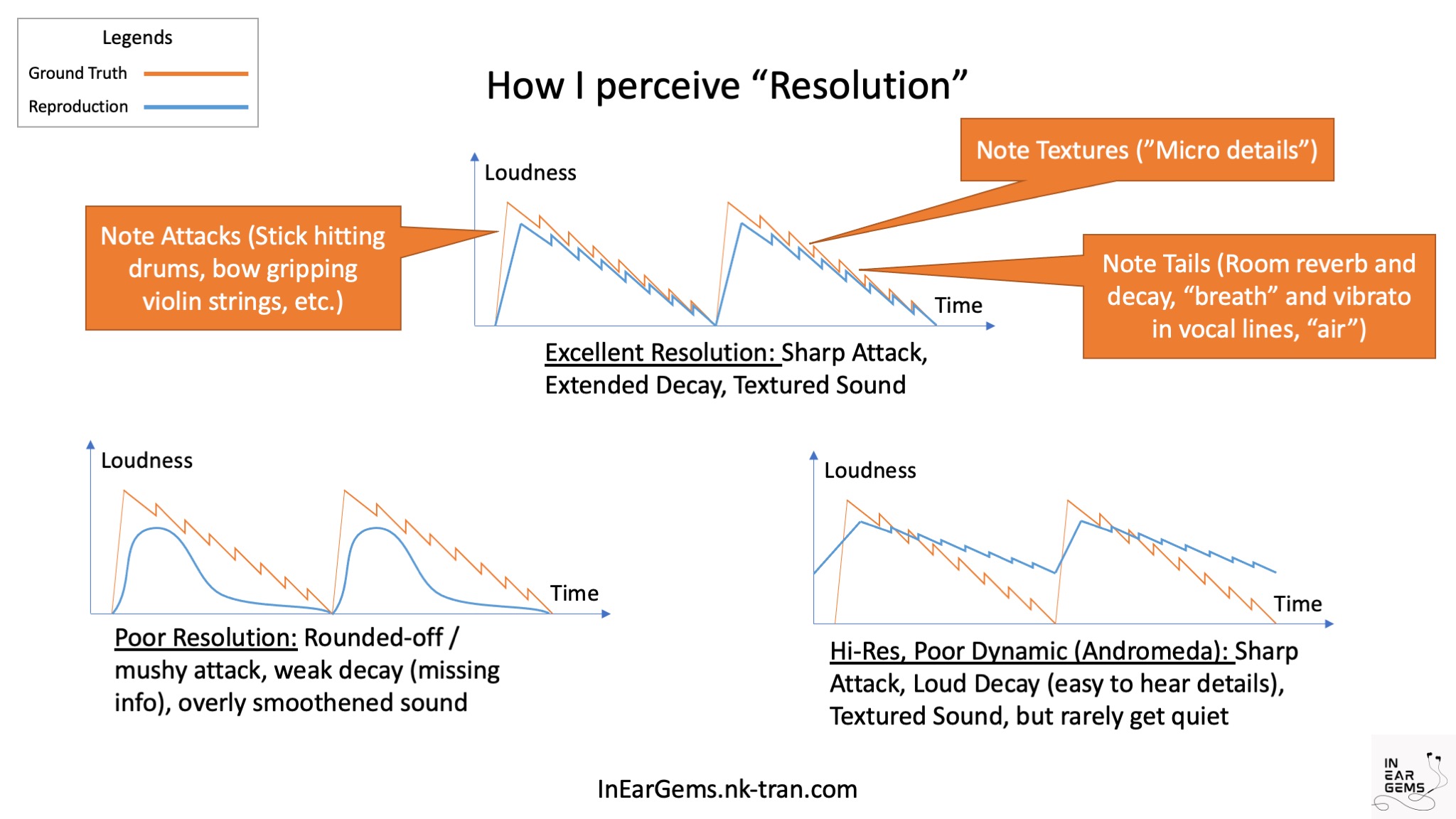
H60 does not exaggerated the attack edge of the notes via treble peaks to enhance the sense of clarity in an artificial way. That said, it still sounds quite clear and can present larger orchestral music such as A Town with an Ocean View by Joe Hisaishi with minimal smearing between instruments. The instrument separation only falters in more tricky tracks such as Now We Are Free by 2CELLOS, where the lower midrange is tightly congested by two cellos, the whole cellos section, and the doublebasses.
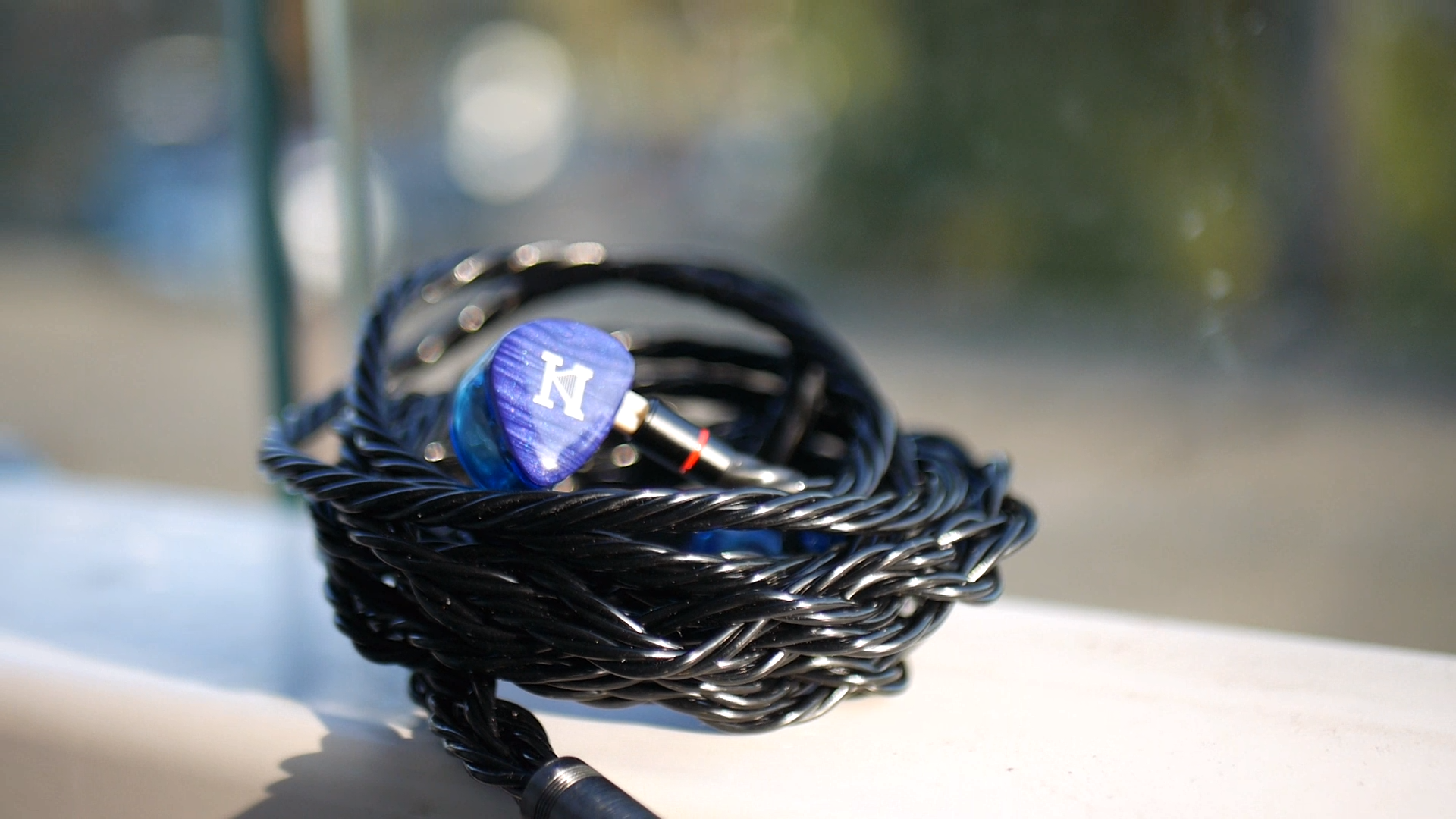
When I put the resolution of H60 into a scale by comparing it with my benchmark IEMs, I found that H60’s resolution is good, but not great. Whilst it matches or exceeds good IEMs such as Moondrop Blessing 2 in terms of the overall presentation and separation of instruments in a mix, it lacks the nuances and micro details that I can hear from a more resolving IEM such as Andromeda 2020 when listening to the same track.
Stereo imaging and soundstage:
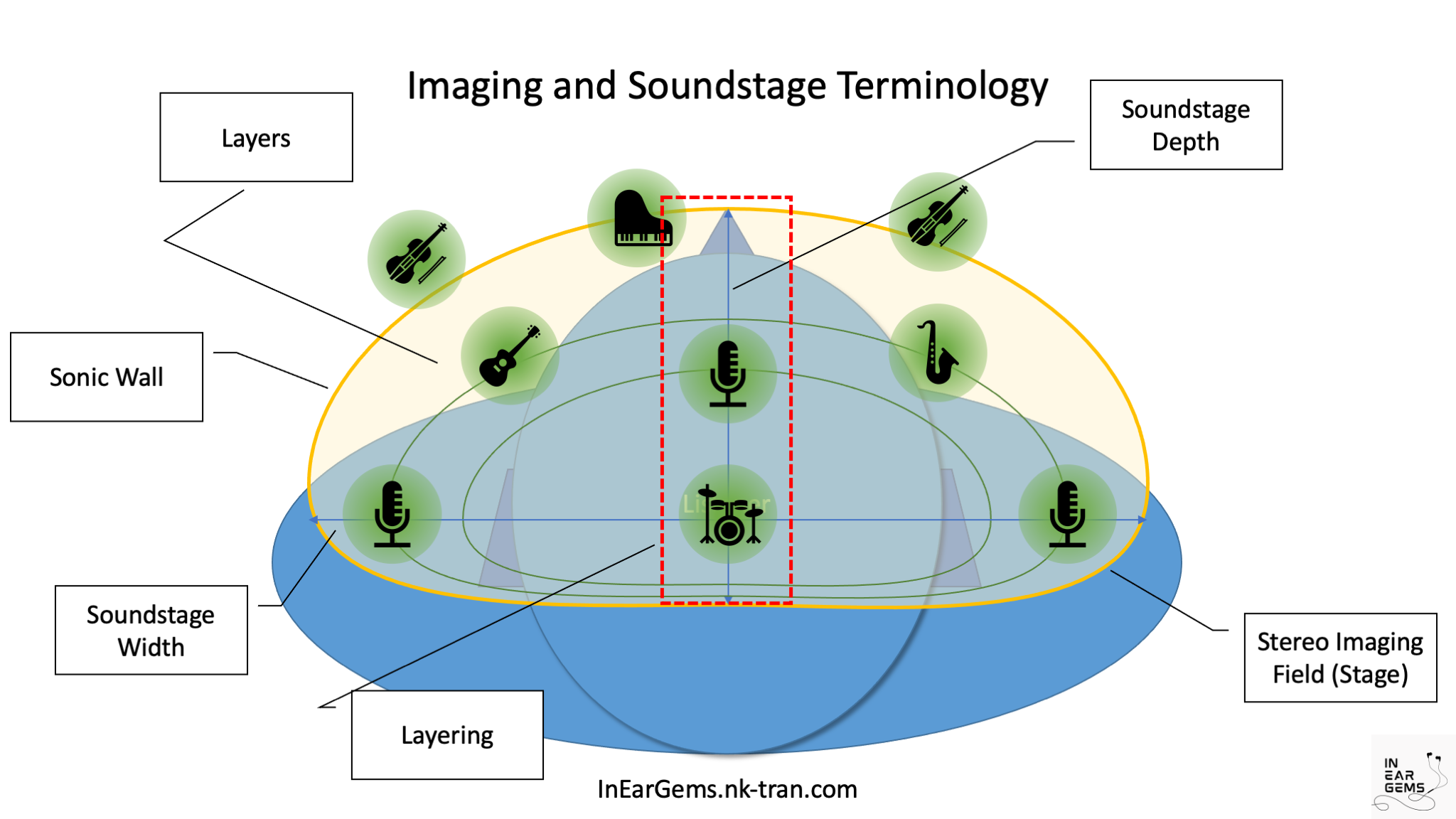
The soundstage and imaging is an area where H60 does a competent job. Orchestral recordings such as A Town with an Ocean View feel spacious and open, with instruments spreading around on the soundstage rather than tightly distributed around the phantom center inside the head. I found that the soundstage has more width (left to right) than depth (front-to-back). Fortunately, it does not sound distractingly flat and 2D.
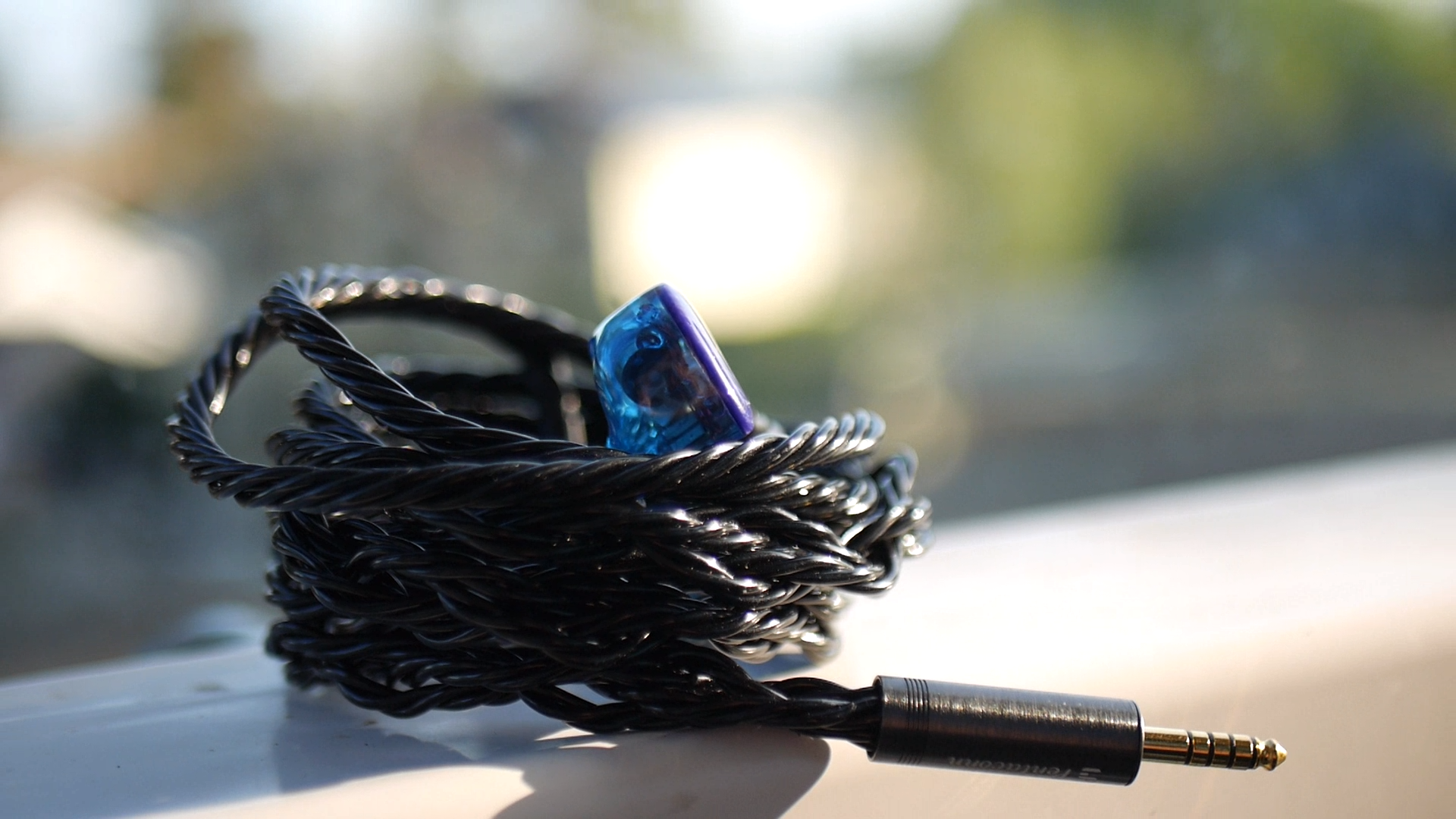
The sound positioning of H60 is good, but not outstanding. In FPS games, I can get a sense of overall direction and distance of the sound, even if the sound come from behind. However the positioning does not feel tack sharp and precise.
The treble is also quite different between these two IEMs. Cymbals, hats, and chimes sound more shimmery with H60 due to the fact that they are more present in the mix. On the other hand, when I focus on those instruments, I find that they sound more refined with Explorer, both in terms of the clarity of note attacks and details in the decay. In terms of the soundstage, Explorer has an edge when it comes to depth, whilst H60 sounds wider.
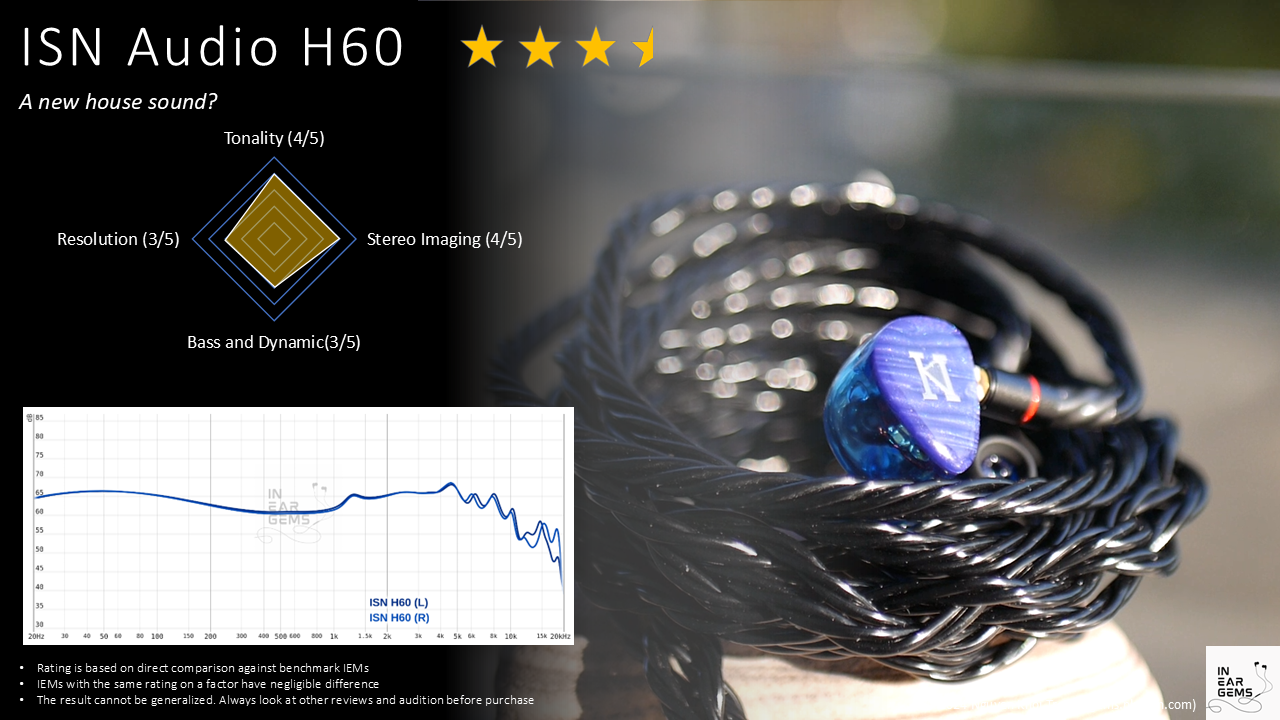
Updated: October 12, 2024
Forewords
- What I look for in an IEM is immersion. I want to feel the orchestra around my head, track individual instruments, and hear all of their textures and details. I’m not picky about tonality, as long as it is not make the orchestra, violin, cellos, and pianos sound wrong.
- I rate IEMs within with a consistent scale from 1 (Poor) to 3 (Good) to 5 (Outstanding). An overall ranking of 3/5 or above is considered positive.
- Ranking list and measurement database are on my IEM review blog.
- The terminology for subjective impressions in this review is based on the Audio Wheel for reproduced sound defined in the technical report ITU-R BS.2399-0
- This review is based on a personally sourced unit
- The unit retails for $349 at the time this review was published. Unaffiliated link: Penon web shop
General Information
H60 is a mid-range offering from ISN Audio, a sister brand of Penon Audio and the maker of some highly regarded budget-friendly IEMs in the last year. H60 is a 6-driver hybrid IEM with 2 dynamic drivers (DD) and 4 balanced armature (BA) drivers, arranged in a 3-way crossover design. The bass frequencies are handled by a pair of 8mm DD. The midrange is carried by 2 Sonion BA drivers whilst the treble is taken care of by 2 Knowles BA drivers. The components are housed inside hollow resin shells. As a result, the earpieces are very light.


The nozzles of H60 are on the larger side. Fortunately, they have adequate length to avoid any fit problem. That said, you might need to experiment with eartips types and sizes to find the one that offer the right combination of comfort and sound quality.
I use Divinus Velvet Wide Bore eartips across my listening sessions with H60. Due to the large nozzles, my ear canal does get fatigued in longer sessions that last more than an hour. On the plus side, I did not experience any pressure build up during my tests.
Sonic Performance
Testing setup:- Sources: L&P W4, iBasso DX300, FiiO K7
- Cable: stock ISN cable
- Ear tips: Divinus Velvet Wide Bore

Timbre: Figure shows the frequency response of H60 against the Harman in-ear target. Measurements were done with an IEC-711-compliant coupler and might only be compared with other measurements from this same coupler. Above 8kHz, the measurement likely does not match the response at the ear drum. Visit my graph database for more comparisons.

I was quite surprised when listening to H60 the first time, since it is somewhat a departure from what I consider the “house sound” of ISN and Penon, a rich and gooey and cozy sound. It does not mean H60 get rid of that cozy sound signature entirely, but it is noticeably more balanced and neutral than previous releases such as the Neo5.

The tonal balance of H60 can be described as neutral warm with boosted bass. It means when I listen to an entire audio mix at the same time, such as Dreamlang Express by John Denver, I found bass guitar to be more prominent (boosted bass) without overwhelming the rest of the mix. The midrange elements such as the voice of John Denver, background singers, and the guitars are prominent without overpowering the rest of the mix. In the same vein, the treble instruments such as cymbals and hats in Playing God by Polyphia do not overpower the mix yet, at the same time, does not sacrifice their energy and volume in the mix. H60 also handles sibilant tracks such as Shivers by Ed Sheeran as expected. It does not make the track worse, but it does not tame the harshness of this track too much.
Zooming into the midrange, I hear a subtle, pleasant warm hue casting across voices and instruments. H60 achieves this warmth by (1) subtly lift the 250Hz region by a few dB and (2) limit the ear gain boost from around 2kHz to a conservative amount of 6dB. This approach stands in stark contrast against the usual approach of lifting every frequencies below 1kHz, which tends to cast thick veil that smother voices and instruments across the frequencies. The approach taken by H60 creates a correct-yet-pleasant midrange, which I find superior.

The treble of H60 is where it slightly slips. On the plus side, the tonality of higher pitched instruments do not raise any immediate alert. For example, the hand claps section at the beginning of Synchro BOM-BA-YE by Tokyo Kosei Wind Orchestra, a section where any imbalance in the treble would stand out immediately, was produced without any significant problem by H60. However, closer inspection of the upper midrange and treble of H60 reveals some cracks. Firstly, the brass instruments lack the brilliance and “shine” that I expected. This problem could be due to the more subdued upper midrange of H60.

This lack of brilliance and “shine” was also observed in cymbals and hats. The drum focused section that features a lot of cymbals and hats around 1:50 in Playing God by Polyphia highlight this problem. Simply put, the these instruments sounds truncated, as if there is too much of the stick impact without the necessary body and decay to accompany it. Looking at the graph, the small peak at 5kHz followed by a rolled off treble response could be culprit.
Bass and perceived dynamic:
The bass of H60 is good, though lacking a bit of power to be truely outstanding. Let’s talk about the good side first: the bass of H60 feels tight and quite powerful. Attacks of bass notes feel focus and immediate. At the same time, the bass attacks pack decent sense of physical thump, preventing it from sounding hollow.

On the other hand, there are moments when H60 fail to convey the subbass rumble, such as the drop around 5:20 in Rengoku Theme cover by Samuel Kim. This track also highlights another problem with H60: it simply fails to convey the expected energy carried by the beat and the rhythm of the track. It feels like the dynamic swings of H60 (loudness jumps) are not distinct and prominent enough. The problem persisted even when I turned up the volume. H60 simply sounds louder rather than becoming more dynamic. The bass texture is only average in the grand scheme.
Resolution:

H60 does not exaggerated the attack edge of the notes via treble peaks to enhance the sense of clarity in an artificial way. That said, it still sounds quite clear and can present larger orchestral music such as A Town with an Ocean View by Joe Hisaishi with minimal smearing between instruments. The instrument separation only falters in more tricky tracks such as Now We Are Free by 2CELLOS, where the lower midrange is tightly congested by two cellos, the whole cellos section, and the doublebasses.

When I put the resolution of H60 into a scale by comparing it with my benchmark IEMs, I found that H60’s resolution is good, but not great. Whilst it matches or exceeds good IEMs such as Moondrop Blessing 2 in terms of the overall presentation and separation of instruments in a mix, it lacks the nuances and micro details that I can hear from a more resolving IEM such as Andromeda 2020 when listening to the same track.
Stereo imaging and soundstage:

The soundstage and imaging is an area where H60 does a competent job. Orchestral recordings such as A Town with an Ocean View feel spacious and open, with instruments spreading around on the soundstage rather than tightly distributed around the phantom center inside the head. I found that the soundstage has more width (left to right) than depth (front-to-back). Fortunately, it does not sound distractingly flat and 2D.

The sound positioning of H60 is good, but not outstanding. In FPS games, I can get a sense of overall direction and distance of the sound, even if the sound come from behind. However the positioning does not feel tack sharp and precise.
Selected Comparisons
Vs AFUL Explorer: Explorer is a 1DD+2BA hybrid IEM from the Chinese manufacturer AFUL. The reason I brought this IEM out for comparison is because from memory, H60 reminds me of Explorer as both are warm-tilted IEMs. It turned out I was wrong. They are more different than alike. The first thing I notice is how much more muscular the presentation of Explorer is due to extra subbass. In back to back A/B tests, H60 feels more midrange focus.The treble is also quite different between these two IEMs. Cymbals, hats, and chimes sound more shimmery with H60 due to the fact that they are more present in the mix. On the other hand, when I focus on those instruments, I find that they sound more refined with Explorer, both in terms of the clarity of note attacks and details in the decay. In terms of the soundstage, Explorer has an edge when it comes to depth, whilst H60 sounds wider.
Conclusions
Writing a conclusion about H60 has been tricky, since it both exceeds and falls short of what I expected. For example, the tonality was great, making most vocal music a joy to listen to. The bass was tight and thumpy. On the other hand, I expected … more. More dynamic, more details, more refinement in general. Is it an unfair expectation? It’s hard to say in an ever moving landscape of IEM market. Still, if you are listen to a lot of vocal music and you like the cozy house sound of Penon and ISN, the new signature of H60 is worth an audition. Instead of ending the review with usual technicalities, let me end this one with a track that I love to listen with ISN-H60
Updated: October 12, 2024
vandung2510
Dang, 3.5 stars  ( Feels bad man. Didn't expect it to be this low (I have no problem with your review btw, this is just for conversation sake :v ). I ranked it a rare full 5* lol. But then again, i like quite a lot of things.
( Feels bad man. Didn't expect it to be this low (I have no problem with your review btw, this is just for conversation sake :v ). I ranked it a rare full 5* lol. But then again, i like quite a lot of things.
Hmm... There are some points that you and i align, some are not.
I agree with the pros regarding the bass. However, for the cons... idk. The bass texture of the H60 is the best i've heard from an iem under 400$ imho. With agressively fast drum sessions like in the track "distress rehearsal" - everytime i die, the bass drivers shine in the H60. It's up there with the Simgot EA1000's, which i believe you ranked 4/5.
 ( Feels bad man. Didn't expect it to be this low (I have no problem with your review btw, this is just for conversation sake :v ). I ranked it a rare full 5* lol. But then again, i like quite a lot of things.
( Feels bad man. Didn't expect it to be this low (I have no problem with your review btw, this is just for conversation sake :v ). I ranked it a rare full 5* lol. But then again, i like quite a lot of things.Hmm... There are some points that you and i align, some are not.
I agree with the pros regarding the bass. However, for the cons... idk. The bass texture of the H60 is the best i've heard from an iem under 400$ imho. With agressively fast drum sessions like in the track "distress rehearsal" - everytime i die, the bass drivers shine in the H60. It's up there with the Simgot EA1000's, which i believe you ranked 4/5.
vandung2510
That being said, i agree for the most part regarding the treble. It's where i'd consider the "hiccup" of the H60. Specifically the 5-6k part. It's like Chili. It's spicy, it's hot, it's kinda painful, but i somehow like it lol
The H60, i feel like it has really good width and height, but not as good depth, so i'm with you on that.
Anyhow, that's it for my ramble. Good review as always man.
The H60, i feel like it has really good width and height, but not as good depth, so i'm with you on that.
Anyhow, that's it for my ramble. Good review as always man.
o0genesis0o
@vandung2510 I’m also surprised when tallying up the score at the end.
I try my best to like the bass, but it keeps falling flat for me. If the track was not mix to be distinctly thumpy, H60 would not make them rhythmic and dynamic enough. I guess I have been listening to some rather great bass lately so I’m less convinced.
I try my best to like the bass, but it keeps falling flat for me. If the track was not mix to be distinctly thumpy, H60 would not make them rhythmic and dynamic enough. I guess I have been listening to some rather great bass lately so I’m less convinced.
Neeoo
Head-Fier
Pros: Incredible technicalities
Deep, punchy and highly textured mid-bass
Dynamic vocals with a sense of clarity
Non-sibilant highs and no fatigue whatsoever
Reasonably wide soundstage
Top-notch instrument separation
Price
Deep, punchy and highly textured mid-bass
Dynamic vocals with a sense of clarity
Non-sibilant highs and no fatigue whatsoever
Reasonably wide soundstage
Top-notch instrument separation
Price
Cons: Blue colour bland shell!? (that’s the only flaw I could come up with)
Disclaimer: - I am a bass head and prefer a wide sound with natural timbre, excellent imaging and thumpy mid-bass with moderate decay and clinical precision when it comes to instrument separation. I am highly averse to bright-sounding transducers and sibilance in my music.
This unit was sent to me by Audio Geek India as part of the H60 Iem tour. I thank Audio Geek India & ISN Audio for this opportunity to listen and review ISN Audio – H60. My views aren’t influenced either by Audio Geek/ISN Audio in any way.
Overview: The fit and seal were fine. I had no such issues. Didn’t find anything offensive with the looks but didn’t fancy anything in particular in the visuals. It’s a 2DD+ 4BA configuration with a 3-way crossover.
I started using this iem on DX180. After a day of listening my initial impressions were that it has got quite some technicalities for the price but in the later part of my review I used it with Dx320+Amp14 and climbed quite a few notches above in performance.
I also cable rolled and used Effect Audio Eros S with this iem which provided detailed highs and a wide soundstage. On this chain, it completely started outperforming price brackets way above its asking price. I was texting a friend and didn’t notice that I was listening to a song on repeat and it was so easy on my ears to just let H60 do its magic.
Rather than outrightly enjoying the bass, vocals or treble individually I found that more often than not I found admiring the texture details in a kick drum or a vocal swelling up; a lisp or a sigh that wasn’t noticeable with other iems becomes very prominent on the H60.







Lows: It’s a bass-head delight. People who like a balanced bass-heavy or smoothed-out bass-heavy sound signature, both; would love the H60 for what it is. It offers great texture details, deep-reaching mid-bass thump and precise and clean sub-bass. The decay is quick and quite technical sounding. There is detail in every note it depicts, especially in the low end. I didn’t need any EQ to bump up the 150Hz spot which I generally use with a peaking filter. Not on this one. I felt it lost resolution when I tried to meddle with the already perfect tonality. (for me)
Mids: Mids aren’t on the lush or forward side. They sound presice, balanced and have a sense of clarity. The mid bass thump and the vocals have enough air between them to get you to wonder how is this warmth not seeping into the mids. Don’t ask me, no clue. This was refreshing to my ears that with deep-reaching mid-bass there wasn’t a sign of any muddiness in the mids. Male vocals and female vocals both sound natural and what I liked about the mids is the details when I notice a sigh, or an inhale before a long paragraph.
Highs: With everything going on perfectly with this iem this is where it adds an extra cherry on top of being truly non-fatiguing yet will surprise you with the amount of detail and precision it brings to the highs. Well separated and without any smearing effect, it gives iems in the price range much higher a run for their money. I often use a high shelf filter at 3000Hz with a 4db dip but never with this iem. Again, when I tried to eq and check, it felt like I lost resolution. Even on bad recordings, I faired pretty well and I could listen to it effortlessly without any worry for harshness at high volumes.
Technicalities: I will say this is why you buy the H60. For it’s sheer competence in technicalities. Tonality I believe is something that you are aligned with, this will surprise you with the plethora of details it offers. Wide soundstage, natural timbre and high resolution; it just scores an A+ in all departments here. This is the prime reason and the star of the show at all times in the presentation. One can’t help but notice the intricate details brought up by amazingly well-separated sound cues. At this point, I feel the discussion should be about why it’s not endgame but won’t get into that rabbit hole right now.
Also, coincidentally I happened to buy EST50 last year. It has a similar tonality with slightly recessed highs but the stark difference is EST50 being exceptionally musical and H60 being exceptionally technical. So if you prefer a warmer more musical sound then that iem is the way to go.
Conclusion: It won't please you by its musicality but by its highly technical and analytical tuning. This iem I believe is a glimpse of what iems in more than double the price range offer. It’s so effortless listening to the H60 that even post the review I am finding myself picking it for casual listening. It’s a blind buy at 349$ in my opinion if you prefer a technical mid-bass forward sound. I realise that at this time I have developed a bias for this iems. I get truly elated when I see more value in a product than its asking price. “Once a Canadian Comedian said - Just take it and go”. I would like to say the same about this iem. Thank you for reading.
This unit was sent to me by Audio Geek India as part of the H60 Iem tour. I thank Audio Geek India & ISN Audio for this opportunity to listen and review ISN Audio – H60. My views aren’t influenced either by Audio Geek/ISN Audio in any way.
Overview: The fit and seal were fine. I had no such issues. Didn’t find anything offensive with the looks but didn’t fancy anything in particular in the visuals. It’s a 2DD+ 4BA configuration with a 3-way crossover.
I started using this iem on DX180. After a day of listening my initial impressions were that it has got quite some technicalities for the price but in the later part of my review I used it with Dx320+Amp14 and climbed quite a few notches above in performance.
I also cable rolled and used Effect Audio Eros S with this iem which provided detailed highs and a wide soundstage. On this chain, it completely started outperforming price brackets way above its asking price. I was texting a friend and didn’t notice that I was listening to a song on repeat and it was so easy on my ears to just let H60 do its magic.
Rather than outrightly enjoying the bass, vocals or treble individually I found that more often than not I found admiring the texture details in a kick drum or a vocal swelling up; a lisp or a sigh that wasn’t noticeable with other iems becomes very prominent on the H60.







Lows: It’s a bass-head delight. People who like a balanced bass-heavy or smoothed-out bass-heavy sound signature, both; would love the H60 for what it is. It offers great texture details, deep-reaching mid-bass thump and precise and clean sub-bass. The decay is quick and quite technical sounding. There is detail in every note it depicts, especially in the low end. I didn’t need any EQ to bump up the 150Hz spot which I generally use with a peaking filter. Not on this one. I felt it lost resolution when I tried to meddle with the already perfect tonality. (for me)
Mids: Mids aren’t on the lush or forward side. They sound presice, balanced and have a sense of clarity. The mid bass thump and the vocals have enough air between them to get you to wonder how is this warmth not seeping into the mids. Don’t ask me, no clue. This was refreshing to my ears that with deep-reaching mid-bass there wasn’t a sign of any muddiness in the mids. Male vocals and female vocals both sound natural and what I liked about the mids is the details when I notice a sigh, or an inhale before a long paragraph.
Highs: With everything going on perfectly with this iem this is where it adds an extra cherry on top of being truly non-fatiguing yet will surprise you with the amount of detail and precision it brings to the highs. Well separated and without any smearing effect, it gives iems in the price range much higher a run for their money. I often use a high shelf filter at 3000Hz with a 4db dip but never with this iem. Again, when I tried to eq and check, it felt like I lost resolution. Even on bad recordings, I faired pretty well and I could listen to it effortlessly without any worry for harshness at high volumes.
Technicalities: I will say this is why you buy the H60. For it’s sheer competence in technicalities. Tonality I believe is something that you are aligned with, this will surprise you with the plethora of details it offers. Wide soundstage, natural timbre and high resolution; it just scores an A+ in all departments here. This is the prime reason and the star of the show at all times in the presentation. One can’t help but notice the intricate details brought up by amazingly well-separated sound cues. At this point, I feel the discussion should be about why it’s not endgame but won’t get into that rabbit hole right now.
Also, coincidentally I happened to buy EST50 last year. It has a similar tonality with slightly recessed highs but the stark difference is EST50 being exceptionally musical and H60 being exceptionally technical. So if you prefer a warmer more musical sound then that iem is the way to go.
Conclusion: It won't please you by its musicality but by its highly technical and analytical tuning. This iem I believe is a glimpse of what iems in more than double the price range offer. It’s so effortless listening to the H60 that even post the review I am finding myself picking it for casual listening. It’s a blind buy at 349$ in my opinion if you prefer a technical mid-bass forward sound. I realise that at this time I have developed a bias for this iems. I get truly elated when I see more value in a product than its asking price. “Once a Canadian Comedian said - Just take it and go”. I would like to say the same about this iem. Thank you for reading.
nmatheis
Headphoneus Supremus
Pros: Full, dynamic sound, good accessories
Cons: Too much upper mids and lower treble for me
DISCLAIMER: The ISN H60 was sent to me as part of the Audio Geek "Brother_Hood of Audiophiles" US Tour. Many thanks to Audio Geek and ISN for the opportunity to give these a listen and share my thoughts!
A BIT ABOUT ME: I’ve been in the hobby for many years, starting out with old-school DAPs like the iRiver IHP120 and Rio Karma and IEM like the Shure E2c and E3c. Over the years, I’ve maintained a focus on portable audio, and my setup has evolved to mainly dongle DACs and mid-tier IEM. I mainly listen to classic rock, electronic, and metal. While I can appreciate many different flavors of sound, I avoid setups which provide too much upper mids and lower treble.
WHAT'S INCLUDED: H60, 3 types of silicon tips + foam tips, cable, case.
DRIVER CONFIGURATION: 2 x Knowles BAs for the highs, 2 x Sonion BAs for the mids, and 2 x 8mm liquid silicone gel dynamic drivers for the lows with a 3-way crossover.
MY THOUGHTS:
Accessories: I really like ISN/Penon eartips, so I was more than happy with those although I was surprised to see foam tips which aren’t typical with ISN/Penon IEM. I also really like ISN’s case which provides good protection and is pocketable. The cable was much thinner than I’m used to from ISN/Penon, so that was a surprise. Not necessarily good or bad, just a surprise.


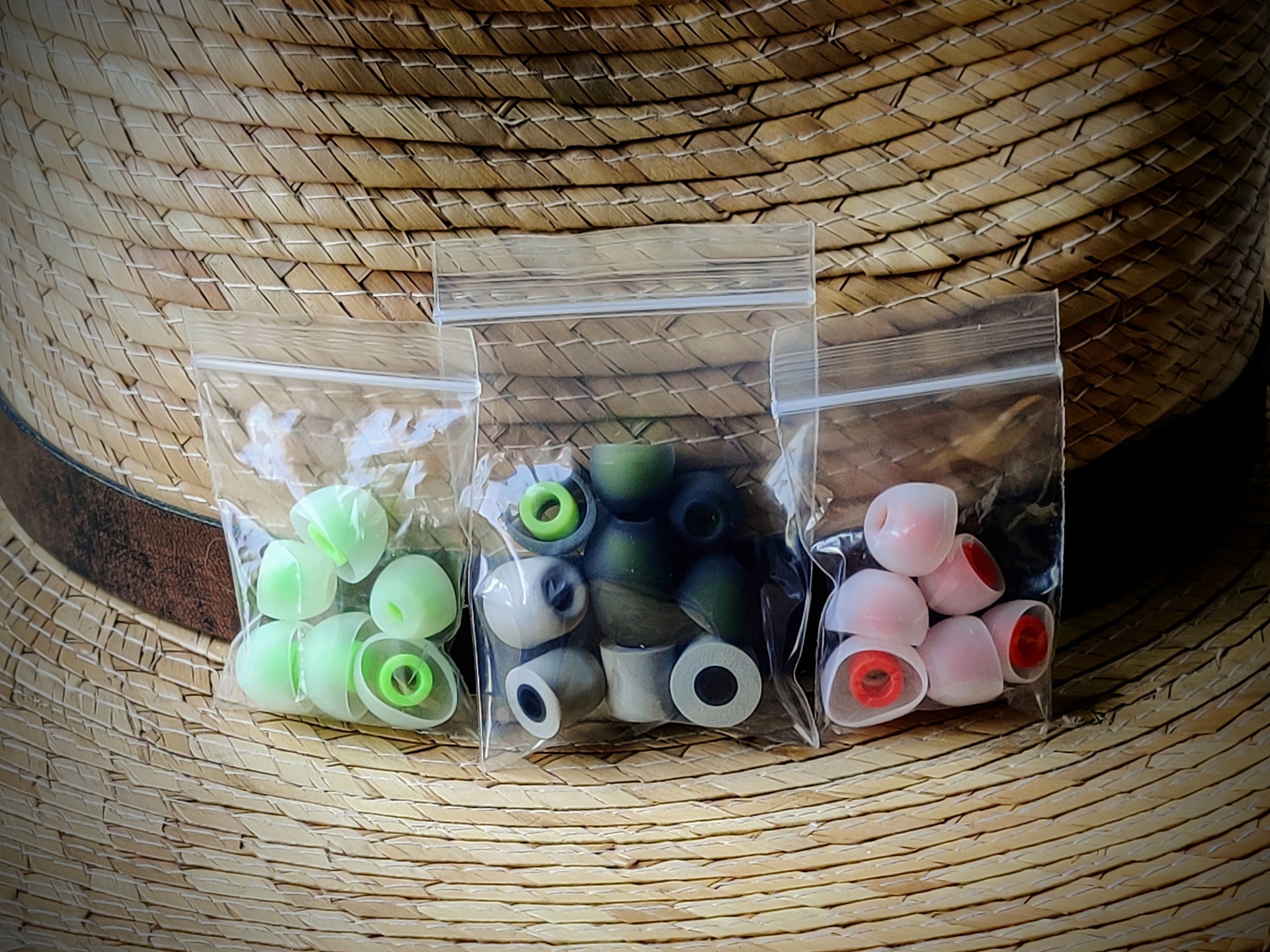


Comfort: I have medium sized ears and found the shells comfortable for longer listening sessions, although ymmv. The lightweight cable almost disappeared which was good for on the go listening, although I prefer a thicker cable for sedentary listening sessions. The shells are vented, so I had no issue with pressure buildup and moving my head and jaw didn't affect sound.




Sound: I’d characterize the sound as full and dynamic with balanced lows, warm lower mids, bright upper mids and lower treble, and good extension in the upper end. Soundstage had good width and depth, but I wasn’t getting much height. Imaging was fine but lagged behind soundstage for me. I know many others found the upper mids and lower treble a refreshing departure for ISN/Penon, but unfortunately they were just too much for me resulting in a sibilant and overly bright sound. Ultimately, I knew these weren’t for me, but I played around with tips, cable, and source to try and overcome this.
Tips: I tried both Penon Liquer Black and Orange tips but preferred the stock gray/green tips over both of those.
Cables: I tried several Penon cables and found two that I preferred to the stock cable. The first was the Penon OCC849 which warmed up the sound, taming the upper mids and lower treble a bit. The second was Penon Flow which tightened up the low end and provided more air.
Sources: I tried several dongle DACs (RU6, L&P W2, Onix Alpha 1, and Penon Tail), Chord Mojo, Dethonray Pegasus SG1, and Shanling M6. Out of those, I preferred the synergy of L&P W2, Penon Tail (which I think is an extremely underrated and well-priced dongle DAC), and Dethonray SG1 with Serenade firmware. L&P W2 tightened up the sound similar to the Penon Flow cable whereas Penon Tail and Dethonray SG1 smoothed out the upper mids and lower treble similar to the Penon OCC849 cable.
CONCLUSION: What was ISN’s goal with this IEM, did they achieve it, and who is this for? I haven’t tried any of ISN’s other H-series IEM, but checking the graphs on squig.link it looks like they were continuing with the natural evolution of the H-series towards a more extended, reference type sound while still maintaining a certain amount of fun factor. Despite this not being for me due to the tuning of the upper mids and lower treble, I’d say they did a good job achieving their goal with this set. I’d recommend it for people who aren’t treble sensitive and who tend to enjoy a more dynamic, energetic listening experience. For me, I’ll stick with my ISN NEO 5 and their warmer, more relaxed tuning.
A BIT ABOUT ME: I’ve been in the hobby for many years, starting out with old-school DAPs like the iRiver IHP120 and Rio Karma and IEM like the Shure E2c and E3c. Over the years, I’ve maintained a focus on portable audio, and my setup has evolved to mainly dongle DACs and mid-tier IEM. I mainly listen to classic rock, electronic, and metal. While I can appreciate many different flavors of sound, I avoid setups which provide too much upper mids and lower treble.
WHAT'S INCLUDED: H60, 3 types of silicon tips + foam tips, cable, case.
DRIVER CONFIGURATION: 2 x Knowles BAs for the highs, 2 x Sonion BAs for the mids, and 2 x 8mm liquid silicone gel dynamic drivers for the lows with a 3-way crossover.
MY THOUGHTS:
Accessories: I really like ISN/Penon eartips, so I was more than happy with those although I was surprised to see foam tips which aren’t typical with ISN/Penon IEM. I also really like ISN’s case which provides good protection and is pocketable. The cable was much thinner than I’m used to from ISN/Penon, so that was a surprise. Not necessarily good or bad, just a surprise.





Comfort: I have medium sized ears and found the shells comfortable for longer listening sessions, although ymmv. The lightweight cable almost disappeared which was good for on the go listening, although I prefer a thicker cable for sedentary listening sessions. The shells are vented, so I had no issue with pressure buildup and moving my head and jaw didn't affect sound.




Sound: I’d characterize the sound as full and dynamic with balanced lows, warm lower mids, bright upper mids and lower treble, and good extension in the upper end. Soundstage had good width and depth, but I wasn’t getting much height. Imaging was fine but lagged behind soundstage for me. I know many others found the upper mids and lower treble a refreshing departure for ISN/Penon, but unfortunately they were just too much for me resulting in a sibilant and overly bright sound. Ultimately, I knew these weren’t for me, but I played around with tips, cable, and source to try and overcome this.
Tips: I tried both Penon Liquer Black and Orange tips but preferred the stock gray/green tips over both of those.
Cables: I tried several Penon cables and found two that I preferred to the stock cable. The first was the Penon OCC849 which warmed up the sound, taming the upper mids and lower treble a bit. The second was Penon Flow which tightened up the low end and provided more air.
Sources: I tried several dongle DACs (RU6, L&P W2, Onix Alpha 1, and Penon Tail), Chord Mojo, Dethonray Pegasus SG1, and Shanling M6. Out of those, I preferred the synergy of L&P W2, Penon Tail (which I think is an extremely underrated and well-priced dongle DAC), and Dethonray SG1 with Serenade firmware. L&P W2 tightened up the sound similar to the Penon Flow cable whereas Penon Tail and Dethonray SG1 smoothed out the upper mids and lower treble similar to the Penon OCC849 cable.
CONCLUSION: What was ISN’s goal with this IEM, did they achieve it, and who is this for? I haven’t tried any of ISN’s other H-series IEM, but checking the graphs on squig.link it looks like they were continuing with the natural evolution of the H-series towards a more extended, reference type sound while still maintaining a certain amount of fun factor. Despite this not being for me due to the tuning of the upper mids and lower treble, I’d say they did a good job achieving their goal with this set. I’d recommend it for people who aren’t treble sensitive and who tend to enjoy a more dynamic, energetic listening experience. For me, I’ll stick with my ISN NEO 5 and their warmer, more relaxed tuning.
iscorpio71
I enjoy listening to my H60; they're punchy, and I can relate to them being fatiguing.
caryking
100+ Head-Fier
Pros: Fit and feel
Soundstage
Reasonably balanced
Excellent bang for the buck
Soundstage
Reasonably balanced
Excellent bang for the buck
Cons: Slightly thin sounding in the mids
I want to thank the Audio Geek US Tour for the opportunity to hear the ISN H60. The Audio Geek group, around the world, are awesome people, helpful, and are fantastic to banter with…
I’m not one that likes to break down an impression of an item via the Highs, Mids, and Bass. It’s just not my thing. I will comment on an area, if it is warranted. When I listen to a product, in this case, an IEM, my first impression is its ability to allow me to relax and enjoy. I will say, I have been told that Penon Products (ISN being a brand of Penon), typically present a wonderful midrange. So, when first listening to the H60, I thought… ok, this isn’t what I was expecting as the mids were slightly thin.
I started to ask questions, in the group, about this observation. I had one person say: just continue to listen…. So, I did. I started to recognize a number of other attributes that became captivating. The soundstage was reasonably wide, as well as having a good front to back layering. For me, that overshadowed the mid deficiency I was complaining about. After several additional hours of listening, I started to realize I was just listening and the analytics went away. Also, the midrange realism was dang good.
I really don’t know where the trade-off is between a warmer (perhaps more weight and body) mid is vs this realism I was getting. I think I posted in the Audio Geek chat, that the framing of vocals, is so real, that it’s really scary. Perhaps this is the magic people are referring to, regarding the mids within the Penon based range of products…
Regarding the highs and lows, well, I have no complaint. Actually, if those areas are not egregiously off, then I’m normally ok..
I am smitten with the H60! In the same price range, the Dita Project M comes to mind. Both of these IEM’s are extremely good. They are different; however, neither is wrong. I am new to the IEM world and I could find myself happily enjoying the H60 as a reference product. It really is that good…
Equipment used: MacBook running Roon > USB out using Audioquest Coffee into an ifi iPurifier 3 > Denafrips Ares 2 using a Moon Audio Blue Dragon Balanced cable > Woo Audio WA11 Topaz

I’m not one that likes to break down an impression of an item via the Highs, Mids, and Bass. It’s just not my thing. I will comment on an area, if it is warranted. When I listen to a product, in this case, an IEM, my first impression is its ability to allow me to relax and enjoy. I will say, I have been told that Penon Products (ISN being a brand of Penon), typically present a wonderful midrange. So, when first listening to the H60, I thought… ok, this isn’t what I was expecting as the mids were slightly thin.
I started to ask questions, in the group, about this observation. I had one person say: just continue to listen…. So, I did. I started to recognize a number of other attributes that became captivating. The soundstage was reasonably wide, as well as having a good front to back layering. For me, that overshadowed the mid deficiency I was complaining about. After several additional hours of listening, I started to realize I was just listening and the analytics went away. Also, the midrange realism was dang good.
I really don’t know where the trade-off is between a warmer (perhaps more weight and body) mid is vs this realism I was getting. I think I posted in the Audio Geek chat, that the framing of vocals, is so real, that it’s really scary. Perhaps this is the magic people are referring to, regarding the mids within the Penon based range of products…
Regarding the highs and lows, well, I have no complaint. Actually, if those areas are not egregiously off, then I’m normally ok..
I am smitten with the H60! In the same price range, the Dita Project M comes to mind. Both of these IEM’s are extremely good. They are different; however, neither is wrong. I am new to the IEM world and I could find myself happily enjoying the H60 as a reference product. It really is that good…
Equipment used: MacBook running Roon > USB out using Audioquest Coffee into an ifi iPurifier 3 > Denafrips Ares 2 using a Moon Audio Blue Dragon Balanced cable > Woo Audio WA11 Topaz

Last edited:
aaDee
500+ Head-Fier
Pros:  Balanced U shaped sound
Balanced U shaped sound
 Enough quantity of bass to enjoy most of the songs
Enough quantity of bass to enjoy most of the songs
 Sparkling treble
Sparkling treble
 Good air in highs
Good air in highs
 Good 3d imaging
Good 3d imaging
Cons:  Slightly scooped mids
Slightly scooped mids
 Upper mids sound thin, tendency to sound almost nasal
Upper mids sound thin, tendency to sound almost nasal
I recently had the opportunity to test the ISN Audio H60, a tour unit received through the Audio Geek Brotherhood group of India. My sincere thanks to Sandeep for arranging this tour for the Indian audiophile community.
_Source used:-_
iBasso DX180, Realme GT2 Pro + Aful Snowynight
 *Price:-* $349/-
*Price:-* $349/-
 *Build Quality:-*
*Build Quality:-*
The ISN H60 feels solid and well-constructed.
 *Design:-*
*Design:-*
The design of the H60 is straightforward and simple, nothing fancy happening here. The shell is in clear blue color and the back plate is in purplish blue. The back plate design could be better I feel but that's subjective to every individual.
 *Fit:-*
*Fit:-*
The fit is decent, with a snug and secure seal. It provides good isolation, but the comfort could vary depending on the eartips used. I completed my review with the green colored tips that came with the unit.
 *Bass:-*
*Bass:-*
The bass quantity is more than adequate for most genres, providing enough depth and warmth to enjoy music. Subbass is good however, slightly more midbass could have elevated the overall experience. Changing the tips to the narrow bore helps but impacts the vocals. Despite this, it manages to maintain clarity.
 *Mids / Vocals:-*
*Mids / Vocals:-*
The mids are not forward but ever so slightly recessed. The upper mids are thin sounding ,this results in vocals sometimes sounding almost nasal, which can be noticeable on certain tracks. However, for instrumental music or tracks with less emphasis on vocals, this might not be as apparent.
 *Treble:-*
*Treble:-*
Treble performance is a highlight of the ISN H60. It sparkles with good airiness and detail, adding a sense of liveliness to the music. While it doesn’t get harsh, listeners who are sensitive to high frequencies may find it a touch bright, especially with narrow bore eartips.
 *Imaging:-*
*Imaging:-*
Imaging on the H60 is impressive, providing a good 3D experience. Instruments are placed accurately in the soundstage, making the overall listening experience enjoyable and immersive. I feel ISN knows how to have great imaging very well for most of their iems.
 *Soundstage:-*
*Soundstage:-*
The soundstage is reasonably wide, but not the widest. The soundstage has decent height as well. It gives a decent sense of space and separation.
 *Conclusion:-*
*Conclusion:-*
The ISN H60 offers a balanced U-shaped sound signature with fantastic 3D like imaging that you can enjoy for long listening sessions.
_Source used:-_
iBasso DX180, Realme GT2 Pro + Aful Snowynight
The ISN H60 feels solid and well-constructed.
The design of the H60 is straightforward and simple, nothing fancy happening here. The shell is in clear blue color and the back plate is in purplish blue. The back plate design could be better I feel but that's subjective to every individual.
The fit is decent, with a snug and secure seal. It provides good isolation, but the comfort could vary depending on the eartips used. I completed my review with the green colored tips that came with the unit.
The bass quantity is more than adequate for most genres, providing enough depth and warmth to enjoy music. Subbass is good however, slightly more midbass could have elevated the overall experience. Changing the tips to the narrow bore helps but impacts the vocals. Despite this, it manages to maintain clarity.
The mids are not forward but ever so slightly recessed. The upper mids are thin sounding ,this results in vocals sometimes sounding almost nasal, which can be noticeable on certain tracks. However, for instrumental music or tracks with less emphasis on vocals, this might not be as apparent.
Treble performance is a highlight of the ISN H60. It sparkles with good airiness and detail, adding a sense of liveliness to the music. While it doesn’t get harsh, listeners who are sensitive to high frequencies may find it a touch bright, especially with narrow bore eartips.
Imaging on the H60 is impressive, providing a good 3D experience. Instruments are placed accurately in the soundstage, making the overall listening experience enjoyable and immersive. I feel ISN knows how to have great imaging very well for most of their iems.
The soundstage is reasonably wide, but not the widest. The soundstage has decent height as well. It gives a decent sense of space and separation.
The ISN H60 offers a balanced U-shaped sound signature with fantastic 3D like imaging that you can enjoy for long listening sessions.
Attachments
Last edited:
Devh
It's interesting that you say that the vocals are nasal. That is what I experienced and it was deeply disappointing and unacceptable since the reviews were very positive. I let them break in for 24 hours and it went away. I then upgraded the cable and the vocals shifted again to where it sounds very natural and lower in the range. Its perfect now.
Devh
Indeed, however what I heard was hot female vocals and a piercing snare drum. I have done back and forth testing with my previous IEMs and then I gave it a 24 hour burn in and it was acceptable with no chance of simply getting use to them otherwise I would have returned the IEM. The biggest change was the Penon OCC849 cable where it made the vocals thicker and now the presentations is polished to where I am really enjoying them. I wish you would have had the chance to try the recommended cable because I now understand why they are highly regarded.
Bosk
Headphoneus Supremus

Pros: Superb bass, great dynamics, impressive treble & very balanced tuning
Cons: Physically large, treble may be bright for some
One of life's biggest challenges isn't getting what we want, it's knowing what we want.
You've probably experienced this. For months or years you've dreamed of achieving or owning something you're sure will make you happy... then the moment you get it you realise it isn't what you wanted.
It's so hard knowing precisely what we need until we try a lot of what's out there, and it often feels like what we want doesn't exist until we find it.
I mention this because the ISN Neo5s have been my recommendation for IEMs under $500, recently displaced by the Penon Quattros, and I've dreamed of what the next #1 would actually sound like...
...enter the ISN H60s. I was sent these a few weeks back in exchange for my thoughts and immediately felt the winds of change blowing. Even out of the box they sounded great, but are they giantkillers?
Enough foreplay, you need to hear how these sound.

The USD $349 ISN H60s arrive in a fairly small cardboard box, inside is a petit leatherette case, the IEMs with stock 2pin cable, three sets of silicone eartips in 3 sizes, a shirt clip and IEM cleaning tool.
It's the same package we've seen for previous ISN earphones, for $349 there are more lavish unboxing experiences out there though I prefer knowing more of my money has gone towards the IEMs themselves. Still, at this price I can imagine some folks wishing for a fancier box & more accessories.
The stock cable is a fairly minimal 4 wire OCC copper affair available in your choice of 2.5mm, 3.5mm or 4.4mm terminations. Fairly thin & flexible, ergonomically I've no complaints but performance can definitely be improved further by spending more on one of ISN Audio's beefier aftermarket cable options.

The H60s' vented medical-grade resin shells feel extremely smooth, but are large and stick out quite far.
Surprisingly for my ears their size doesn't impact comfort, so I've had far worse fits from smaller IEMs. This is because the H60s' shells are actually quite narrow in the areas close to the nozzle which make contact with one's ears, so most of the bulk sits well outside the ear itself.
I've noticed for instance the Penon Quattros are considerably smaller, yet I prefer the H60s' fit due to their more ergonomic shape. This also means although H60 isolation is decent, they don't isolate as spectacularly as some similarly-large IEMs.

I used a Luxury & Precision P6 Pro set to hi-gain mode at 7/60 volume to evaluate the H60s, as I listen at lower volumes. This is the Tidal playlist of tracks I use to evaluate IEMs.
The H60s use 2x 8mm DDs for bass, 2x Sonion BAs for midrange and 2x Knowles BAs for treble. They're slightly v-shaped, with dominant bass approaching basshead levels, a forward midrange and treble that's a bit spicier than many ISN IEMs. It's a fairly excited tuning, yet remains extremely well-balanced.
Bass
H60 bass is terrific - it's an IEM I'd point to as an example of bass done right. Texture in particular is impressive with lots of bite, but decay isn't excessively slow like many IEMs with a single DD.
This exemplifies the strength of the 2xDD bass approach, where bass is impactful & visceral yet still fast enough not to lag behind the BAs taking care of everything else. Bass quantity is also spot on - there's enough of it be considered close to basshead levels, yet it manages to stay out of the midrange's way to avoid impacting resolution & overall clarity.
Even the balance between sub bass & midbass is really good. Maybe a slight leaning towards sub but I never feel like one's being excessively favoured. This reminds me of the approach Penon took with their 10th Anniversary except the H60 is less polite and more meaty, yet still feels nimble.

Midrange
As a somewhat v-shaped IEM it'd be normal to expect the H60 midrange to be somewhat lacklustre or at least subtly de-emphasised, yet I don't find that at all.
Instead vocals on the H60 are quite forward and upfront, but thankfully never shouty. I think this is mainly thanks to the upper midrange being kept relatively in check, and without looking at a graph I suspect they do emphasise the lower midrange slightly.
That's definitely my preference when it comes to portraying real instruments believably, and though I would describe the H60s as warm their midrange balance doesn't stray far away from neutral. There's no shortage of clarity, and it isn't too thick & stuffy to make things feel cloudy or slow.

Treble
Treble is more prominent than I'm used to from previous ISN IEMs, which I find a welcome change. The H60s deliver commendably high quality treble too, perhaps not quite as delicate as you'd expect from IEMs over $1000 with EST drivers, but far less grainy than is the norm for BA-treble IEMs under $500.
I love the treble tuning on these, with just the right amount of sparkle to bring out important details without imparting the feeling of fatigue you get when cymbals and such overwhelm the midrange.
Though I've heard far brighter IEMs than this, you should be warned they are on the slightly brighter side so if you're especially treble sensitive that may be a factor, it may limit how loud you can push them.

The H60s are hugely dynamic, a real standout attribute. I'd go so far as to call them one of the most dynamic IEMs under $1000 I've heard, and it can be improved further by upgrading the stock cable. Note weight is decent, maybe above average at this price. Another element improvable with a beefier cable.
Their soundstage is impressively deep, and this is a point of differentiation from many IEMs under $500 which often lack in this regard. Stage width however is merely average, though not so narrow as to be claustrophobic. The H60s are quite resolving too, and not just through the midrange but the whole frequency spectrum - brighter treble helps there.
Imaging is fine but not amazing, they probably need a wider stage & blacker background to nail that. Finally the H60s are extremely coherent, with their faster 2xDD bass being of great assistance.

I compared the H60s to similar IEMs using a Luxury & Precision P6 Pro set to hi-gain at 7/60 volume.
Simgot EA1000 - 1xDD 1xPassive Radiator (USD $219) with LC7 Cable (USD $69)

The EA1000s with LC7 upgrade cable are a very potent combination. Like the H60s they're hugely dynamic but have a much leaner sound with slightly lower bass quantity and bias towards midbass, and bass texture doesn't have quite as much bite either.
The EA1000s are far less warm, and their Harman tuning makes vocals sound a touch hollow with a bias towards the upper midrange. Treble is less prominent on the EA1000s, yet I feel like it isn't integrated into the rest of their presentation quite as seamlessly as on the H60s.
Though the EA1000s do a superb job with just two drivers and I find their background is blacker, imaging sharper, and stage slightly wider but flatter, resolution feels higher on the H60s and they also separate instruments during busy passages better, with a much warmer tonality I find more agreeable.
ISN Neo5 – 1xDD 4xBA (USD $289)

Both the Neo5s & H60s are essentially v-shaped IEMs for bassheads, and going back & forth many times between them I think it's hard to go wrong with either - I'm a huge fan of both.
The Neo5 shells are a slightly smaller & more comfortable, but the H60 nozzles grip tips more securely. The Neo5s are sonically much darker, with a single DD producing bass that's far slower. Bass quantity is similar between them but I don't find Neo5 bass texture quite as satisfying.
Due to the slower DD the Neo5s aren't as coherent, but sound a bit more refined & relaxed with a slightly thinner tonality. Whereas the H60s are warmer & fuller, yet also more excited with more prominent treble. I prefer the Neo5 imaging thanks to their slightly wider stage, but the H60 tonality takes the cake for me.
Penon Quattro – 4xDD (USD $399)

The 4xDD Quattros have a uniquely smooth, analogue sound which softens the edges of notes and leaves the listener utterly free of fatigue.
Unfortunately those DDs can't keep up with the BAs of the H60s so the Quattros feel much slower, with more sluggish bass decay that lacks the same bite. Imaging is also fuzzier and they aren't as dynamic.
The Quattros are far darker, smoother & more laidback (particularly the midrange which is less upfront) with a slightly deeper stage but don't they feel as resolving as the H60s, nor do they have the same punch & excitement but instead I find two IEMs different enough to feel complimentary of one another.
Tansio Mirai X - 2xDD 4xBA 1xPR (USD $399)

Like the Neo5s, the TSMR Xs with all tuning switches kept in their stock positions are quite similar to the H60s and I feel there's no poor choice among the three of them.
The Xs are even more bass dominant with slightly higher bass quantity and a bit more rumble, but decay is slower. This means the Xs aren't quite as coherent as the H60s because that slower, deeper bass tends to stick out more.
The Xs are darker, with less upper midrange & treble emphasis and vocals aren't as forward, or articulate. Tonally the Xs are flatter through the midrange and although their stage is slightly wider, the H60s are more dynamic with better instrument separation & feel better balanced overall.
I also visited Addicted to Audio in Melbourne to compare the H60s to IEMs with similar characteristics.
Dunu SA6 MK2 - 6xBA (USD $499)

The SA6 MK2 shells are similarly large but a tad better at hugging contours of the ear.
Tonally they're much smoother, with even greater bass quantity that's biased heavily towards midbass - commendable quality by BA standards, but is unlikely to be mistaken for DD bass as texture is mushy.
The SA6 MK2s are darker and treble quality is better on the H60s as well, which are also more dynamic. The SA6 MK2s have a wider stage but its much shallower, and imaging isn't as precise. Their midrange is smoother and they fit an L-shape profile, whereas the brighter H60s are more v-shaped.
Thieaudio Oracle MKII - 1xDD 1xBA 1xEST (USD $589)

The smaller Oracle shells fit more snugly, but they're ultra demanding to drive - requiring 30 volume from the (admittedly lower-powered) 3.5mm port of my P6 Pro, whereas most IEMs need only 5-10 volume from the 4.4mm jack.
The Oracles are far more refined with a blacker background, significantly sharper imaging, and far superior instrument separation & resolution. Their technical performance is outstanding for their price.
Unfortunately the Oracles' stage isn't as deep, their lack of lower midrange makes them sound a bit thin with poorer note weight, and they're tuned quite flat and somewhat boring. Some folks love that kind of sound, I personally much prefer the H60s' warmer tonality which is also more energetic & exciting.
Thieaudio Monarch MKIII - 2xDD 6xBA 2xEST (USD $999)

Monarch MKIII shell size is similar but they don't stick out quite as far. They're tuned to be much smoother with bass that's tamed with lower quantity, that skews towards midbass rather than sub and bass texture that's disappointingly pillowy.
I find the Monarch MKII midrange more resolving and nuanced, and their EST treble is undoubtedly higher quality as well. The H60s possess far punchier bass with surprisingly similar stage dimensions, but are more v-shaped with less overall refinement.
Campfire Audio Fathom - 6xBA (USD $1049)

The Fathoms are very small with light shells that fit superbly, but their stock cable feels cheap. Fathom bass extends much deeper but feels overcooked, being boomy & disjointed from the rest of the presentation. I'd rather spend far less on set of Beats earbuds if I wanted this kind of sound.
Fathom's midrange is very forward and more resolving than H60s', but is marred by incoherence and an impression of muddiness, yet vocals often sound annoyingly hollow as well, as if whomever tuned this IEM had little idea what they were doing.
By contrast the H60s sound more refined with superior tonality that's smoother & better balanced overall.

I tested the H60s with a number of aftermarket cables to gauge how impressively they scale.
NiceHCK BlackCat (USD $25)

BlackCat is extremely affordable, with modest technical performance but very satisfying tonality.
With the H60s I notice a wider stage that's quite a bit deeper too, and note weight gains heft too. There's more congestion than the stock cable, but a nice sense of gravitas & scale. Not a spectacular pairing but probably worth the price for a slightly different flavour.
Penon Vocal (USD $69)

Surprisingly Vocal makes the H60s sound brighter, the stage feels slightly wider & imaging's a bit sharper.
Dynamics improve slightly and vocals are smoother yet more articulate, though I'm not noticing the same dramatic level of midrange improvement Vocal's had with other IEMs, but it's still a decent pairing.
ISN T-OCC (USD $119)

I'll be evaluating this cable in an upcoming review so this is a sneak peak! T-OCC improves dynamics dramatically and the midrange comes further forward and is even more resolving.
The stage is only slightly wider but imaging is cleaner and note weight is better too. Notes feel like they have more room to breathe against a blacker background, and although there's a bit less lower midrange emphasis the tonality feels uncompromised yet blessed with an uptick in refinement.
Sonically the T-OCC strikes me as an ideal match if you're looking for an H60 cable upgrade, if only the shell & cable colours matched better it'd be a near perfect pairing.
Effect Audio Ares S 4 Wire (USD $179)

Ares S tightens everything up, with better dynamics, improved note weight, slightly clear imaging I didn't expect and a slightly deeper & wider stage.
There's a little more brightness and slightly less lower midrange but the stock cable's tonality isn't negatively impacted too much in this impressive pairing.
Penon ASOS+X (USD $319)

I'lll soon be reviewing this monster 12 wire cable, in the meantime here's a taste of what's to come!
ASOS+X brightens the H60s substantially & creates a much wider, deeper & taller stage. Dynamics improve, and resolution is better across the board with no need to hunt for detail.
The tonality shifts upwards in emphasis which accentuates the H60's natural v-shape further, as bass also goes slightly deeper with a bit more rumble. Everything feels much grander with larger instruments, and even noticeably louder at the same volume level than on the stock cable.
ASOS+X transforms the H60 much more than other cables tested, yet I actually prefer the T-OCC pairing as it preserves the H60s' superb tonality best whilst improving technical performance - proof that as always cable/IEM synergy is king.

I'm massively impressed by the ISN H60s. I award 5 star reviews rarely, but they earned it.
Bass is superb, I was on the fence about the 2x DD approach but they made me a convert. Midrange is perfectly balanced, warm enough to deliver believable tonality but lean enough for tons of clarity.
Treble is brighter than the norm for ISN earphones, so if you're treble-sensitive this could be an issue, but its also higher quality treble than I'm used to from IEMs this price which lack EST drivers.
They're physically large, though I find fit to be excellent so that just means they stick out far.
For all the words & descriptions, with IEMs you know right away if you like them - so there's no point hiding that I love the H60s, and did right from the start... articulating precisely why is actually a lot harder than loving them!
To me they just sound right. Not right as in 'correct', right as in "yep.. this is what I've been looking for."
Warm, but not excessively. Bassy, but not to the detriment of other frequencies. Bright, but not annoyingly. Vocally forward, but not shouty. Tonally damn near perfect, technically competent enough.
Would a bigger stage, more pinpoint imaging & greater resolution be nice? Yes, as an audiophile I always want more... but for under $500 these are as good as it gets - they're what I want.
You've probably experienced this. For months or years you've dreamed of achieving or owning something you're sure will make you happy... then the moment you get it you realise it isn't what you wanted.
It's so hard knowing precisely what we need until we try a lot of what's out there, and it often feels like what we want doesn't exist until we find it.
I mention this because the ISN Neo5s have been my recommendation for IEMs under $500, recently displaced by the Penon Quattros, and I've dreamed of what the next #1 would actually sound like...
...enter the ISN H60s. I was sent these a few weeks back in exchange for my thoughts and immediately felt the winds of change blowing. Even out of the box they sounded great, but are they giantkillers?
Enough foreplay, you need to hear how these sound.
Packaging

The USD $349 ISN H60s arrive in a fairly small cardboard box, inside is a petit leatherette case, the IEMs with stock 2pin cable, three sets of silicone eartips in 3 sizes, a shirt clip and IEM cleaning tool.
It's the same package we've seen for previous ISN earphones, for $349 there are more lavish unboxing experiences out there though I prefer knowing more of my money has gone towards the IEMs themselves. Still, at this price I can imagine some folks wishing for a fancier box & more accessories.
The stock cable is a fairly minimal 4 wire OCC copper affair available in your choice of 2.5mm, 3.5mm or 4.4mm terminations. Fairly thin & flexible, ergonomically I've no complaints but performance can definitely be improved further by spending more on one of ISN Audio's beefier aftermarket cable options.
Ergonomics

The H60s' vented medical-grade resin shells feel extremely smooth, but are large and stick out quite far.
Surprisingly for my ears their size doesn't impact comfort, so I've had far worse fits from smaller IEMs. This is because the H60s' shells are actually quite narrow in the areas close to the nozzle which make contact with one's ears, so most of the bulk sits well outside the ear itself.
I've noticed for instance the Penon Quattros are considerably smaller, yet I prefer the H60s' fit due to their more ergonomic shape. This also means although H60 isolation is decent, they don't isolate as spectacularly as some similarly-large IEMs.
Sound Impressions

I used a Luxury & Precision P6 Pro set to hi-gain mode at 7/60 volume to evaluate the H60s, as I listen at lower volumes. This is the Tidal playlist of tracks I use to evaluate IEMs.
The H60s use 2x 8mm DDs for bass, 2x Sonion BAs for midrange and 2x Knowles BAs for treble. They're slightly v-shaped, with dominant bass approaching basshead levels, a forward midrange and treble that's a bit spicier than many ISN IEMs. It's a fairly excited tuning, yet remains extremely well-balanced.
Bass
H60 bass is terrific - it's an IEM I'd point to as an example of bass done right. Texture in particular is impressive with lots of bite, but decay isn't excessively slow like many IEMs with a single DD.
This exemplifies the strength of the 2xDD bass approach, where bass is impactful & visceral yet still fast enough not to lag behind the BAs taking care of everything else. Bass quantity is also spot on - there's enough of it be considered close to basshead levels, yet it manages to stay out of the midrange's way to avoid impacting resolution & overall clarity.
Even the balance between sub bass & midbass is really good. Maybe a slight leaning towards sub but I never feel like one's being excessively favoured. This reminds me of the approach Penon took with their 10th Anniversary except the H60 is less polite and more meaty, yet still feels nimble.

Midrange
As a somewhat v-shaped IEM it'd be normal to expect the H60 midrange to be somewhat lacklustre or at least subtly de-emphasised, yet I don't find that at all.
Instead vocals on the H60 are quite forward and upfront, but thankfully never shouty. I think this is mainly thanks to the upper midrange being kept relatively in check, and without looking at a graph I suspect they do emphasise the lower midrange slightly.
That's definitely my preference when it comes to portraying real instruments believably, and though I would describe the H60s as warm their midrange balance doesn't stray far away from neutral. There's no shortage of clarity, and it isn't too thick & stuffy to make things feel cloudy or slow.

Treble
Treble is more prominent than I'm used to from previous ISN IEMs, which I find a welcome change. The H60s deliver commendably high quality treble too, perhaps not quite as delicate as you'd expect from IEMs over $1000 with EST drivers, but far less grainy than is the norm for BA-treble IEMs under $500.
I love the treble tuning on these, with just the right amount of sparkle to bring out important details without imparting the feeling of fatigue you get when cymbals and such overwhelm the midrange.
Though I've heard far brighter IEMs than this, you should be warned they are on the slightly brighter side so if you're especially treble sensitive that may be a factor, it may limit how loud you can push them.
Technical Performance

The H60s are hugely dynamic, a real standout attribute. I'd go so far as to call them one of the most dynamic IEMs under $1000 I've heard, and it can be improved further by upgrading the stock cable. Note weight is decent, maybe above average at this price. Another element improvable with a beefier cable.
Their soundstage is impressively deep, and this is a point of differentiation from many IEMs under $500 which often lack in this regard. Stage width however is merely average, though not so narrow as to be claustrophobic. The H60s are quite resolving too, and not just through the midrange but the whole frequency spectrum - brighter treble helps there.
Imaging is fine but not amazing, they probably need a wider stage & blacker background to nail that. Finally the H60s are extremely coherent, with their faster 2xDD bass being of great assistance.
IEM Comparisons

I compared the H60s to similar IEMs using a Luxury & Precision P6 Pro set to hi-gain at 7/60 volume.
Simgot EA1000 - 1xDD 1xPassive Radiator (USD $219) with LC7 Cable (USD $69)

The EA1000s with LC7 upgrade cable are a very potent combination. Like the H60s they're hugely dynamic but have a much leaner sound with slightly lower bass quantity and bias towards midbass, and bass texture doesn't have quite as much bite either.
The EA1000s are far less warm, and their Harman tuning makes vocals sound a touch hollow with a bias towards the upper midrange. Treble is less prominent on the EA1000s, yet I feel like it isn't integrated into the rest of their presentation quite as seamlessly as on the H60s.
Though the EA1000s do a superb job with just two drivers and I find their background is blacker, imaging sharper, and stage slightly wider but flatter, resolution feels higher on the H60s and they also separate instruments during busy passages better, with a much warmer tonality I find more agreeable.
ISN Neo5 – 1xDD 4xBA (USD $289)

Both the Neo5s & H60s are essentially v-shaped IEMs for bassheads, and going back & forth many times between them I think it's hard to go wrong with either - I'm a huge fan of both.
The Neo5 shells are a slightly smaller & more comfortable, but the H60 nozzles grip tips more securely. The Neo5s are sonically much darker, with a single DD producing bass that's far slower. Bass quantity is similar between them but I don't find Neo5 bass texture quite as satisfying.
Due to the slower DD the Neo5s aren't as coherent, but sound a bit more refined & relaxed with a slightly thinner tonality. Whereas the H60s are warmer & fuller, yet also more excited with more prominent treble. I prefer the Neo5 imaging thanks to their slightly wider stage, but the H60 tonality takes the cake for me.
Penon Quattro – 4xDD (USD $399)

The 4xDD Quattros have a uniquely smooth, analogue sound which softens the edges of notes and leaves the listener utterly free of fatigue.
Unfortunately those DDs can't keep up with the BAs of the H60s so the Quattros feel much slower, with more sluggish bass decay that lacks the same bite. Imaging is also fuzzier and they aren't as dynamic.
The Quattros are far darker, smoother & more laidback (particularly the midrange which is less upfront) with a slightly deeper stage but don't they feel as resolving as the H60s, nor do they have the same punch & excitement but instead I find two IEMs different enough to feel complimentary of one another.
Tansio Mirai X - 2xDD 4xBA 1xPR (USD $399)

Like the Neo5s, the TSMR Xs with all tuning switches kept in their stock positions are quite similar to the H60s and I feel there's no poor choice among the three of them.
The Xs are even more bass dominant with slightly higher bass quantity and a bit more rumble, but decay is slower. This means the Xs aren't quite as coherent as the H60s because that slower, deeper bass tends to stick out more.
The Xs are darker, with less upper midrange & treble emphasis and vocals aren't as forward, or articulate. Tonally the Xs are flatter through the midrange and although their stage is slightly wider, the H60s are more dynamic with better instrument separation & feel better balanced overall.
I also visited Addicted to Audio in Melbourne to compare the H60s to IEMs with similar characteristics.
Dunu SA6 MK2 - 6xBA (USD $499)

The SA6 MK2 shells are similarly large but a tad better at hugging contours of the ear.
Tonally they're much smoother, with even greater bass quantity that's biased heavily towards midbass - commendable quality by BA standards, but is unlikely to be mistaken for DD bass as texture is mushy.
The SA6 MK2s are darker and treble quality is better on the H60s as well, which are also more dynamic. The SA6 MK2s have a wider stage but its much shallower, and imaging isn't as precise. Their midrange is smoother and they fit an L-shape profile, whereas the brighter H60s are more v-shaped.
Thieaudio Oracle MKII - 1xDD 1xBA 1xEST (USD $589)

The smaller Oracle shells fit more snugly, but they're ultra demanding to drive - requiring 30 volume from the (admittedly lower-powered) 3.5mm port of my P6 Pro, whereas most IEMs need only 5-10 volume from the 4.4mm jack.
The Oracles are far more refined with a blacker background, significantly sharper imaging, and far superior instrument separation & resolution. Their technical performance is outstanding for their price.
Unfortunately the Oracles' stage isn't as deep, their lack of lower midrange makes them sound a bit thin with poorer note weight, and they're tuned quite flat and somewhat boring. Some folks love that kind of sound, I personally much prefer the H60s' warmer tonality which is also more energetic & exciting.
Thieaudio Monarch MKIII - 2xDD 6xBA 2xEST (USD $999)

Monarch MKIII shell size is similar but they don't stick out quite as far. They're tuned to be much smoother with bass that's tamed with lower quantity, that skews towards midbass rather than sub and bass texture that's disappointingly pillowy.
I find the Monarch MKII midrange more resolving and nuanced, and their EST treble is undoubtedly higher quality as well. The H60s possess far punchier bass with surprisingly similar stage dimensions, but are more v-shaped with less overall refinement.
Campfire Audio Fathom - 6xBA (USD $1049)

The Fathoms are very small with light shells that fit superbly, but their stock cable feels cheap. Fathom bass extends much deeper but feels overcooked, being boomy & disjointed from the rest of the presentation. I'd rather spend far less on set of Beats earbuds if I wanted this kind of sound.
Fathom's midrange is very forward and more resolving than H60s', but is marred by incoherence and an impression of muddiness, yet vocals often sound annoyingly hollow as well, as if whomever tuned this IEM had little idea what they were doing.
By contrast the H60s sound more refined with superior tonality that's smoother & better balanced overall.
Cable Comparisons

I tested the H60s with a number of aftermarket cables to gauge how impressively they scale.
NiceHCK BlackCat (USD $25)

BlackCat is extremely affordable, with modest technical performance but very satisfying tonality.
With the H60s I notice a wider stage that's quite a bit deeper too, and note weight gains heft too. There's more congestion than the stock cable, but a nice sense of gravitas & scale. Not a spectacular pairing but probably worth the price for a slightly different flavour.
Penon Vocal (USD $69)

Surprisingly Vocal makes the H60s sound brighter, the stage feels slightly wider & imaging's a bit sharper.
Dynamics improve slightly and vocals are smoother yet more articulate, though I'm not noticing the same dramatic level of midrange improvement Vocal's had with other IEMs, but it's still a decent pairing.
ISN T-OCC (USD $119)

I'll be evaluating this cable in an upcoming review so this is a sneak peak! T-OCC improves dynamics dramatically and the midrange comes further forward and is even more resolving.
The stage is only slightly wider but imaging is cleaner and note weight is better too. Notes feel like they have more room to breathe against a blacker background, and although there's a bit less lower midrange emphasis the tonality feels uncompromised yet blessed with an uptick in refinement.
Sonically the T-OCC strikes me as an ideal match if you're looking for an H60 cable upgrade, if only the shell & cable colours matched better it'd be a near perfect pairing.
Effect Audio Ares S 4 Wire (USD $179)

Ares S tightens everything up, with better dynamics, improved note weight, slightly clear imaging I didn't expect and a slightly deeper & wider stage.
There's a little more brightness and slightly less lower midrange but the stock cable's tonality isn't negatively impacted too much in this impressive pairing.
Penon ASOS+X (USD $319)

I'lll soon be reviewing this monster 12 wire cable, in the meantime here's a taste of what's to come!
ASOS+X brightens the H60s substantially & creates a much wider, deeper & taller stage. Dynamics improve, and resolution is better across the board with no need to hunt for detail.
The tonality shifts upwards in emphasis which accentuates the H60's natural v-shape further, as bass also goes slightly deeper with a bit more rumble. Everything feels much grander with larger instruments, and even noticeably louder at the same volume level than on the stock cable.
ASOS+X transforms the H60 much more than other cables tested, yet I actually prefer the T-OCC pairing as it preserves the H60s' superb tonality best whilst improving technical performance - proof that as always cable/IEM synergy is king.
Conclusion

I'm massively impressed by the ISN H60s. I award 5 star reviews rarely, but they earned it.
Bass is superb, I was on the fence about the 2x DD approach but they made me a convert. Midrange is perfectly balanced, warm enough to deliver believable tonality but lean enough for tons of clarity.
Treble is brighter than the norm for ISN earphones, so if you're treble-sensitive this could be an issue, but its also higher quality treble than I'm used to from IEMs this price which lack EST drivers.
They're physically large, though I find fit to be excellent so that just means they stick out far.
For all the words & descriptions, with IEMs you know right away if you like them - so there's no point hiding that I love the H60s, and did right from the start... articulating precisely why is actually a lot harder than loving them!
To me they just sound right. Not right as in 'correct', right as in "yep.. this is what I've been looking for."
Warm, but not excessively. Bassy, but not to the detriment of other frequencies. Bright, but not annoyingly. Vocally forward, but not shouty. Tonally damn near perfect, technically competent enough.
Would a bigger stage, more pinpoint imaging & greater resolution be nice? Yes, as an audiophile I always want more... but for under $500 these are as good as it gets - they're what I want.
kvt0012
New Head-Fier
Pros: - Thumping bass that'll make your heart skip a beat
- Mids so rich and detailed, you'll feel like you're in the studio
- Treble that sparkles without ever being harsh
- Imaging so precise, you can pinpoint every instrument in the mix
- Mids so rich and detailed, you'll feel like you're in the studio
- Treble that sparkles without ever being harsh
- Imaging so precise, you can pinpoint every instrument in the mix
Cons: - Cable coule be better in many aspects
- Earfit is not well in my ears
- Earfit is not well in my ears
The first letter I have to say about this one is incredible, with this price tag ($349), ISN H60 makes me feel like it can compare with IEM in twice price.
 Bass(10/10)
Bass(10/10)
Let's talk about the ISN H60's bass, shall we? It's not just an aspect of the sound, it's an immersive experience. Forget the tired metaphor of an earthquake; this is a sonic tsunami, a relentless wave of low-frequency energy that engulfs you completely. It's deep, reaching down into the subterranean depths of your music. It's powerful, capable of delivering the gut-punch impact of a live kick drum or the rumble of a distant thunderstorm. But most importantly, it's controlled. There's no bloat, no muddiness, no sense of the bass overwhelming the rest of the soundscape. It's a force of nature, harnessed and sculpted to perfection.
Whether you're listening to the throbbing pulse of an electronic dance track, the intricate basslines of a jazz fusion piece, or the visceral roar of a heavy metal anthem, the H60's bass will leave you awestruck. It's not just about hearing the bass, it's about feeling it, about being immersed in its oceanic depths. And at a price point of $349, it's an absolute steal.
Mid (10/10)
The midrange of the ISN H60 is a revelation. It's like immersing yourself in a crystalline pool, each ripple and wave washing over your ears with exquisite detail. The vocals aren't just presented, they're felt. It's as if the singer is whispering secrets directly into your ear, their every breath a gentle breeze caressing your senses. Instruments emerge with clarity and precision, each strum of a guitar, each tap of a drum, each note of a piano resonating with a natural warmth and vibrancy.The H60 doesn't just reproduce sound, it recreates the experience of being present in the recording studio. The richness and depth of the midrange are simply astonishing, allowing you to hear nuances and subtleties that you may have missed with lesser IEMs. It's an invitation to rediscover your favorite music, to hear it with a newfound clarity and appreciation
Treble (9.5/10)
The treble on the ISN H60 is a breath of fresh air, light and airy without being overwhelming. Now, I'm a confessed basshead, so this delicate balance suits me perfectly. If you're a treble enthusiast, craving those shimmering highs and crystalline details, you might find it a touch restrained. But for someone like me, who prefers a smoother, more laid-back treble presentation, it's an absolute delight. It adds just the right amount of sparkle and airiness to the mix, without ever becoming harsh or fatiguing, even during extended listening sessions.Technical Performance (9/10)
When it comes to technical performance, the ISN H60 delivers an intimate and immersive soundstage. It's not the expansive, concert-hall experience you might get from some open-back headphones, but rather a cozy, focused presentation that feels akin to being in a well-treated studio or a snug tea room. This level of intimacy is, in my opinion, a major strength for IEMs. It allows you to appreciate the subtle nuances and details of your music, without sacrificing the sense of being enveloped in the performance.The imaging is particularly impressive. Each instrument and vocal is placed with pinpoint accuracy, creating a vivid and realistic soundscape. It's reminiscent of the precise imaging found in legendary full-size headphones like the Audio Technica A1K, A2K, and W1K. The H60 truly excels at creating a sense of separation and clarity, even in complex and layered musical arrangements.
Cable (3/10)

Regrettably, the stock cable of the ISN H60 is a point of disappointment, especially considering the exceptional value offered by the IEMs themselves. In this price range, a more premium cable would have been a welcome addition. Personally, I found a noticeable improvement in sound quality and overall richness after switching to my Moon Audio Blue Dragon cable. The stock cable's thinness and lack of ear hooks also detract from the overall experience, raising concerns about its long-term durability.
In comparison to the Simgot Supermix 4, a $150 IEM, the H60's cable feels markedly inferior in both quality and durability. Additionally, the non-replaceable nature of the jack is a concern, especially since it's prone to opening up and exposing its internals, even with minor handling. This design oversight is a bit perplexing, especially considering the H60's otherwise stellar build quality and performance.
Source
- DAC: Fiio Q5s, Cayiin RU6, Macbook Pro 2020 13 inch with internal Circus logic DAC- AMP: Topping A50 with Burr Brown OPA2107 dual operational amplifier
Source of music:
- Apple music- A laugh of the sea - Yao Si Ting
- Album Dare to Love, Dare to Do - Yao Si Ting (Female vocal, Soundstage)
- Album 30 - Adele (Female vocal)
- The Road Well Travel - Allan Taylor (Male vocal)
- Habit, Album 33 Resolution Per Minute - Postmodern Jukebox (Technical Performance)
- Album 10 - The Piano Guys (Soundstage)
- Album Piano Concerto, Op. 38 - Keith Jarrett, Samuel Barber (Treble)
Note: The ISN H60 IEM is part of a review tour organized by Audiogeek A.G in my country. The sample unit was provided by the brand for evaluation purposes. I had the opportunity to assess the ISN H60 for a duration of eight days. This review is entirely based on my personal experience with the product, and all opinions expressed herein, whether positive or negative, are solely my own and are not influenced by any external parties
iamfuki
New Head-Fier
Pros: - Incredible Bass
- Addictive femal vocal presentation
- Good looking?
- Addictive femal vocal presentation
- Good looking?
Cons: - Could use a better cable
- The shell could be a bit uncomfortable for some people ( not me)
- The shell could be a bit uncomfortable for some people ( not me)
ISN H60: A True Miracle by ISN 

The ISN H60 is nothing short of a miracle, and I can confidently say it is the best IEM that ISN has ever produced. It's an outstanding achievement that I never thought ISN could pull off, especially at this price point. Competing with IEMs that are nearly double its price, the H60 sets a new benchmark for value and performance, offering a listening experience that could easily challenge $1,000 IEMs on the market.
*Important note: Remember, audio preferences are subjective, and what matters most is how the IEM resonates with your personal taste. This unit was provided to me as a touring unit from Audiogeek, and I would like to express my appreciation for this opportunity
Bass: 11/10
The bass on the ISN H60 is extraordinary. It's tight, impactful, and incredibly speedy, delivering a level of bass performance that is simply unmatched in its price range. The separation is excellent, and each note in the low end is punchy and well-defined, all while maintaining an incredible level of cleanliness. This is the best bass I've heard in an IEM at this price, earning it an easy 11/10.
Midrange: 9/10
Moving to the midrange, the H60 continues to impress, though with a few nuances. Male vocals are solid, neither too thin nor too thick. However, female vocals are where the H60 truly shines. The reproduction of female vocals is angelic and airy, bringing a liveliness to the music that could be really addictive. Instruments in busier tracks are well-rendered, with good detail and clarity, though there is a slight room for improvement. However, this is a small nitpick, especially considering this is a $349 set. Overall, the mids deserve a strong 9/10.
Treble: 8.5/10
The treble performance of the ISN H60 is sparkly and crisp. It manages to deliver a satisfying top end without crossing the line into sharpness or sibilance, ensuring a smooth and enjoyable listening experience. The treble might not be the absolute best in its class, but it is remarkably well-tuned and complements the overall sound signature beautifully. For this reason, I rate the treble at 8.5/10.
Technical Performance
When it comes to technical performance, the ISN H60 is a standout, especially considering its price. It offers a level of detail, imaging, and soundstage that can easily compete with much more expensive IEMs, all while remaining extremely fun to listen to. The technicalities of the H60 are on par with sets that cost significantly more, making it an outstanding value for money.

Conclusion
In conclusion, the ISN H60 IEM is a testament to ISN's dedication to crafting exceptional audio experiences. It surpasses expectations at every turn, delivering a sonic performance that rivals IEMs at higher price points. The H60 is a combination of deep, impactful bass, beautifully rendered female vocals, sparkling treble, and impressive technical performance. It stands as the pinnacle of ISN's IEM offerings, a must-have for any audiophile seeking top-tier sound without paying too much.

The ISN H60 is nothing short of a miracle, and I can confidently say it is the best IEM that ISN has ever produced. It's an outstanding achievement that I never thought ISN could pull off, especially at this price point. Competing with IEMs that are nearly double its price, the H60 sets a new benchmark for value and performance, offering a listening experience that could easily challenge $1,000 IEMs on the market.
*Important note: Remember, audio preferences are subjective, and what matters most is how the IEM resonates with your personal taste. This unit was provided to me as a touring unit from Audiogeek, and I would like to express my appreciation for this opportunity
Bass: 11/10
The bass on the ISN H60 is extraordinary. It's tight, impactful, and incredibly speedy, delivering a level of bass performance that is simply unmatched in its price range. The separation is excellent, and each note in the low end is punchy and well-defined, all while maintaining an incredible level of cleanliness. This is the best bass I've heard in an IEM at this price, earning it an easy 11/10.
Midrange: 9/10
Moving to the midrange, the H60 continues to impress, though with a few nuances. Male vocals are solid, neither too thin nor too thick. However, female vocals are where the H60 truly shines. The reproduction of female vocals is angelic and airy, bringing a liveliness to the music that could be really addictive. Instruments in busier tracks are well-rendered, with good detail and clarity, though there is a slight room for improvement. However, this is a small nitpick, especially considering this is a $349 set. Overall, the mids deserve a strong 9/10.
Treble: 8.5/10
The treble performance of the ISN H60 is sparkly and crisp. It manages to deliver a satisfying top end without crossing the line into sharpness or sibilance, ensuring a smooth and enjoyable listening experience. The treble might not be the absolute best in its class, but it is remarkably well-tuned and complements the overall sound signature beautifully. For this reason, I rate the treble at 8.5/10.
Technical Performance
When it comes to technical performance, the ISN H60 is a standout, especially considering its price. It offers a level of detail, imaging, and soundstage that can easily compete with much more expensive IEMs, all while remaining extremely fun to listen to. The technicalities of the H60 are on par with sets that cost significantly more, making it an outstanding value for money.

Conclusion
In conclusion, the ISN H60 IEM is a testament to ISN's dedication to crafting exceptional audio experiences. It surpasses expectations at every turn, delivering a sonic performance that rivals IEMs at higher price points. The H60 is a combination of deep, impactful bass, beautifully rendered female vocals, sparkling treble, and impressive technical performance. It stands as the pinnacle of ISN's IEM offerings, a must-have for any audiophile seeking top-tier sound without paying too much.
fisherc6
New Head-Fier
Pros: Ample bass supporting the music
Characteristic ISN/Penon midrange beauty
Ethereal Treble
Excellent casework
Really nice OCC cable
Characteristic ISN/Penon midrange beauty
Ethereal Treble
Excellent casework
Really nice OCC cable
Cons: Not perfect sound isolation - can hear some of the outside sounds when the music is turned off.
ISN H60
Into some lives comes a truly transformative sensual experience. The discovery of Penon and ISN IEMs has been such an experience for me. These IEMs are characterized by a silky smooth, seductive and warm midrange, and a balanced sound to draw one into the sound of any of their favorite music.
This review unit was purchased by myself for tour on the US Leg of (insert audio geek link). Thank you to (insert Mr. Chi) for being gracious in expediting the unit to me.

In walks the ISN H60. Upon first looks, it is an unimposing, yet slightly bulky clear blue resin shell with mixed blue, sparkly shell back. Unimposing, but not boring. It’s a pretty set of IEMs. Understated, but refined. Slight teardrop shape, its size and clear shel belies the beauty inside. Dual 8mm liquid silicone gel diaphragm dynamic drivers and four balanced armatures supplied by both Knowles (treble x 2) and Sonion (midrange x 2). The supplied cable is a beautiful OCC coper , 2-pin cable terminated in 4.4mm. The shiny copper shines through the clear insulator.

So, what’s there to say about the brand new ISN H60? Simple. It is delectable - like an incredible lemon meringue pie. It has some of the nice weight that the crust would provide, but carries with it the light and enjoyable tang of the lemon filling and lightness of a perfectly toasted meringue on top. First off, the bass. The two 8mm bass drivers do excellent work conveying the percussiveness and sensual rumpus of the low frequencies of a given song. I particularly enjoyed it with NFWMB by Hozier. In that song, his voice is light and bouncy, but sensual and rich. And the driving beat of the kick drum really hits on the H60. Good decay, terrific impact and it retains its composure throughout. Moving up the range into the midrange. ISN has done brilliant work forming a smooth and refined midrange curve. It captures male and female voices beautifully and is incredibly versatile. Again, agility is on point, as one would expect from balanced armatures. Finally the upper midrange and treble. This is where the H60 stands out among its brothers and sisters in the line. There is an ethereal quality to the upper registers that I have not heard in any IEM, anywhere. It’s almost mystical, romantic: Magical, dare I say. There is air, and lightness, and agility, but something else that I have not yet experienced in any other IEM. And I like it. Nay. I love it.
So, is it worth the $349 price point? Without a doubt, and then some, I’d say. There is excellent imaging, soundstage and space. Depth is good, maybe not on par, to my ears, with the Neo5, but it is really good.
I am so glad to have made this purchase, and look forward to when the IEM is returned to me after its US tour.
Associated Equipment:
-Cayin RU7
-Shanling M3 Ultra
-ALO Pilot
-iPhone 15 Pro
-MacBook Air
-Campfire Audio Andromeda (for reference)
-ISN Neo5 (by memory, for reference)
-Kinera Celeste RUYI Mic cable
-ISN H8 Plus cable
Into some lives comes a truly transformative sensual experience. The discovery of Penon and ISN IEMs has been such an experience for me. These IEMs are characterized by a silky smooth, seductive and warm midrange, and a balanced sound to draw one into the sound of any of their favorite music.
This review unit was purchased by myself for tour on the US Leg of (insert audio geek link). Thank you to (insert Mr. Chi) for being gracious in expediting the unit to me.

In walks the ISN H60. Upon first looks, it is an unimposing, yet slightly bulky clear blue resin shell with mixed blue, sparkly shell back. Unimposing, but not boring. It’s a pretty set of IEMs. Understated, but refined. Slight teardrop shape, its size and clear shel belies the beauty inside. Dual 8mm liquid silicone gel diaphragm dynamic drivers and four balanced armatures supplied by both Knowles (treble x 2) and Sonion (midrange x 2). The supplied cable is a beautiful OCC coper , 2-pin cable terminated in 4.4mm. The shiny copper shines through the clear insulator.

So, what’s there to say about the brand new ISN H60? Simple. It is delectable - like an incredible lemon meringue pie. It has some of the nice weight that the crust would provide, but carries with it the light and enjoyable tang of the lemon filling and lightness of a perfectly toasted meringue on top. First off, the bass. The two 8mm bass drivers do excellent work conveying the percussiveness and sensual rumpus of the low frequencies of a given song. I particularly enjoyed it with NFWMB by Hozier. In that song, his voice is light and bouncy, but sensual and rich. And the driving beat of the kick drum really hits on the H60. Good decay, terrific impact and it retains its composure throughout. Moving up the range into the midrange. ISN has done brilliant work forming a smooth and refined midrange curve. It captures male and female voices beautifully and is incredibly versatile. Again, agility is on point, as one would expect from balanced armatures. Finally the upper midrange and treble. This is where the H60 stands out among its brothers and sisters in the line. There is an ethereal quality to the upper registers that I have not heard in any IEM, anywhere. It’s almost mystical, romantic: Magical, dare I say. There is air, and lightness, and agility, but something else that I have not yet experienced in any other IEM. And I like it. Nay. I love it.
So, is it worth the $349 price point? Without a doubt, and then some, I’d say. There is excellent imaging, soundstage and space. Depth is good, maybe not on par, to my ears, with the Neo5, but it is really good.
I am so glad to have made this purchase, and look forward to when the IEM is returned to me after its US tour.
Associated Equipment:
-Cayin RU7
-Shanling M3 Ultra
-ALO Pilot
-iPhone 15 Pro
-MacBook Air
-Campfire Audio Andromeda (for reference)
-ISN Neo5 (by memory, for reference)
-Kinera Celeste RUYI Mic cable
-ISN H8 Plus cable
Redcarmoose
"Ethereal and Earthy all in one"
This is a great description!
This is a great description!
W0lrince
Previously known as Tzennn
Pros: - Super good tuned/graph that will satisfy most
- Endgame potential
- Endgame potential
Cons: - Isn't a specialist, can be half baked if you already own a lot of iem.
Disclamer:
If you're interested in graph comparison, here's the link+ I'm a normal asian dude with some music producing background
+ I like clean balanced sound signature with focus on sub bass and lower treble
+ Can consider myself as treblehead
+ 60-68db listening session
+ Avarage 4/10 (Quarks/ 7hz Zero), Good 6/10 (Tanchjim Kara), Endgame 8/10, Bias Endgame 10/10
: Good, but with a catch
: Worth the money
: Specialist at something else
: A Very close to perfection
: Perfect for me

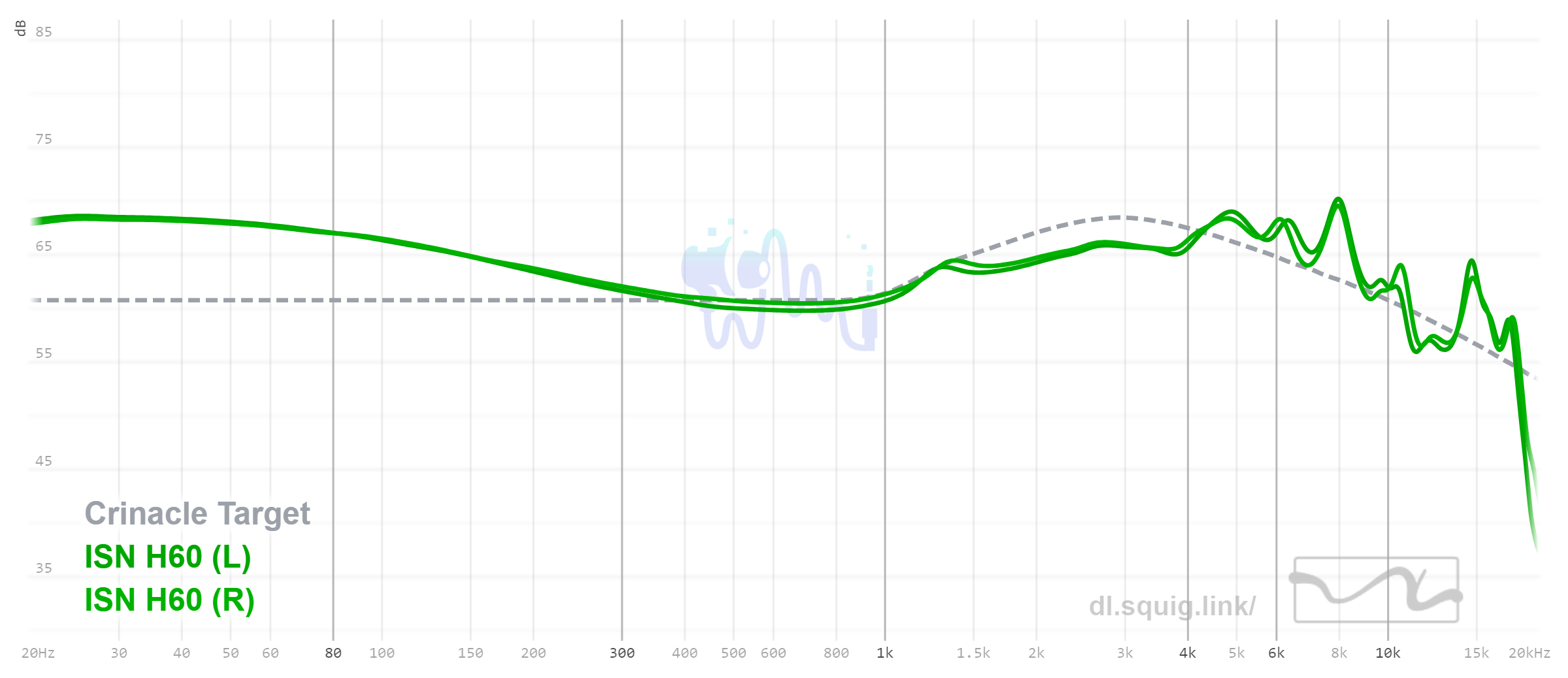
Last edited:










